van Essen en Wim Lafeber, Sanne
Wave-induced current in a seakeeping basin Conference
Proceedings of the ASME 2017 36th International Conference on Ocean, Offshore and Arctic Engineering, OMAE2017, Trondheim, Norway, 2017.
@conference{vanenLafeber2017,
title = {Wave-induced current in a seakeeping basin},
author = {Sanne van Essen en Wim Lafeber},
year = {2017},
date = {2017-06-01},
booktitle = {Proceedings of the ASME 2017 36th International Conference on Ocean, Offshore and Arctic Engineering, OMAE2017, Trondheim, Norway},
pages = {OMAE2017-62203},
abstract = {During tests in MARIN’s wave basins, it was observed that large-scale current patterns may develop under the influence of wave generation and absorption. The velocity of these currents is very low, so they generally do not influence the behaviour of models. However, for specific experiments at low speeds – wave added resistance tests with small models or current drag tests – a residual current may influence the results significantly. Figure 1: Seakeeping and Manoeuvring Basin.
A good understanding of the residual circulation in a wave basin is essential to improve the quality of the tests performed. The wave-induced current patterns were observed during tests in MARIN’s Seakeeping and Manoeuvring Basin (SMB). The patterns may develop in several ways under the influence of waves in a basin. End effects of Stokes drift (mass transport due to second-order wave effects) can play a role, as the water has to return at the end of the basin. The SMB has the capability to generate oblique waves. It therefore has a wave-damping beach along two sides of the basin. Similar to ‘real’ beaches, they may cause alongshore currents and rip currents under the influence of oblique and perpendicular waves respectively. During the tests, floaters in the form of oranges were distributed in the basin after wave generation.
They were tracked using a camera system. The images were processed such that the surface current patterns in the basin were visualized, and an estimate of the velocities was obtained. Additional local acoustic current meter measurements were used to check the order of magnitude of these velocities. Based on these tests, it was concluded that different patterns may occur in the basin, with the largest velocities after oblique wave generation. Typical surface velocities are in the order of 1 to 2 cm/s, non-uniformly distributed over the basin. Due to this non-uniformity and because decay is slow (memory effects), very sensitive added resistance and current drag tests may have to be corrected for a measured current velocity in the future.},
keywords = {},
pubstate = {published},
tppubtype = {conference}
}
A good understanding of the residual circulation in a wave basin is essential to improve the quality of the tests performed. The wave-induced current patterns were observed during tests in MARIN’s Seakeeping and Manoeuvring Basin (SMB). The patterns may develop in several ways under the influence of waves in a basin. End effects of Stokes drift (mass transport due to second-order wave effects) can play a role, as the water has to return at the end of the basin. The SMB has the capability to generate oblique waves. It therefore has a wave-damping beach along two sides of the basin. Similar to ‘real’ beaches, they may cause alongshore currents and rip currents under the influence of oblique and perpendicular waves respectively. During the tests, floaters in the form of oranges were distributed in the basin after wave generation.
They were tracked using a camera system. The images were processed such that the surface current patterns in the basin were visualized, and an estimate of the velocities was obtained. Additional local acoustic current meter measurements were used to check the order of magnitude of these velocities. Based on these tests, it was concluded that different patterns may occur in the basin, with the largest velocities after oblique wave generation. Typical surface velocities are in the order of 1 to 2 cm/s, non-uniformly distributed over the basin. Due to this non-uniformity and because decay is slow (memory effects), very sensitive added resistance and current drag tests may have to be corrected for a measured current velocity in the future.
A.H. Koop, Cozijn; Vaz, G.
Determining Thruster-Hull Interaction for a Drill-Ship Using CFD Conference
OMAE ASME 36th International Conference on Ocean, Offshore and Arctic Engineering, Trondheim, Norway, 2017.
@conference{Koop2017,
title = {Determining Thruster-Hull Interaction for a Drill-Ship Using CFD},
author = {Koop, A.H., Cozijn, H.C., Schrijvers, P. and Vaz, G.},
url = {http://www.marin.nl/web/Publications/Publication-items/Determining-ThrusterHull-Interaction-for-a-DrillShip-Using-CFD.htm},
year = {2017},
date = {2017-06-01},
booktitle = {OMAE ASME 36th International Conference on Ocean, Offshore and Arctic Engineering, Trondheim, Norway},
pages = {OMAE2017-61485},
abstract = {In this paper CFD results are presented for the thruster-hull interaction effects for a drillship with 6 azimuthing thrusters. The results using different approaches to model or simulate the propeller are compared and their advantages and disadvantages are discussed. The approaches investigated are the so-called Frozen Rotor approach, where the propeller rotation is modeled, the Actuator Disk approach with prescribed body forces and the unsteady Sliding Interface approach where the motion of the propeller is simulated in time.
First, open-water calculations for a tilted thruster are carried out using the Frozen Rotor approach. The open-water calculations are repeated using the Actuator Disk prescribing the propeller thrust and torque distribution obtained from the Frozen Rotor calculations. The results with Actuator Disk are very similar for the unit thrust and nozzle thrust compared to the results using the Frozen Rotor approach. Furthermore, the results using the Frozen Rotor or the Actuator Disk are very close to the experimental results for the nozzle thrust.
The thruster-hull interaction of one active thruster under the drillship is investigated using the Actuator Disk approach, the Frozen Rotor Approach and the Sliding Interface approach. A comparison to experimental results is presented for the thruster-hull interaction coefficients. Using the Actuator Disk a good agreement with the experiments is obtained. The results using the Actuator Disk and Sliding Interface are very similar to each other, but the computational costs for the Sliding Interface method are at least a factor 20 higher. The results using the Frozen Rotor deviate due to an unphysical wake behind the thruster.
Based on the results presented in this paper we conclude that, using the steady-state approach with the Actuator Disk, CFD can be a cost-efficient and accurate method to determine the thruster-hull interaction effects at bollard pull conditions for a typical offshore vessel.},
keywords = {},
pubstate = {published},
tppubtype = {conference}
}
First, open-water calculations for a tilted thruster are carried out using the Frozen Rotor approach. The open-water calculations are repeated using the Actuator Disk prescribing the propeller thrust and torque distribution obtained from the Frozen Rotor calculations. The results with Actuator Disk are very similar for the unit thrust and nozzle thrust compared to the results using the Frozen Rotor approach. Furthermore, the results using the Frozen Rotor or the Actuator Disk are very close to the experimental results for the nozzle thrust.
The thruster-hull interaction of one active thruster under the drillship is investigated using the Actuator Disk approach, the Frozen Rotor Approach and the Sliding Interface approach. A comparison to experimental results is presented for the thruster-hull interaction coefficients. Using the Actuator Disk a good agreement with the experiments is obtained. The results using the Actuator Disk and Sliding Interface are very similar to each other, but the computational costs for the Sliding Interface method are at least a factor 20 higher. The results using the Frozen Rotor deviate due to an unphysical wake behind the thruster.
Based on the results presented in this paper we conclude that, using the steady-state approach with the Actuator Disk, CFD can be a cost-efficient and accurate method to determine the thruster-hull interaction effects at bollard pull conditions for a typical offshore vessel.
Guilherme Vaz, Thomas Lloyd; Gnanasundaram, Arun
Improved Modelling Of Sheet Cavitation Dynamics On Delft Twistll Hydrofoil Conference
VII International Conference on Computational Methods in Marine Engineering, 2017.
@conference{Vaz2017,
title = {Improved Modelling Of Sheet Cavitation Dynamics On Delft Twistll Hydrofoil},
author = {Guilherme Vaz, Thomas Lloyd and Arun Gnanasundaram},
url = {http://www.marin.nl/web/Publications/Publication-items/Improved-Modelling-Of-Sheet-Cavitation-Dynamics-On-Delft-Twistll-Hydrofoil.htm},
year = {2017},
date = {2017-05-01},
booktitle = {VII International Conference on Computational Methods in Marine Engineering},
abstract = {In this paper, unsteady viscous-flow cavitation predictions for a 3D hydrofoil are performed using three different approaches: 1) a pure RANS method; 2) a RANS method including an eddy-viscosity “Reboud” correction; 3) a DDES Scale-Resolving-Simulation approach. Both wetted and cavitating flow conditions are analysed and compared with experimental data. The accuracy of these approaches is scrutinised in terms of integral quantities, cavity dynamics, different background principles, and the influence of grid refinement. Low numerical uncertainties have been obtained for wetted flow conditions, but a somewhat large deviation on the wing loading has been observed when compared with experimental results. For the cavitating flow case, the RANS calculations do not accurately simulate the cavity dynamics. The RANSReboud correction improves the fidelity of the calculations at increased numerical demands and decreased robustness. The DDES approach leads to improved dynamics, slightly less accurate cavity shedding mechanism, at lower computational cost. The cavity extents are underpredicted for all methods and conditions used, when compared with the available experimental data.},
keywords = {},
pubstate = {published},
tppubtype = {conference}
}
Thomas P. Scholcz, Christian H. J. Veldhuis
Multi-Objective Surrogate Based Hull-Form Optimization Using High-Fidelity RANS Computations Conference
VII International Conference on Computational Methods in Marine Engineering (MARINE 2017), 2017.
@conference{Scholcz2017,
title = {Multi-Objective Surrogate Based Hull-Form Optimization Using High-Fidelity RANS Computations},
author = {Thomas P. Scholcz, Christian H.J. Veldhuis},
url = {http://www.marin.nl/web/Publications/Publication-items/MultiObjective-Surrogate-Based-HullForm-Optimization-Using-HighFidelity-RANS-Computations.htm},
year = {2017},
date = {2017-05-01},
booktitle = {VII International Conference on Computational Methods in Marine Engineering (MARINE 2017)},
abstract = {RANS-based optimization procedures for ship design become increasingly complex and require the development of more efficient optimization techniques. The four phases of the design procedure are: shape parameterization, global sensitivity analysis, multi-objective optimization and design review. The dimensions of the design space can be mitigated by a smart choice for the shape parameterization and by screening and ranking the design variables in the global sensitivity phase. Subsequently, Surrogate Based Global Optimization (SBGO) is used to reduce the cost of the multi-objective optimization phase. For a practical application it is shown that the computational time reduces from two weeks to only a day when using SBGO instead of applying a Multi-Objective Genetic Algorithm (MOGA) directly to the solver. The design review phase is then used to verify and further develop the optimal design. Here, we focus on automatic ship design techniques which comprises the first three steps of the design procedure. Accelerating the ship design process is subject of ongoing research at the Maritime Research Institute Netherlands, making it useful for practical applications with turnaround times of only a few weeks.},
keywords = {},
pubstate = {published},
tppubtype = {conference}
}
THOMAS LLOYD CARLO NEGRATO, TOM VAN TERWISGA; BENSOW, RICKARD
NUMERICAL STUDY OF CAVITATION ON A NACA0015 HYDROFOIL: SOLUTION VERIFICATION Conference
VII International Conference on Computational Methods in Marine Engineering, 2017.
@conference{NEGRATO2017,
title = {NUMERICAL STUDY OF CAVITATION ON A NACA0015 HYDROFOIL: SOLUTION VERIFICATION},
author = {CARLO NEGRATO, THOMAS LLOYD, TOM VAN TERWISGA, GUILHERME VAZ AND RICKARD BENSOW},
url = {http://www.marin.nl/web/Publications/Publication-items/Numerical-Study-Of-Cavitation-On-A-NACA0015-Hydrofoil-Solution-Verification.htm},
year = {2017},
date = {2017-05-01},
booktitle = {VII International Conference on Computational Methods in Marine Engineering},
abstract = {The present paper analyses a series of Computational Fluid Dynamic simulations of the cavitating flow around a two-dimensional NACA0015 foil. The foil is placed at 6◦ angle of attack and the cavitation number is 1.1. Two mesh designs, namely a block-structured topology and an unstructured topology, are compared; additionally, grid refinements and time step refinements are carried out. Solution Verification is addressed with calculation of the discretization error and the numerical uncertainty. The numerical uncertainty for the average lift coefficient is found to be large, up to 15%. The reason is the difficulty of achieving a grid independent solution: with very fine meshes, the flow shifts from an attached, oscillating sheet cavity pattern to a regime dominated by shedding of cavity clouds. On the other hand, neither the time resolution nor the choice of grid topology influence largely the flow pattern; instead, they only lead to differences in the maximum and minimum cavity size.},
keywords = {},
pubstate = {published},
tppubtype = {conference}
}
Ana Lu´ısa Rocha, Lu´ıs E¸ca; Vaz, Guilherme
VII International Conference on Computational Methods in Marine Engineering, 2017.
@conference{Rocha2017,
title = {ON THE NUMERICAL CONVERGENCE PROPERTIES OF THE CALCULATION OF THE FLOW AROUND THE KVLCC2 TANKER IN UNSTRUCTURED GRIDS},
author = {Ana Lu´ısa Rocha, Lu´ıs E¸ca and Guilherme Vaz},
url = {http://www.marin.nl/web/Publications/Publication-items/On-The-Numerical-Convergence-Properties-Of-The-Calculation-Of-The-Flow-Around-The-KVLCC2-Tanker-In-Unstructured-Grids.htm},
year = {2017},
date = {2017-05-01},
booktitle = {VII International Conference on Computational Methods in Marine Engineering},
abstract = {This paper addresses the estimation of numerical errors in the calculation of the flow around the KVLCC2 tanker at model scale Reynolds number in unstructured grids. The flow solution is based on the Reynolds-Averaged Navier-Stokes equations supplemented by the k − ω SST two-equation eddy-viscosity model using the so-called double-body approach, i.e. free surface effects are neglected. Grid refinement studies are performed for sets of grids generated with the open source code SnappyHexMesh and with the HEXPRESSTM grid generator. Definition of grid refinement ratio in unstructured grids and its consequences for the estimation of numerical errors is discussed. Friction and pressure resistance coefficients and mean velocity components at the propeller plane are compared with reference solutions obtained in nearly-orthogonal multi-block structured grids with the same flow solver ReFRESCO.},
keywords = {},
pubstate = {published},
tppubtype = {conference}
}
G. Vaz, F. S. Pereira; E¸ca, L.
ON THE PREDICTION OF SHEAR-LAYER FLOWS WITH RANS AND SRS MODELS Conference
VII International Conference on Computational Methods in Marine Engineering, 2017.
@conference{Vaz2017b,
title = {ON THE PREDICTION OF SHEAR-LAYER FLOWS WITH RANS AND SRS MODELS},
author = {G. Vaz, F.S. Pereira and L. E¸ca},
url = {http://www.marin.nl/web/Publications/Publication-items/On-The-Prediction-Of-ShearLayer-Flows-With-RANS-And-SRS-Models.htm},
year = {2017},
date = {2017-05-01},
booktitle = {VII International Conference on Computational Methods in Marine Engineering},
abstract = {This study evaluates the ability of Reynolds-Averaged Navier-Stokes (RANS) and Scale-Resolving Simulations (SRS) models to predict turbulent shear-layer predominant (blunt-body) flows. The selected cases are the flows around a circular cylinder at Re = 3, 900 and 140, 000, and past a rounded square prism at Re = 100, 000 and incidence angles of 0 and 45 degrees. These cases exhibit complex features making numerical predictions a challenge, in particular, for turbulence modelling: shear-layers (free, boundary and wake), laminar-turbulent transition, low to moderate Reynolds numbers, flow separation and unsteadiness. In this pa-per, the aforementioned cases are simulated employing isotropic and anisotropic RANS, De-layed Detached-Eddy Simulation (DDES), eXtra Large-Eddy Simulation (XLES), and Partially-Averaged Navier-Stokes (PANS) equations. The outcome confirms that traditional isotropic RANS are unable to accurately predict such flows, whereas SRS models can significantly reduce modelling errors. Furthermore, the results show that anisotropic RANS models are an inter-esting engineering option owing to its compromise between accuracy and cost. Nonetheless, an improvement of the modelling accuracy by both anisotropic RANS and SRS models is inevitably coupled with an increase of the numerical demands.},
keywords = {},
pubstate = {published},
tppubtype = {conference}
}
G. Vaz J. Hawkes, A. B. Phillips
On the strong scalability of maritime CFD Journal Article
In: Journal of Marine Science and Technology, no. DOI: 10.1007/s00773-017-0457-7, 2017.
@article{Hawkes2017,
title = {On the strong scalability of maritime CFD},
author = {J. Hawkes, G. Vaz, A. B. Phillips, S. J. Cox, S. R. Turnock},
url = {http://www.marin.nl/web/Publications/Publication-items/On-the-strong-scalability-of-maritime-CFD.htm},
year = {2017},
date = {2017-05-01},
booktitle = {Journal of Marine Science and Technology},
journal = {Journal of Marine Science and Technology},
number = {DOI: 10.1007/s00773-017-0457-7},
abstract = {Since 2004, supercomputer growth has been constrained by energy efficiency rather than raw hardware speeds. To maintain exponential growth of overall computing power, a massive growth in parallelization is under way. To keep up with these changes, computational fluid dynamics (CFD) must improve its strong scalability—its ability to handle lower cells-per-core ratios and achieve finer-grain parallelization. A maritime-focused, unstructured, finite-volume code (ReFRESCO) is used to investigate the scalability problems for incompressible, viscous CFD using two classical test-cases. Existing research suggests that the linear equation-system solver is the main bottleneck to incompressible codes, due to the stiff Poisson pressure equation. Here, these results are expanded by analysing the reasons for this poor scalability. In particular, a number of alternative linear solvers and preconditioners are tested to determine if the scalability problem can be circumvented, including GMRES, Pipelined-GMRES, Flexible-GMRES and BCGS. Conventional block-wise preconditioners are tested, along with multi-grid preconditioners and smoothers in various configurations. Memory-bandwidth constraints and global communication patterns are found to be the main bottleneck, and no stateof-the-art solution techniques which solve the strong-scalability problem satisfactorily could be found. There is significant incentive for more research and development in this area.},
keywords = {},
pubstate = {published},
tppubtype = {article}
}
A.R. Starke, Drakopoulos; Turnock, S. R.
VII International Conference on Computational Methods in Marine Engineering (MARINE2017), 2017.
@conference{Starke2017,
title = {RANS-based full-scale power predictions for a general cargo vessel, and comparison with sea-trial results},
author = {Starke, A.R., Drakopoulos, K., Toxopeus, S.L. and Turnock, S.R.},
url = {http://www.marin.nl/web/Publications/Publication-items/RANSbased-fullscale-power-predictions-for-a-general-cargo-vessel-and-comparison-with-seatrial-results.htm},
year = {2017},
date = {2017-05-01},
booktitle = {VII International Conference on Computational Methods in Marine Engineering (MARINE2017)},
abstract = {Blind self-propulsion predictions for the 2016 LR Workshop on Ship Scale Hydrodynamic Computer Simulation have been carried out to simulate the full scale performance of a self-propelled ship in ballast. The single screw ship of 11542 tonnes had been scanned in drydock so the computational model used the actual as operated hull form. It will be shown that using a hybrid RANS-BEM method, the predicted ship speeds at selfpropulsion are over-estimated by 0.17-0.28 knots compared to the trial data. The various aspects that influence the accuracy of the direct prediction of power and RPM using CFD are critically discussed.},
keywords = {},
pubstate = {published},
tppubtype = {conference}
}
Crepier, P.
Ship Resistance Prediction: Verification And Validation Exercise On Unstructured Grids Conference
VII International Conference on Computational Methods in Marine Engineering (MARINE2017), 2017.
@conference{Crepier2017,
title = {Ship Resistance Prediction: Verification And Validation Exercise On Unstructured Grids},
author = {Crepier, P.},
url = {http://www.marin.nl/web/Publications/Publication-items/Ship-Resistance-Prediction-Verification-And-Validation-Exercise-On-Unstructured-Grids.htm},
year = {2017},
date = {2017-05-01},
booktitle = {VII International Conference on Computational Methods in Marine Engineering (MARINE2017)},
abstract = {The prediction of the resistance of a ship is, together with the propeller performance prediction, part of the key aspects during the design process of a ship, as it partly ensures the quality of the power-prediction. Body fitted structured grids for ship simulations can be rather challenging and time consuming to build, especially when dealing with appended ship geometries. For this reason, unstructured hexahedral trimmed grids are more and more used. Such grids can be build by various CFD package such as CD-Adapcos Star CCM+, NUMECAs Hexpress grid generator or OpenFOAMSs SnappyHexMesh. Although their use is increasing or even already adopted, the numerical uncertainty of these simulations seems to be a well-kept secret.
In the study presented, an attempt at quantifying the numerical uncertainty of the resistance for the combination of the RANS Solver ReFRESCO [1] with grids generated using the commercial package Hexpress is made. The studied case is the flow around the bare-hull KVLCC2 at model scale Reynolds number. Extensive verification and validation on the same test case has already been published for the combination of ReFRESCO and structured grids by Pereira et al. [2].
The method to generate grids as geometrically similar as possible is presented, and the uncertainty analysis by L. Ec¸a and M. Hoekstra [3] is performed on the integral results obtained.
The simulations are performed using the k − ω SST, k − ω TNT and the k −√kL turbulence models. The velocity fields calculated in the propeller plane are compared to the measured ones and to the results obtained by Pereira et al. [2] on structured grids.
The results show that the differences with the experimental results are in the same range as the differences obtained with structured grids. The numerical uncertainties are, however, higher. They are also strongly dependent on the turbulence model used, like for structured grids, and are spread between 1.3% and 12%.
Concerning the wake flow details, not all features present in the experimental results are obtained and, compared to structured grids, the flow features are smoothed. The wake flow is also influenced by the turbulence modelling and needs to be adressed in more detail.},
keywords = {},
pubstate = {published},
tppubtype = {conference}
}
In the study presented, an attempt at quantifying the numerical uncertainty of the resistance for the combination of the RANS Solver ReFRESCO [1] with grids generated using the commercial package Hexpress is made. The studied case is the flow around the bare-hull KVLCC2 at model scale Reynolds number. Extensive verification and validation on the same test case has already been published for the combination of ReFRESCO and structured grids by Pereira et al. [2].
The method to generate grids as geometrically similar as possible is presented, and the uncertainty analysis by L. Ec¸a and M. Hoekstra [3] is performed on the integral results obtained.
The simulations are performed using the k − ω SST, k − ω TNT and the k −√kL turbulence models. The velocity fields calculated in the propeller plane are compared to the measured ones and to the results obtained by Pereira et al. [2] on structured grids.
The results show that the differences with the experimental results are in the same range as the differences obtained with structured grids. The numerical uncertainties are, however, higher. They are also strongly dependent on the turbulence model used, like for structured grids, and are spread between 1.3% and 12%.
Concerning the wake flow details, not all features present in the experimental results are obtained and, compared to structured grids, the flow features are smoothed. The wake flow is also influenced by the turbulence modelling and needs to be adressed in more detail.
Raven, H. C.; Scholcz, T. P.
Wave Resistance Minimisation In Practical Ship Design Conference
VII International Conference on Computational Methods in Marine Engineering (MARINE2017), Nantes, France, 2017.
@conference{Raven2017,
title = {Wave Resistance Minimisation In Practical Ship Design},
author = {Raven, H.C. and Scholcz, T.P.},
url = {http://www.marin.nl/web/Publications/Publication-items/Wave-Resistance-Minimisation-In-Practical-Ship-Design.htm},
year = {2017},
date = {2017-05-01},
booktitle = {VII International Conference on Computational Methods in Marine Engineering (MARINE2017), Nantes, France},
pages = {131-142},
abstract = {A practical and efficient system is described for ship hull form optimisation and its application for minimising wave resistance. Parametric hull form deformations are defined in a CAD system, specific for the case considered and related with flow aspects to be addressed. Surrogate-based global optimisation is applied for multiobjective problems, such as optimisation for a ship’s operational profile. },
keywords = {},
pubstate = {published},
tppubtype = {conference}
}
C.M. Klaij, He; Vuik, C.
On The Design Of Block Preconditioners For Maritime Engineering Conference
VII International Conference on Computational Methods in Marine Engineering (MARINE2017), Nantes, France, 2017.
@conference{Klaij2017,
title = {On The Design Of Block Preconditioners For Maritime Engineering},
author = {Klaij, C.M., He, X. and Vuik, C.},
url = {http://www.marin.nl/web/Publications/Publication-items/On-The-Design-Of-Block-Preconditioners-For-Maritime-Engineering.htm},
year = {2017},
date = {2017-05-01},
booktitle = {VII International Conference on Computational Methods in Marine Engineering (MARINE2017), Nantes, France},
pages = {893-904},
abstract = {The iterative error can be an important part of the total numerical error of any Computational Fluid Dynamics simulation when the iterative convergence stagnates or when loose convergence criteria are used. In the quest for better iterative convergence of CFD simulations, we consider the design of iterative methods for the Reynolds-averaged Navier-Stokes equations, discretized by finite-volume methods with cell-centered, co-located variables. The central point is the approximation of the Schur complement (pressure matrix) in the block factorization of the discrete system of mass and momentum equations. We show particular approximations of these blocks that yield either segregated solvers or block preconditioners for fully coupled solvers. The performance of these solvers are then demonstrated by computing the flow over a flat plate and around a tanker on both structured and unstructured grids. We find that iterative convergence to machine precision is attainable despite the high Reynolds numbers and mesh aspect ratio's. Improved approximations of the Schur complement do result in improved convergence rates, but do not seem to pay-off in terms of total cost compared to the basic SIMPLE-type approximation.},
keywords = {},
pubstate = {published},
tppubtype = {conference}
}
Lafeber, Frans Hendrik; Lloyd, Thomas
Round Robin test on the underwater radiated noise of a cavitating ship propeller in open water Conference
The 5th international conference on advanced model measurements technology (AMT '17) 11/13-10-2017, 2017.
@conference{Lafeber2017,
title = {Round Robin test on the underwater radiated noise of a cavitating ship propeller in open water},
author = {Frans Hendrik Lafeber and Thomas Lloyd},
url = {http://www.marin.nl/web/Publications/Publication-items/Round-Robin-test-on-the-underwater-radiated-noise-of-a-cavitating-ship-propeller-in-open-water.htm},
year = {2017},
date = {2017-01-11},
booktitle = {The 5th international conference on advanced model measurements technology (AMT '17) 11/13-10-2017},
abstract = {Due to concerns about its effect on marine life, shipping noise is receiving increasing attention within the maritime industry. The primary noise source is known to be the cavitating propeller. In order to check compliance with class rules and upcoming environmental regulations, underwater radiated noise can be predicted during the design of a vessel using model-scale measurements, such as those performed at MARIN’s Depressurized Wave Basin. As a means to better understand the accuracy and reliability of underwater radiated noise measurements, a round robin test campaign was organised within the Community-of-Practice Noise of the HydroTesting Forum, with the aim of comparing results between several institutes for an open water propeller test setup. This paper reports the test campaign carried out at MARIN, including details of the experimental setup, data analysis methods and resulting noise levels. Noise was measured using a hydrophone fixed on a bottom-mounted mast, with a dedicated silent towing carriage used to minimise background noise. The effect of applying electrolysis as a means to improve cavitation inception was investigated, and found to be more important for high cavitation numbers. Differences in the radiated noise levels between different test conditions were found to depend largely on the dynamics of the cavitating tip vortex. In general a primary broadband hump was seen, the frequency of which is affected by propeller loading and cavitation number. The spectral shape at higher frequencies could not so easily be related to a clear physical origin however. Following further data analysis, the results will be compared to those from the other participants in the round robin test campaign.},
keywords = {},
pubstate = {published},
tppubtype = {conference}
}
F.S. Pereira, Eça; Vaz, G.
Verification and Validation exercises for the flow around the KVLCC2 tanker at model and full-scale Reynolds numbers Journal Article
In: Ocean Engineering, vol. 129, no. DOI: 10.1016/j.oceaneng.2016.11.005, pp. 133-148, 2017.
@article{Pereira2017,
title = {Verification and Validation exercises for the flow around the KVLCC2 tanker at model and full-scale Reynolds numbers},
author = {Pereira, F.S., Eça, L. and Vaz, G.},
url = {http://www.marin.nl/web/Publications/Publication-items/Verification-and-Validation-exercises-for-the-flow-around-the-KVLCC2-tanker-at-model-and-fullscale-Reynolds-numbers.htm},
year = {2017},
date = {2017-01-02},
booktitle = {Ocean Engineering},
journal = {Ocean Engineering},
volume = {129},
number = {DOI: 10.1016/j.oceaneng.2016.11.005},
pages = {133-148},
abstract = {This paper presents the quantification of numerical and modelling errors for the solution of the flow around the KVLCC2 tanker at model-scale Reynolds number. Numerical errors are also quantified for full-scale Reynolds number simulations to address the numerical accuracy of the prediction of scale-effects. The calculations are performed with the solver ReFRESCO using fourteen distinct Reynolds-Averaged Navier-Stokes (RANS) equations models. The quantities of interest for the Validation exercises at model-scale are the resistance coefficient and the velocity and turbulence kinetic energy fields at the propeller plane. Modelling errors are estimated using the ASME V & V20 procedure which requires numerical and experimental data with their respective uncertainties. Numerical uncertainties are dominated by the contribution of the discretization error, which is determined by grid refinement studies. Scale-effects are also assessed for the wake-fraction and formfactor. The outcome shows that quantifying modelling errors is not a trivial exercise that depends on the quality and details of simulations and experiments. Nonetheless, it is also evident that a quantitative evaluation of modelling errors is more reliable than traditional graphical comparisons of simulations and experiments. Fullscale results show scale-effects larger than numerical uncertainties that are illustrated for the form-factor and wake-fraction.},
keywords = {},
pubstate = {published},
tppubtype = {article}
}
Quadvlieg, F. H. H. A.
Yücel Odabaşı Colloquium Series - 2nd International Meeting Recent Advances in Prediction Techniques for Safe Manoeuvring of Ships and Submarines, Istanbul, Turkey, 2016.
@conference{Quadvlieg2016,
title = {Current status of manoeuvring prediction methods, their mutual pros and cons and ways to quantify the capabilities},
author = {Quadvlieg, F.H.H.A.},
url = {http://www.marin.nl/web/Publications/Papers/Current-status-of-manoeuvring-prediction-methods-their-mutual-pros-and-cons-and-ways-to-quantify-the-capabilities.htm},
year = {2016},
date = {2016-11-17},
booktitle = {Yücel Odabaşı Colloquium Series - 2nd International Meeting Recent Advances in Prediction Techniques for Safe Manoeuvring of Ships and Submarines, Istanbul, Turkey},
abstract = {In the paper, we make an overview of prediction techniques and some of the developments in the last years. This is done from the viewpoint of the author: as user of every technique in his daily work, and as observed of ITTC common techniques. Finally, various attempts have been made to quantify the accuracy of each prediction method. Among others the SIMMAN workshops for surface ships enabled to make an overview on the maturing of new prediction techniques.},
keywords = {},
pubstate = {published},
tppubtype = {conference}
}
Jie; Chen Dang, Hao
The Second Conference of Global Chinese Scholars on Hydrodynamics, CCSH'2016, 2016.
@conference{Dang2016,
title = {Energy Saving by Using Asymmetric Aftbodies for Merchant Ships – Design Methodology, Numerical Simulation and Validation},
author = {Dang, Jie; Chen, Hao},
url = {http://www.marin.nl/web/Publications/Papers/Energy-Saving-by-Using-Asymmetric-Aftbodies-for-Merchant-Ships-Design-Methodology-Numerical-Simulation-and-Validation.htm },
year = {2016},
date = {2016-11-11},
booktitle = {The Second Conference of Global Chinese Scholars on Hydrodynamics},
publisher = {CCSH'2016},
abstract = {The methodology and procedures are discussed on designing merchant ships to achieve fully-integrated and optimized hull-propulsion systems by using asymmetric aftbodies. Computational Fluid Dynamics (CFD) has been used to evaluate the powering performance through massive calculations with automatic deformation algorisms for the hull forms and the propeller blades. Comparative model tests of the designs to the optimized symmetric hull forms have been carried out to verify the efficiency gain. More than 6% improvement on the propulsive efficiency of an oil tanker has been measured during the model tests. Dedicated sea-trials show good agreement with the predicted performance from the test results.},
keywords = {},
pubstate = {published},
tppubtype = {conference}
}
Eggers, Rogier
Operational Performance of Wind Assisted Ships Conference
10th Symposium on High-Performance Marine Vehicles (HIPER), Cortona, Italy, 2016.
@conference{Eggers2016,
title = {Operational Performance of Wind Assisted Ships},
author = {Eggers, Rogier},
url = {http://www.marin.nl/web/Publications/Papers/Operational-Performance-of-Wind-Assisted-Ships.htm},
year = {2016},
date = {2016-10-17},
booktitle = {10th Symposium on High-Performance Marine Vehicles (HIPER), Cortona, Italy},
pages = {366-379},
abstract = {The „Wind Hybrid Coaster“ was a sub project in MARITIM (2016) under the European INTERREG Deutschland-Nederland programme within which Dutch and German partners from the maritime industry and research institutions were developing a new type of “green” coastal ship equipped with a wind assisted hybrid propulsion system. MARIN was asked to predict the performance of the Wind Hybrid Coaster in a realistic operational scenario. For this purpose MARIN conducted a large number of hydrodynamic model tests, powering predictions in calm water including wind assistance
and finally voyage simulations for multiple routes including voyage optimisation.},
keywords = {},
pubstate = {published},
tppubtype = {conference}
}
and finally voyage simulations for multiple routes including voyage optimisation.
A. van der Ploeg, Bles; Zelderen, J. van
Optimization of a ship with a large diameter propeller Conference
19th Numerical Towing Tank Symposium (NuTTS), St. Pierre d'Oléron, France, 2016, 2016.
@conference{Ploeg2016,
title = {Optimization of a ship with a large diameter propeller},
author = {Ploeg, A. van der, Bles, G. van der, and Zelderen, J. van},
url = {http://www.marin.nl/web/Publications/Papers/Optimization-of-a-ship-with-a-large-diameter-propeller.htm},
year = {2016},
date = {2016-10-01},
booktitle = {19th Numerical Towing Tank Symposium (NuTTS), St. Pierre d'Oléron, France, 2016},
pages = {102-107},
abstract = {From several studies in the past it has been demonstrated that the fuel consumption of a ship can be decreased by enlarging the propeller and reducing its rotation rate. One of the work packages in the EU project "LeanShips" aims to integrate the design of the aft ship and a large area propeller. As a test case and demonstrator, we consider a container ship in which the propeller diameter was enlarged from 5.85m to 7.00m.
It is expected that the increase of the propeller diameter decreases the required power by approximately 4%. A further decrease is expected from a combined optimization of the aft part of the hull and the propeller. In this paper, we focus on the method that can be used to optimize the hull form, in which candidate hull forms will be evaluated by full-scale RANS-computations.},
keywords = {},
pubstate = {published},
tppubtype = {conference}
}
It is expected that the increase of the propeller diameter decreases the required power by approximately 4%. A further decrease is expected from a combined optimization of the aft part of the hull and the propeller. In this paper, we focus on the method that can be used to optimize the hull form, in which candidate hull forms will be evaluated by full-scale RANS-computations.
Christian; Gornicz Veldhuis, Tomasz; Scholcz
13th International Symposium on Practical Design of Ships (PRADS), Copenhagen, Denmark, no. ID080, Practical Design of Ships and Other Floating Structures 2016.
@conference{Veldhuis2016,
title = {Ship optimization using viscous flow computations in combination with generic shape variations and Design of Experiments},
author = {Veldhuis, Christian; Gornicz, Tomasz; Scholcz, Thomas},
url = {http://www.marin.nl/web/Publications/Papers/Ship-optimization-using-viscous-flow-computations-in-combination-with-generic-shape-variations-and-Design-of-Experiments.htm},
year = {2016},
date = {2016-09-04},
booktitle = {13th International Symposium on Practical Design of Ships (PRADS), Copenhagen, Denmark},
journal = {Proceedings of PRADS2016 4th – 8th September, 2016 Copenhagen, Denmark},
number = {ID080},
organization = {Practical Design of Ships and Other Floating Structures},
abstract = {This paper discusses a procedure to optimize ship hull forms for minimum required power and best wake field quality, based on viscous flow computations. This research elaborates on an earlier optimization at MARIN (Van der Ploeg and Raven, 2010 and Van der Ploeg, Starke and Veldhuis, 2013). That optimization lead to a clear Pareto front and trends for a systematic variation study for the afterbody of a chemical tanker. In 2016, new steps are taken to ease and generalize the method of hull shape generation. In the previous study the design space was set up by means of ‘manually’ designed basis hull shapes. In the new approach we test the use of generic basis hull shapes which are automatically generated from one initial hull shape. If effective, this approach can speed up the design process significantly. Finally, we want to improve the process even further by using a Design of Exper-iments approach in which the systematic variations are re-placed by a more clever distribution of calculations over the design space. },
keywords = {},
pubstate = {published},
tppubtype = {conference}
}
Gert-Jan; Hooijmans Zondervan, Patrick; Hagesteijn
Design of research vessels; propeller cavitation and bubble sweep down in operational conditions Conference
Proceedings of PRADS2016, 4th – 8th September, 2016, Copenhagen, Denmark, 2016.
@conference{Zondervan2016,
title = {Design of research vessels; propeller cavitation and bubble sweep down in operational conditions},
author = {Zondervan, Gert-Jan; Hooijmans, Patrick; Hagesteijn, Gerco; Huisman, Teunis},
url = {http://www.marin.nl/web/Publications/Papers/Design-of-research-vessels-propeller-cavitation-and-bubble-sweep-down-in-operational-conditions.htm},
year = {2016},
date = {2016-09-04},
booktitle = {Proceedings of PRADS2016, 4th – 8th September, 2016, Copenhagen, Denmark},
abstract = {A critical aspect in the operation of special purpose research vessels is the interference by the flow over the hull and propel-lers with acoustic sensors. Low noise propellers are designed for these vessels that have delayed cavitation inception char-acteristics allowing the propeller to operate free of cavitation for a specified operational speed range. These propellers are often designed and tested on model scale for ideal trial condi-tions. In reality, however, the low noise characteristics of the ship and propellers are substantially influenced by the opera-tional conditions that the ship experiences. Serious downtime is for example to be experienced when the sonar equipment is disturbed by air bubbles.
In this paper first an overview and discussion is made on the approach in low noise propeller design and the effect of oper-ational conditions on the design. It is further shown how model tests in waves carried out in a depressurized towing tank provide valuable insight in the performance of the pro-pellers in operational conditions. Furthermore, other typical issues such as bubble sweep down as a source of malfunction-ing of the echo sounders can be investigated.},
keywords = {},
pubstate = {published},
tppubtype = {conference}
}
In this paper first an overview and discussion is made on the approach in low noise propeller design and the effect of oper-ational conditions on the design. It is further shown how model tests in waves carried out in a depressurized towing tank provide valuable insight in the performance of the pro-pellers in operational conditions. Furthermore, other typical issues such as bubble sweep down as a source of malfunction-ing of the echo sounders can be investigated.
2016
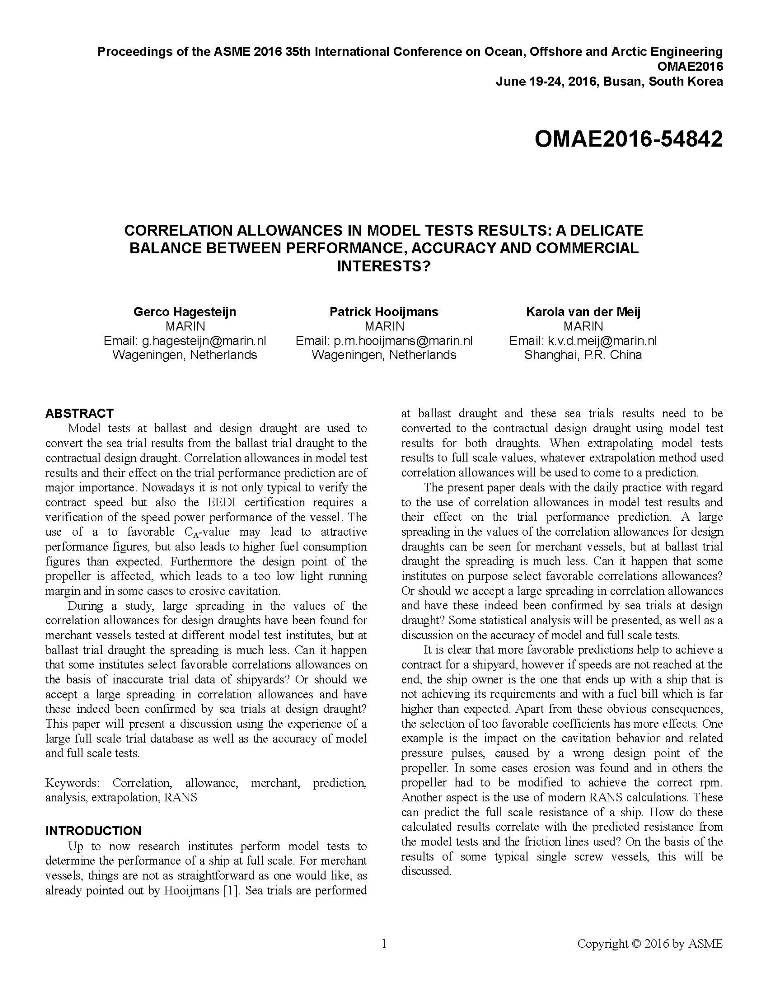
Gerco; Hooijmans Hagesteijn, Patrick; van der Meij
Proceedings of the ASME 2016 35th International Conference on Ocean, Offshore and Arctic Engineering, OMAE2016, Busan, South Korea, 2016.
Abstract | Links | BibTeX | Tags: allowance, analysis, correlation, extrapolation, merchant, prediction, RANS
@conference{Hagesteijn2016,
title = {Correlation allowances in model tests results: A delicate balance between performance, accuracy and commercial interests?},
author = {Hagesteijn, Gerco; Hooijmans, Patrick; van der Meij, Karola},
url = {http://www.marin.nl/web/Publications/Papers/Correlation-allowances-in-model-tests-results-A-delicate-balance-between-performance-accuracy-and-commercial-interests.htm},
year = {2016},
date = {2016-06-19},
booktitle = {Proceedings of the ASME 2016 35th International Conference on Ocean, Offshore and Arctic Engineering, OMAE2016, Busan, South Korea},
abstract = {Model tests at ballast and design draught are used to
convert the sea trial results from the ballast trial draught to the
contractual design draught. Correlation allowances in model test
results and their effect on the trial performance prediction are of
major importance. Nowadays it is not only typical to verify the
contract speed but also the EEDI certification requires a
verification of the speed power performance of the vessel. The
use of a to favorable CA-value may lead to attractive
performance figures, but also leads to higher fuel consumption
figures than expected. Furthermore the design point of the
propeller is affected, which leads to a too low light running
margin and in some cases to erosive cavitation.
During a study, large spreading in the values of the
correlation allowances for design draughts have been found for
merchant vessels tested at different model test institutes, but at
ballast trial draught the spreading is much less. Can it happen
that some institutes select favorable correlations allowances on
the basis of inaccurate trial data of shipyards? Or should we
accept a large spreading in correlation allowances and have
these indeed been confirmed by sea trials at design draught?
This paper will present a discussion using the experience of a
large full scale trial database as well as the accuracy of model
and full scale tests.},
keywords = {allowance, analysis, correlation, extrapolation, merchant, prediction, RANS},
pubstate = {published},
tppubtype = {conference}
}
convert the sea trial results from the ballast trial draught to the
contractual design draught. Correlation allowances in model test
results and their effect on the trial performance prediction are of
major importance. Nowadays it is not only typical to verify the
contract speed but also the EEDI certification requires a
verification of the speed power performance of the vessel. The
use of a to favorable CA-value may lead to attractive
performance figures, but also leads to higher fuel consumption
figures than expected. Furthermore the design point of the
propeller is affected, which leads to a too low light running
margin and in some cases to erosive cavitation.
During a study, large spreading in the values of the
correlation allowances for design draughts have been found for
merchant vessels tested at different model test institutes, but at
ballast trial draught the spreading is much less. Can it happen
that some institutes select favorable correlations allowances on
the basis of inaccurate trial data of shipyards? Or should we
accept a large spreading in correlation allowances and have
these indeed been confirmed by sea trials at design draught?
This paper will present a discussion using the experience of a
large full scale trial database as well as the accuracy of model
and full scale tests.
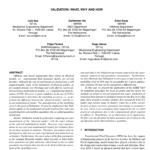
L. Eça, Vaz; Abreu, H.
Validation: What, Why And How Conference
OMAE ASME 35th International Conference on Ocean, Offshore and Arctic Engineering, Busan, South Korea, 2016.
Abstract | Links | BibTeX | Tags: a circular cylinder, a flat plate, CFD, EFD, KVLCC2, LNG carrier, Validation
@conference{Eça2016,
title = {Validation: What, Why And How},
author = {Eça, L., Vaz, G., Koop, A., Pereira, F. and Abreu, H.},
url = {http://www.marin.nl/web/Publications/Papers/Validation-What-Why-And-How.htm},
year = {2016},
date = {2016-06-19},
booktitle = {OMAE ASME 35th International Conference on Ocean, Offshore and Arctic Engineering, Busan, South Korea},
pages = {OMAE2016-54005},
abstract = {Offshore and Naval engineering have relied on physical models, i.e. experimental fluid dynamics (EFD), for several decades. Although the role of experiments in engineering is still unquestionable, some of the limitations of physical models, as for example domain size (blockage and scale effects), can be addressed using mathematical models, i.e. computational fluid dynamics (CFD). However, to gain confidence in the use of CFD it is fundamental to determine the modelling accuracy, i.e. to determine the difference between the “physical reality” and the selected mathematical model. The quantification of the modelling error is the goal of Validation. It must be emphasized that Validation applies to the mathematical model (and not the code) and is performed for selected flow quantities (the so-called quantities of interest).
Ideally, Validation would be performed comparing an exact measurement of the “physical reality” with the exact solution of the selected mathematical model. However, exact measurements do not exist and mathematical models for turbulent flows do not have analytical solutions. Therefore, procedures must be developed to take into account experimental and numerical uncertainties. Furthermore, the exact values of the flow parameters as for example Reynolds number, fluid viscosity or inlet turbulence quantities are often unknown, which leads to the so-called parameter uncertainty that also has to be dealt within the assessment of the modelling error.
The main goal of this paper is to demonstrate that the very popular designation of ”code X is validated” is meaningless without saying what is the mathematical model embedded in the code, what are the quantities of interest for the specific application and what is the Validation uncertainty imposed by the experimental, numerical and parameter uncertainties. Furthermore, we also illustrate that Validation is not a pass or fail exercise. A modelling error of 10% may be acceptable for a given application, whereas 1% may not be enough for a different one.
To this end, we present the application of the ASME V&V 20 Validation procedure for local set points and the metric for multiple set points to several practical test cases: prediction of transition from laminar to turbulent regime for the flow over a flat plate; flow around a circular cylinder; flow around the KVLCC2 tanker and current loads in shallow water for a LNG carrier. In most of these exercises, parameter uncertainty is assumed to be zero, which is an assumption often required for the so-called practical calculations due to the computational effort required to address it. Nonetheless, as an illustration of its application, the flow over the flat plate includes parameter uncertainty for the specification of the inlet turbulence quantities.},
keywords = {a circular cylinder, a flat plate, CFD, EFD, KVLCC2, LNG carrier, Validation},
pubstate = {published},
tppubtype = {conference}
}
Ideally, Validation would be performed comparing an exact measurement of the “physical reality” with the exact solution of the selected mathematical model. However, exact measurements do not exist and mathematical models for turbulent flows do not have analytical solutions. Therefore, procedures must be developed to take into account experimental and numerical uncertainties. Furthermore, the exact values of the flow parameters as for example Reynolds number, fluid viscosity or inlet turbulence quantities are often unknown, which leads to the so-called parameter uncertainty that also has to be dealt within the assessment of the modelling error.
The main goal of this paper is to demonstrate that the very popular designation of ”code X is validated” is meaningless without saying what is the mathematical model embedded in the code, what are the quantities of interest for the specific application and what is the Validation uncertainty imposed by the experimental, numerical and parameter uncertainties. Furthermore, we also illustrate that Validation is not a pass or fail exercise. A modelling error of 10% may be acceptable for a given application, whereas 1% may not be enough for a different one.
To this end, we present the application of the ASME V&V 20 Validation procedure for local set points and the metric for multiple set points to several practical test cases: prediction of transition from laminar to turbulent regime for the flow over a flat plate; flow around a circular cylinder; flow around the KVLCC2 tanker and current loads in shallow water for a LNG carrier. In most of these exercises, parameter uncertainty is assumed to be zero, which is an assumption often required for the so-called practical calculations due to the computational effort required to address it. Nonetheless, as an illustration of its application, the flow over the flat plate includes parameter uncertainty for the specification of the inlet turbulence quantities.
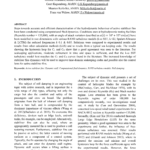
G. Fernandes, Kapsenberg; Walree, F. van
Towards Accurate Computations of Active Stabiliser Fins, focusing on Dynamic Stall Conference
15th International Ship Stability Workshop, Stockholm, Sweden, 2016.
Abstract | Links | BibTeX | Tags: Active stabiliser fins, Computational fluid dynamics, Dynamic stall, RANS turbulence models, Roll damping
@conference{Fernandes2016,
title = {Towards Accurate Computations of Active Stabiliser Fins, focusing on Dynamic Stall},
author = {Fernandes, G., Kapsenberg, G.K., Kerkvliet, M. and Walree, F. van},
url = {http://www.marin.nl/web/Publications/Papers/Towards-Accurate-Computations-of-Active-Stabiliser-Fins-focusing-on-Dynamic-Stall.htm},
year = {2016},
date = {2016-06-13},
booktitle = {15th International Ship Stability Workshop, Stockholm, Sweden},
abstract = {Steps towards accurate and efficient characterisation of the hydrodynamic behaviour of active stabiliser fins have been conducted using computational fluid dynamics. Conditions seen at hydrodynamic testing facilities (Reynolds number = 135,000), with an angle of attack variation described as alpha(t) = 10 deg + 15 deg * sin(omega*t) have been modelled in two dimensions with various RANS turbulence models (k-omega SST, kskl, Spalart-Allmaras & LCTM) for reduced frequencies k=0.1 & 0.05. Solutions were compared to experimental results and results from other calculation methods (LES) and to results from a typical sea keeping code. The results showing the hysteresis loop for CL and CD show that a good agreement was seen to the literature. For seakeeping applications, moderate refinement in time and space is sufficient, and that the k-omega SST turbulence model best matches the CL and CD curves found in the literature. The increased knowledge of stabiliser fins dynamics will be used to improve time-domain seakeeping codes and possible also the control laws for active stabilizer fins},
keywords = {Active stabiliser fins, Computational fluid dynamics, Dynamic stall, RANS turbulence models, Roll damping},
pubstate = {published},
tppubtype = {conference}
}
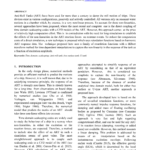
Carette, Nicolas F. A. J.
15th International Ship Stability Workshop, Stockholm, Sweden, 2016.
Abstract | Links | BibTeX | Tags: anti-roll tank, free surface tank, seakeeping, Time domain, U-tank
@conference{Carette2016,
title = {Fast time domain evaluation of Anti-Roll Tank and ship coupling using non-linear retardation functions},
author = {Nicolas F.A.J. Carette},
url = {http://www.marin.nl/web/Publications/Papers/Fast-time-domain-evaluation-of-AntiRoll-Tank-and-ship-coupling-using-nonlinear-retardation-functions-1.htm},
year = {2016},
date = {2016-06-13},
booktitle = {15th International Ship Stability Workshop, Stockholm, Sweden},
pages = {2_2},
abstract = {Anti-Roll Tanks (ART) have been used for more than a century to damp the roll motion of ships. These devices exist in various configurations, passively and actively controlled. All versions rely on resonant water motions in a chamber which, by essence, is a very non-linear process. To account for these non-linearities, several approaches have been proposed, where the most recent and complete one is the direct coupling of time domain seakeeping codes with a CFD models of the ART. However, this approach comes at the price of relatively high computation effort. This is in contradiction with the need for long simulations to establish the effects of the non-linearities in the ART reaction forces on extreme events. To reduce the computation costs of a direct simulation, a new technique is proposed which uses retardation functions based on harmonic ART response data. The technique proposed here uses a family of retardation functions with a Hilbert transform method for time dependent interpolations to capture the non-linearity in the response of the tank as a function of excitation amplitude.},
keywords = {anti-roll tank, free surface tank, seakeeping, Time domain, U-tank},
pubstate = {published},
tppubtype = {conference}
}
D. van Heel, Klinkenberg; Ouwerkerk, M.
Tracking Stress and Workload in the Maritime/Tugboat World Conference
24th International Tug, Salvage & OSV Convention (ITS), Boston, MA, 2016.
Abstract | Links | BibTeX | Tags: extreme environmental challenges, k+s projects, tug simulator, workload
@conference{Heel2016,
title = {Tracking Stress and Workload in the Maritime/Tugboat World},
author = {Heel, D. van, Klinkenberg, K., Blankertz, B., Miklody, D., Uitterhoeve, W. and Ouwerkerk, M.},
url = {http://www.marin.nl/web/Publications/Papers/Tracking-Stress-and-Workload-in-the-MaritimeTugboat-World.htm},
year = {2016},
date = {2016-05-25},
booktitle = {24th International Tug, Salvage & OSV Convention (ITS), Boston, MA},
abstract = {The Dutch research institute MARIN, the Technical University of Berlin, Philips and k+s projects would like to present the findings of a pilot study into stress/workload measurements during training in a ship-handling simulator. Working on a tug has unique demands, made more challenging by fatigue and a high workload, and influenced by special demands such as noise, the intense mixture of private and work life and what often prove to be extreme environmental challenges. The objective of this pilot study is to determine the most suitable tool to determine the workload a person experiences when executing complex tug manoeuvres. Scenarios are selected strictly according to real life on the bridge, focusing on tugboat reality. Measurements include heartbeat rate and skin conductivity, plus an EEG, but also include simulator signals. The human body is a very sophisticated control circuit, and to choose different ways of looking at the way a human expresses himself is like joining puzzle elements to a complete picture. Together they pinpoint what is most challenging for the test person. The findings will be evaluated to assess which signals are most suitable to obtain a reliable workload indicator. This tool can be used to study the impact of job procedures, modern bridge design and time/work shift systems, but also to measure the effectiveness of training programmes. The pilot study is the follow up of the demonstration of 'Training meets Science' during ITS 2014 in Hamburg, initiated and organised by k+s projects, University of Applied Sciences Bremen and University of Technology Berlin.},
keywords = {extreme environmental challenges, k+s projects, tug simulator, workload},
pubstate = {published},
tppubtype = {conference}
}
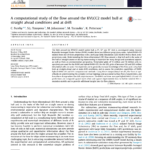
C. Fureby, Toxopeus; Petterson, K.
A computational study of the flow around the KVLCC2 model hull at straight ahead conditions and at drift Journal Article
In: Ocean Engineering, 2016, vol. 118, pp. 1-16, 2016.
Abstract | Links | BibTeX | Tags: Different angles of drift, Hybrid RANS-LES models, KVLCC2 tanker hull, Large Eddy Simulation (LES) models, Reynolds Averaged Navier Stokes (RANS) models
@article{Fureby2016,
title = {A computational study of the flow around the KVLCC2 model hull at straight ahead conditions and at drift},
author = {Fureby, C., Toxopeus, S.L., Johansson, M., Tormalm, M. and Petterson, K.},
url = {http://www.marin.nl/web/Publications/Papers/A-computational-study-of-the-flow-around-the-KVLCC2-model-hull-at-straight-ahead-conditions-and-at-drift-1.htm},
doi = {10.1016/j.oceaneng.2016.03.029},
year = {2016},
date = {2016-05-01},
booktitle = {Ocean Engineering},
journal = {Ocean Engineering, 2016},
volume = {118},
pages = {1-16},
abstract = {The flow around the KVLCC2 model tanker hull at 0 deg, 12 deg and 30 deg drift is investigated using classical Reynolds Averaged Navier–Stokes (RANS) models from two different proprietary codes, hybrid RANS-LES models from one of these proprietary codes, and Large Eddy Simulation (LES) models from a third, semi-proprietary code. Understanding the three-dimensional (3D) flow around a ship hull and in the wake of the hull on straight course or during maneuvering is important for many design and operational aspects, as well as from an environmental perspective. Tetrahedral grids of 13 million and 74 million cells respectively are used for the RANS and hybrid RANS-LES; for the LES, grids of between 120 and 200 million tetrahedral cells are used. The objectives are to generally increase knowledge of the flow past a ship hull both at straight-ahead and at static-drift conditions, and to assess the predictive capabilities of RANS, hybrid RANS-LES and LES computational methods. Using these computational results, the focus is specifically on understanding the complex vortical topology and associated surface-flow characteristics, and how these change when the drift angle increases. The RANS and time-averaged hybrid RANS-LES and LES predictions are compared against each other and against experimental data to further validate the simulation models and to provide additional insight into the flow physics.},
keywords = {Different angles of drift, Hybrid RANS-LES models, KVLCC2 tanker hull, Large Eddy Simulation (LES) models, Reynolds Averaged Navier Stokes (RANS) models},
pubstate = {published},
tppubtype = {article}
}
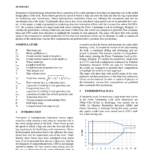
Toxopeus, S. L.; Bhawsinka, K.
Calculation of hydrodynamic interaction forces on a ship entering a Lock using CFD Conference
Fourth International Conference on Ship Manoeuvring in Shallow and Confined Water (MASHCON) - Ship Bottom Interaction, Hamburg, Germany, 2016.
Abstract | Links | BibTeX | Tags: bulk carrier, CFD, ReFRESCO, ROPES
@conference{Toxopeus2016,
title = {Calculation of hydrodynamic interaction forces on a ship entering a Lock using CFD},
author = {Toxopeus, S.L. and Bhawsinka, K.},
url = {http://www.marin.nl/web/Publications/Papers/Calculation-of-hydrodynamic-interaction-forces-on-a-ship-entering-a-Lock-using-CFD.htm},
doi = {10.18451/978-3-939230-38-0_34},
year = {2016},
date = {2016-05-01},
booktitle = {Fourth International Conference on Ship Manoeuvring in Shallow and Confined Water (MASHCON) - Ship Bottom Interaction, Hamburg, Germany},
pages = {6_01},
abstract = {Estimation of hydrodynamic interaction forces experienced by a ship entering a lock plays an important role in the initial design phase of the lock. These forces govern the speed at which a ship can enter the lock and also the tug requirement for facilitating such manoeuvres. Hence hydrodynamic interaction forces can influence the turnaround time and the operational cost of the locks. Traditionally these forces have been calculated using model tests or by potential flow solvers.
In this paper, a study is presented on predicting ship-lock interaction effects with the viscous-flow solver ReFRESCO. The scenario consists of a large-beam bulk carrier entering the Pierre Vandamme Lock in Zeebrugge, Belgium. To validate the predictions, existing model tests are used. Furthermore, the results are compared to potential flow computations and CFD results from literature to highlight the benefits of each approach.
The paper will show that with careful setup of the computations, reliable predictions of the ship-lock interaction effects can be obtained. In order to capture all physics of the interaction, viscous-flow computations are preferred above potential-flow predictions.},
keywords = {bulk carrier, CFD, ReFRESCO, ROPES},
pubstate = {published},
tppubtype = {conference}
}
In this paper, a study is presented on predicting ship-lock interaction effects with the viscous-flow solver ReFRESCO. The scenario consists of a large-beam bulk carrier entering the Pierre Vandamme Lock in Zeebrugge, Belgium. To validate the predictions, existing model tests are used. Furthermore, the results are compared to potential flow computations and CFD results from literature to highlight the benefits of each approach.
The paper will show that with careful setup of the computations, reliable predictions of the ship-lock interaction effects can be obtained. In order to capture all physics of the interaction, viscous-flow computations are preferred above potential-flow predictions.
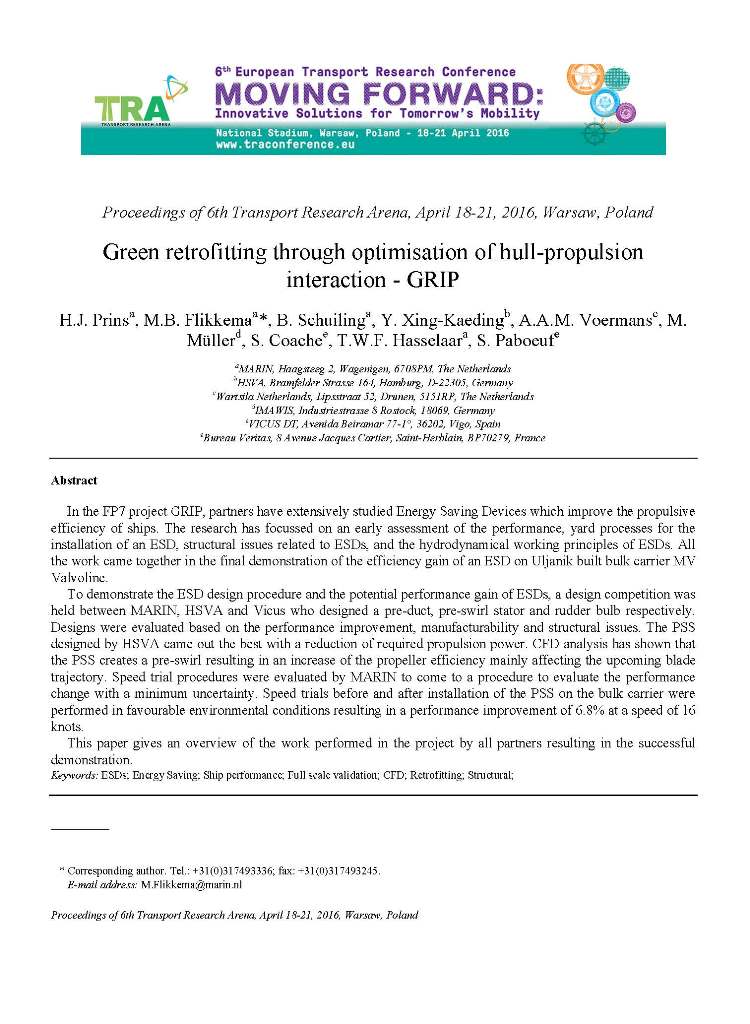
Henk; Flikkema Prins, Maarten; Schuiling
Green retrofitting through optimisation of hull-propulsion interaction - GRIP Conference
Proceedings of 6th Transport Research Arena, Warsaw, Poland, 2016.
Abstract | Links | BibTeX | Tags: CFD, Energy Saving Device, ESD, full scale validation, retrofitting, ship performance, structural
@conference{Prins2016,
title = {Green retrofitting through optimisation of hull-propulsion interaction - GRIP},
author = {Prins, Henk; Flikkema, Maarten; Schuiling, Bart; Xing-Kaeding, Y; Voermans, A. A. M.; Müller, M; Coache, S; Hasselaar, Thijs; Paboeuf, S},
url = {http://www.marin.nl/web/Publications/Papers/Green-retrofitting-through-optimisation-of-hullpropulsion-interaction-GRIP.htm },
year = {2016},
date = {2016-04-18},
booktitle = {Proceedings of 6th Transport Research Arena, Warsaw, Poland},
abstract = {In the FP7 project GRIP, partners have extensively studied Energy Saving Devices which improve the propulsive efficiency of ships. The research has focussed on an early assessment of the performance, yard processes for the installation of an ESD, structural issues related to ESDs, and the hydrodynamical working principles of ESDs. All the work came together in the final demonstration of the efficiency gain of an ESD on Uljanik built bulk carrier MV Valvoline.
To demonstrate the ESD design procedure and the potential performance gain of ESDs, a design competition was held between MARIN, HSVA and Vicus who designed a pre-duct, pre-swirl stator and rudder bulb respectively. Designs were evaluated based on the performance improvement, manufacturability and structural issues. The PSS designed by HSVA came out the best with a reduction of required propulsion power. CFD analysis has shown that the PSS creates a pre-swirl resulting in an increase of the propeller efficiency mainly affecting the upcoming blade trajectory. Speed trial procedures were evaluated by MARIN to come to a procedure to evaluate the performance change with a minimum uncertainty. Speed trials before and after installation of the PSS on the bulk carrier were performed in favourable environmental conditions resulting in a performance improvement of 6.8% at a speed of 16 knots.
This paper gives an overview of the work performed in the project by all partners resulting in the successful demonstration.},
keywords = {CFD, Energy Saving Device, ESD, full scale validation, retrofitting, ship performance, structural},
pubstate = {published},
tppubtype = {conference}
}
To demonstrate the ESD design procedure and the potential performance gain of ESDs, a design competition was held between MARIN, HSVA and Vicus who designed a pre-duct, pre-swirl stator and rudder bulb respectively. Designs were evaluated based on the performance improvement, manufacturability and structural issues. The PSS designed by HSVA came out the best with a reduction of required propulsion power. CFD analysis has shown that the PSS creates a pre-swirl resulting in an increase of the propeller efficiency mainly affecting the upcoming blade trajectory. Speed trial procedures were evaluated by MARIN to come to a procedure to evaluate the performance change with a minimum uncertainty. Speed trials before and after installation of the PSS on the bulk carrier were performed in favourable environmental conditions resulting in a performance improvement of 6.8% at a speed of 16 knots.
This paper gives an overview of the work performed in the project by all partners resulting in the successful demonstration.
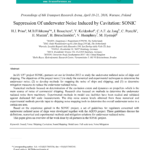
H.J. Prins, Flikkema
Suppression Of underwater Noise Induced by Cavitation: SONIC Conference
6th European Transport Research Conference, Warsaw, Poland, 2016.
Abstract | Links | BibTeX | Tags: cavitation, Full scale tests, model tests, Noise, Noise Mitigation, Shipping, Sound, Sound Mapping
@conference{Prins2016b,
title = {Suppression Of underwater Noise Induced by Cavitation: SONIC},
author = {Prins, H.J., Flikkema, M.B., Bosschers, J., Koldenhof, Y., Jong, C.A.F. de, Pestelli, C., Mumm, H., Bretschneider, H., Humphrey, V., Hyensjö, M.},
url = {http://www.marin.nl/web/Publications/Papers/Suppression-Of-underwater-Noise-Induced-by-Cavitation-SONIC.htm},
year = {2016},
date = {2016-04-01},
booktitle = {6th European Transport Research Conference, Warsaw, Poland},
abstract = {In EU FP7 project SONIC, partners set out in October 2012 to study the underwater radiated noise of ships and shipping. The objectives of the project were (1) to study the numerical and experimental techniques to determine the underwater noise; (2) to develop methods for mapping the noise of ships and shipping; and (3) to determine mitigation measures to reduce the underwater radiated noise.
Numerical methods focused on determination of the cavitation extent and dynamics on propellers which is the main source of noise of commercial shipping. Research also focused on methods to determine the underwater radiated noise from machinery. Experimental methods in model test facilities have been studied and validated against dedicated full scale measurements. The ship noise source levels obtained from these numerical and experimental methods provide input to shipping noise mapping tools to determine the overall underwater noise in a certain sea area.
Based on the experience gained in the SONIC project, a set of guidelines for regulators concerned with underwater radiated noise of ships were developed together with the AQUO project. These guidelines discuss the definitions, numerical and experimental methods and mitigation solutions for underwater radiated noise.
This paper gives an overview of the work done by all partners in the SONIC project.},
keywords = {cavitation, Full scale tests, model tests, Noise, Noise Mitigation, Shipping, Sound, Sound Mapping},
pubstate = {published},
tppubtype = {conference}
}
Numerical methods focused on determination of the cavitation extent and dynamics on propellers which is the main source of noise of commercial shipping. Research also focused on methods to determine the underwater radiated noise from machinery. Experimental methods in model test facilities have been studied and validated against dedicated full scale measurements. The ship noise source levels obtained from these numerical and experimental methods provide input to shipping noise mapping tools to determine the overall underwater noise in a certain sea area.
Based on the experience gained in the SONIC project, a set of guidelines for regulators concerned with underwater radiated noise of ships were developed together with the AQUO project. These guidelines discuss the definitions, numerical and experimental methods and mitigation solutions for underwater radiated noise.
This paper gives an overview of the work done by all partners in the SONIC project.
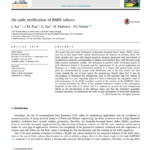
L. Eça, Klaij; Pereira, F. S.
On code verification of RANS solvers Journal Article
In: Journal of Computational Physics, 2016, vol. 310, pp. 418-439, 2016.
Abstract | Links | BibTeX | Tags: Code verification, Manufactured solutions, Numerical Error, Order of grid convergence
@article{Eça2016b,
title = {On code verification of RANS solvers},
author = {Eça, L., Klaij, C.M., Vaz, G., Hoekstra, M. and Pereira, F.S.},
url = {http://www.marin.nl/web/Publications/Papers/On-code-verification-of-RANS-solvers.htm},
doi = {10.1016/j.jcp.2016.01.002},
year = {2016},
date = {2016-04-01},
journal = {Journal of Computational Physics, 2016},
volume = {310},
pages = {418-439},
abstract = {This article discusses Code Verification of Reynolds-Averaged Navier Stokes (RANS) solvers that rely on face based finite volume discretizations for volumes of arbitrary shape. The study includes test cases with known analytical solutions (generated with the method of manufactured solutions) corresponding to laminar and turbulent flow, with the latter using eddy-viscosity turbulence models. The procedure to perform Code Verification based on grid refinement studies is discussed and the requirements for its correct application are illustrated in a simple one-dimensional problem. It is shown that geometrically similar grids are recommended for proper Code Verification and so the data should not have scatter making the use of least square fits unnecessary. Results show that it may be advantageous to determine the extrapolated error to cell size/time step zero instead of assuming that it is zero, especially when it is hard to determine the asymptotic order of grid convergence. In the RANS examples, several of the features of the ReFRESCO solver are checked including the effects of the available turbulence models in the convergence properties of the code. It is shown that it is required to account for non-orthogonality effects in the discretization of the diffusion terms and that the turbulence quantities transport equations can deteriorate the order of grid convergence of mean flow quantities.},
keywords = {Code verification, Manufactured solutions, Numerical Error, Order of grid convergence},
pubstate = {published},
tppubtype = {article}
}
2015
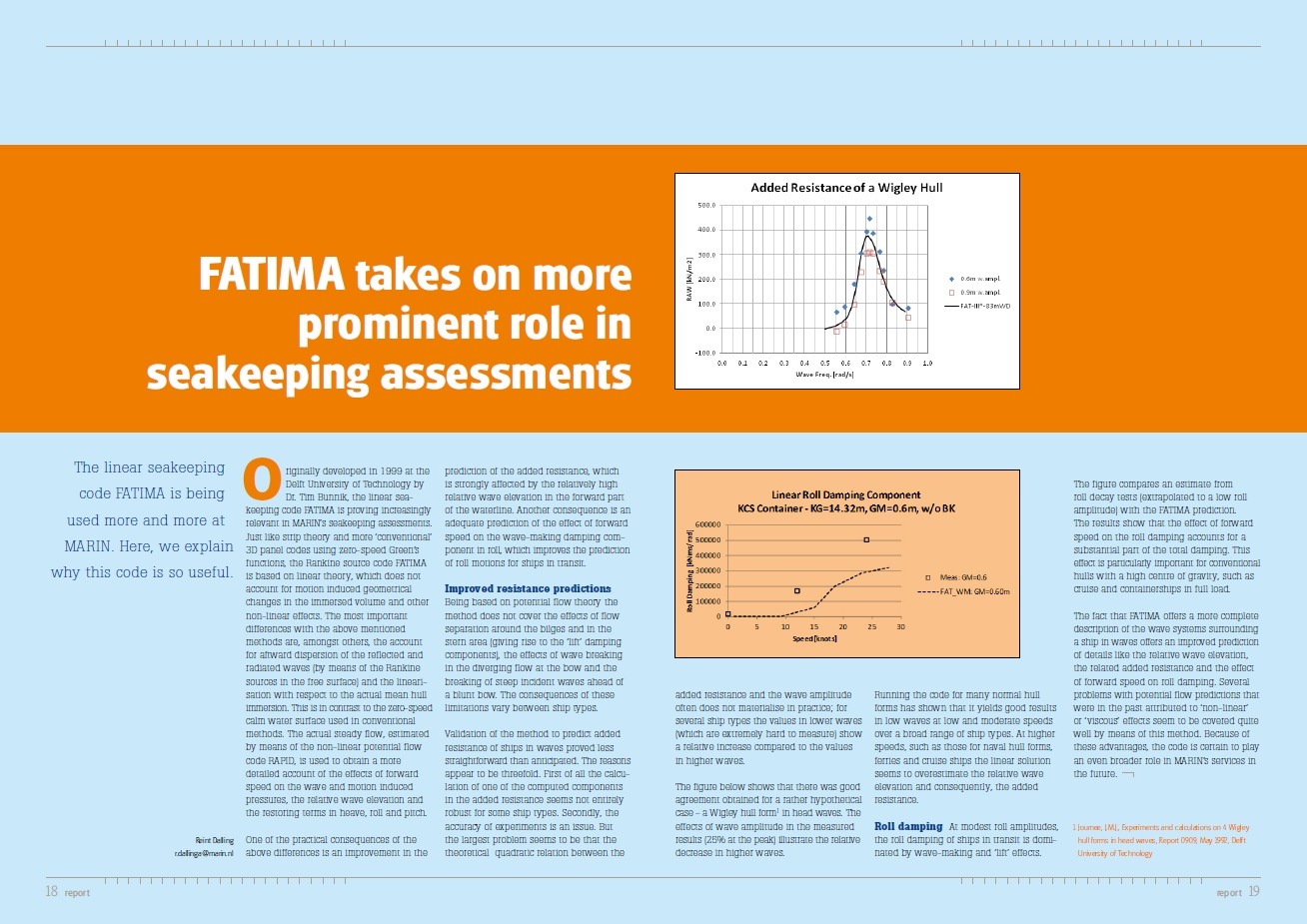
Dallinga, Reint
FATIMA takes on more prominent role in seakeeping assessments Journal Article
In: MARIN Report, no. 116, pp. 18-19, 2015.
Abstract | Links | BibTeX | Tags: added resistance in waves, CFD seakeeping, motions
@article{Dallinga2015,
title = {FATIMA takes on more prominent role in seakeeping assessments},
author = {Reint Dallinga },
url = {http://content.yudu.com/web/1r3p1/0A3a046/MR116/html/index.html?page=18},
year = {2015},
date = {2015-12-01},
journal = {MARIN Report},
number = {116},
pages = {18-19},
abstract = {The linear seakeeping code FATIMA is being used more and more at MARIN. Here, we explain why this code is so useful.},
keywords = {added resistance in waves, CFD seakeeping, motions},
pubstate = {published},
tppubtype = {article}
}
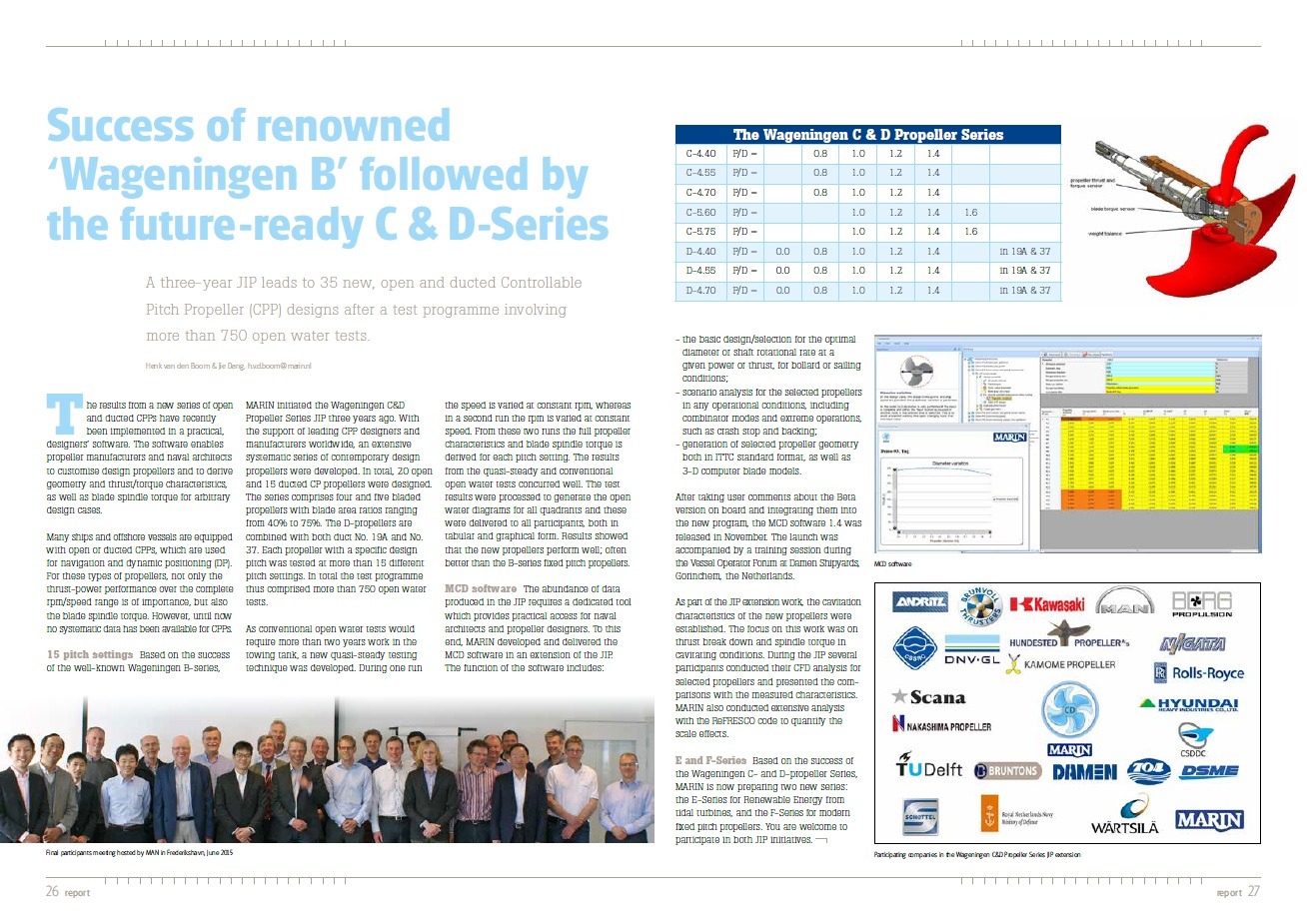
van den Boom, Henk; Dang, Jie
Success of renowned ‘Wageningen B’ followed by the future-ready C & D-Series Journal Article
In: MARIN Report, no. 116, pp. 26-27, 2015.
Abstract | Links | BibTeX | Tags: CPP, ducted, propeller, series, Wageningen B
@article{Boom2015,
title = {Success of renowned ‘Wageningen B’ followed by the future-ready C & D-Series},
author = {Henk van den Boom and Jie Dang},
url = {http://content.yudu.com/web/1r3p1/0A3a046/MR116/html/index.html?page=26},
year = {2015},
date = {2015-12-01},
journal = {MARIN Report},
number = {116},
pages = {26-27},
abstract = {A three-year JIP leads to 35 new, open and ducted Controllable Pitch Propeller (CPP) designs after a test programme involving more than 750 open water tests.},
keywords = {CPP, ducted, propeller, series, Wageningen B},
pubstate = {published},
tppubtype = {article}
}
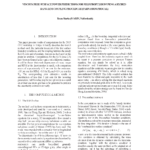
Starke, Bram
A Workshop on CFD in Ship Hydrodynamics, Tokyo, Japan, no. 15-2, Tokyo 2015, 2015.
Abstract | Links | BibTeX | Tags: CFD, hybrid, PARNASSOS, PROCAL, RANS-BEM, self-propulsion, viscous
@conference{Starke2015,
title = {Viscous Free-Surface Power Predictions For Self-Propulsion Using A Hybrid RANS-BEM Coupling Procedure (PARNASSOS-PROCAL)},
author = {Bram Starke},
url = {http://www.marin.nl/web/Publications/Papers/Viscous-FreeSurface-Power-Predictions-For-SelfPropulsion-Using-A-Hybrid-RANSBEM-Coupling-Procedure-PARNASSOSPROCAL.htm},
year = {2015},
date = {2015-12-01},
booktitle = {A Workshop on CFD in Ship Hydrodynamics, Tokyo, Japan},
journal = {Tokyo 2015, A Workshop on CFD in Ship Hydrodynamics, Tokyo, Japan},
number = {15-2},
publisher = {Tokyo 2015},
abstract = {This paper presents results of computations for the 2015 CFD workshop in Tokyo. It briefly describes the RANS method used, the particular treatment of the free surface boundary conditions, and the coupling between the steady RANS code and a boundary element method used for the propeller analysis. Computations for the KCS (case 2.5) have been performed at five grids with different densities. It will be shown that mesh dependence of thrust, torque and RPM at the finest meshes is small, with comparison errors of approximately -0.3 per cent for the resistance, -1.8 per cent for RPM, +3.5 for KT and +5.9 per cent for KQ. The corresponding error estimation results in uncertainties of less than 1 per cent for the powering parameters, but this value may be too optimistic as a result on at least one more grid has to be generated to perform the uncertainty estimation correctly.},
keywords = {CFD, hybrid, PARNASSOS, PROCAL, RANS-BEM, self-propulsion, viscous},
pubstate = {published},
tppubtype = {conference}
}
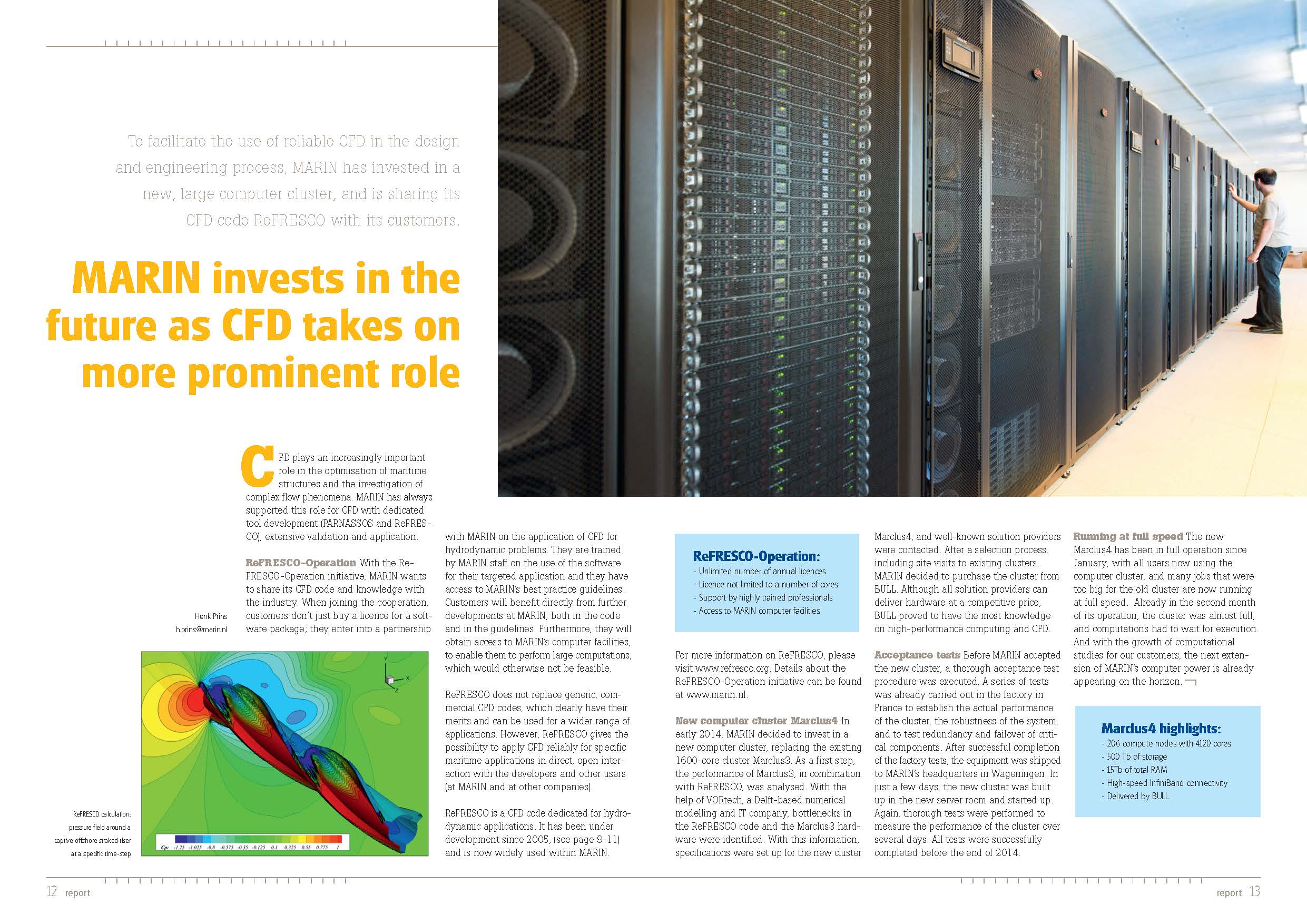
Prins, Henk
MARIN invests in the future as CFD takes on more prominent role Journal Article
In: MARIN Report, no. 115, pp. 12-13, 2015.
Abstract | Links | BibTeX | Tags: CFD, computer cluster, ReFRESCO
@article{Prins2015,
title = {MARIN invests in the future as CFD takes on more prominent role},
author = {Henk Prins},
url = {http://content.yudu.com/web/1r3p1/0A3a046/MR115/html/index.html?page=12},
year = {2015},
date = {2015-08-01},
journal = {MARIN Report},
number = {115},
pages = {12-13},
abstract = {To facilitate the use of reliable CFD in the design and engineering process, MARIN has invested in a new, large computer cluster, and is sharing its CFD code ReFRESCO with its customers.},
keywords = {CFD, computer cluster, ReFRESCO},
pubstate = {published},
tppubtype = {article}
}
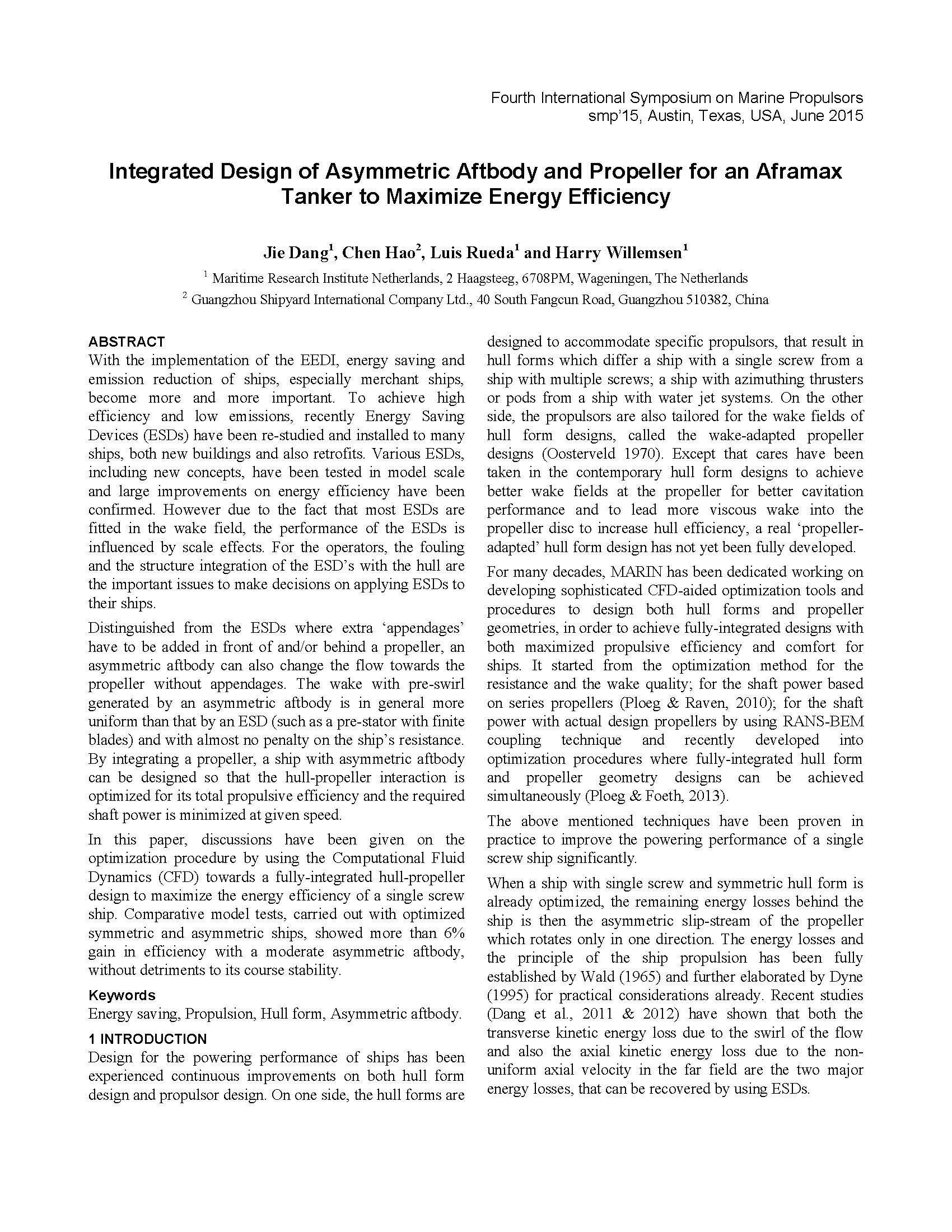
Dang, Jie; Chen, Hao; Rueda, Luis; Willemsen, Harry
Fourth International Symposium on Marine Propulsors (SMP), Austin, Texas , Symposiums on Marine Propulsors 2015.
Abstract | Links | BibTeX | Tags: aframax, asymmetric aftbody, CFD, efficiency, Energy Saving Device, ESD, propeller, RANS-BEM, tanker
@conference{Dang2015,
title = {Integrated Design of Asymmetric Aftbody and Propeller for an Aframax Tanker to Maximize Energy Efficiency},
author = {Jie Dang and Hao Chen and Luis Rueda and Harry Willemsen},
url = {http://www.marin.nl/web/Publications/Papers/Integrated-Design-of-Asymmetric-Aftbody-and-Propeller-for-an-Aframax-Tanker-to-Maximize-Energy-Efficiency.htm
http://www.marinepropulsors.com/proceedings.php},
year = {2015},
date = {2015-06-01},
booktitle = {Fourth International Symposium on Marine Propulsors (SMP), Austin, Texas },
organization = {Symposiums on Marine Propulsors},
abstract = {With the implementation of the EEDI, energy saving and emission reduction of ships, especially merchant ships, become more and more important. To achieve high efficiency and low emissions, recently Energy Saving Devices (ESDs) have been re-studied and installed to many ships, both new buildings and also retrofits. Various ESDs, including new concepts, have been tested in model scale and large improvements on energy efficiency have been confirmed. However due to the fact that most ESDs are fitted in the wake field, the performance of the ESDs is influenced by scale effects. For the operators, the fouling and the structure integration of the ESD’s with the hull are the important issues to make decisions on applying ESDs to their ships.
Distinguished from the ESDs where extra ‘appendages’ have to be added in front of and/or behind a propeller, an asymmetric aftbody can also change the flow towards the propeller without appendages. The wake with pre-swirl generated by an asymmetric aftbody is in general more uniform than that by an ESD (such as a pre-stator with finite blades) and with almost no penalty on the ship’s resistance. By integrating a propeller, a ship with asymmetric aftbody can be designed so that the hull-propeller interaction is optimized for its total propulsive efficiency and the required shaft power is minimized at given speed.
In this paper, discussions have been given on the optimization procedure by using the Computational Fluid Dynamics (CFD) towards a fully-integrated hull-propeller design to maximize the energy efficiency of a single screw ship. Comparative model tests, carried out with optimized symmetric and asymmetric ships, showed more than 6% gain in efficiency with a moderate asymmetric aftbody, without detriments to its course stability. },
keywords = {aframax, asymmetric aftbody, CFD, efficiency, Energy Saving Device, ESD, propeller, RANS-BEM, tanker},
pubstate = {published},
tppubtype = {conference}
}
Distinguished from the ESDs where extra ‘appendages’ have to be added in front of and/or behind a propeller, an asymmetric aftbody can also change the flow towards the propeller without appendages. The wake with pre-swirl generated by an asymmetric aftbody is in general more uniform than that by an ESD (such as a pre-stator with finite blades) and with almost no penalty on the ship’s resistance. By integrating a propeller, a ship with asymmetric aftbody can be designed so that the hull-propeller interaction is optimized for its total propulsive efficiency and the required shaft power is minimized at given speed.
In this paper, discussions have been given on the optimization procedure by using the Computational Fluid Dynamics (CFD) towards a fully-integrated hull-propeller design to maximize the energy efficiency of a single screw ship. Comparative model tests, carried out with optimized symmetric and asymmetric ships, showed more than 6% gain in efficiency with a moderate asymmetric aftbody, without detriments to its course stability.
2014
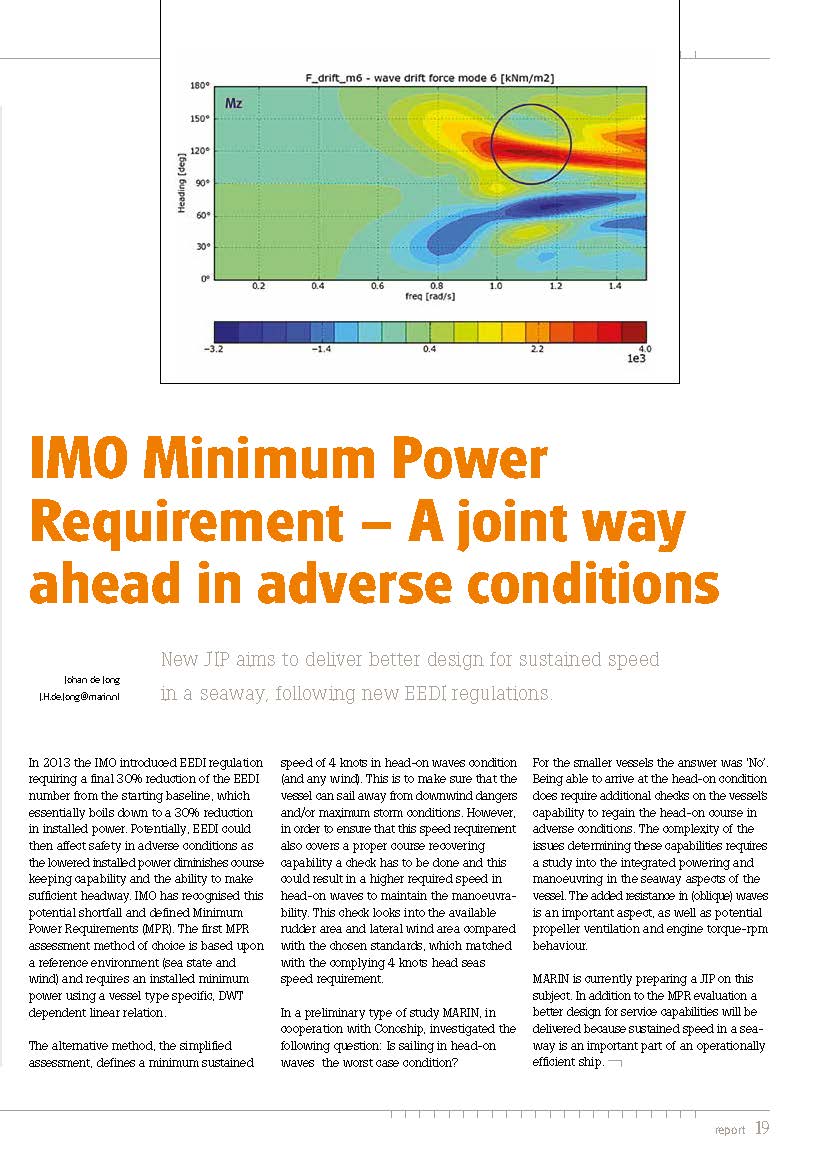
de Jong, Johan
IMO Minimum Power Requirement – A joint way ahead in adverse conditions Journal Article
In: MARIN Report, no. 113, pp. 19, 2014.
Abstract | Links | BibTeX | Tags: added resistance in waves, EEDI, minimum power requirement, MPR
@article{Jong2014,
title = {IMO Minimum Power Requirement – A joint way ahead in adverse conditions},
author = {Johan de Jong},
url = {http://content.yudu.com/web/1r3p1/0A3a046/MR113/html/index.html?page=18},
year = {2014},
date = {2014-12-01},
journal = {MARIN Report},
number = {113},
pages = {19},
abstract = {New JIP aims to deliver better design for sustained speed in a seaway, following new EEDI regulations.},
keywords = {added resistance in waves, EEDI, minimum power requirement, MPR},
pubstate = {published},
tppubtype = {article}
}
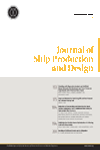
Grin, Rob
On the Prediction of Wave-added Resistance with Empirical Method Journal Article
In: Journal of Ship Production and Design, vol. 30, no. 4, pp. 11, 2014.
Abstract | Links | BibTeX | Tags: added resistance in waves, sea margin, sea trial, seakeeping, speed loss, STA JIP
@article{Grin2014,
title = {On the Prediction of Wave-added Resistance with Empirical Method},
author = {Rob Grin},
url = {http://www.marin.nl/web/Publications/Publication-items/On-the-Prediction-of-Waveadded-Resistance-with-Empirical-Methods.htm},
year = {2014},
date = {2014-11-01},
journal = {Journal of Ship Production and Design},
volume = {30},
number = {4},
pages = {11},
abstract = {The prediction of wave-added resistance is important for several reasons. In heavy weather safety aspects are most important.
Is the ship able to sustain sufficient speed to maintain heading and is the main engine able to cope with the overload? In moderate weather conditions, fuel economy is most important. In these conditions, the power demand increases when speed is sustained or when sailing at constant power the added resistance will result in speed loss.
The safety and economic aspects can already be studied in the design stage with so-called operability studies. These studies account for the actual service conditions and assist the designer to optimize for service conditions and to select an appropriate service margin. When the service margin is too low, safety might be at risk and the reliability in terms of arrival times will be low. When the service margin is too high, the main engine will run most of the time at inefficient power settings and (future) energy efficiency design index (EEDI) requirements might not be met.
Within the present work we compared two recently developed empirical prediction methods, two established empirical methods developed in the 1970s and experimental data in regular waves and irregular seas. The first new method (STAWAVE2) predicts added resistance in head seas only and has been developed within the Sea Trial Performance Joint Industry Project (STA-JIP). The goal of this JIP was to improve transparency and accuracy of speed trials. One of the requirements was to deliver a reliable correction method for wave-added resistance. The second new method (SPAWAVE) is suitable for all wave directions and has been developed within the service performance analysis joint industry project (SPA-JIP). This JIP aimed at the reduction of fuel consumption by careful analysis of the vessel performance in service conditions.},
keywords = {added resistance in waves, sea margin, sea trial, seakeeping, speed loss, STA JIP},
pubstate = {published},
tppubtype = {article}
}
Is the ship able to sustain sufficient speed to maintain heading and is the main engine able to cope with the overload? In moderate weather conditions, fuel economy is most important. In these conditions, the power demand increases when speed is sustained or when sailing at constant power the added resistance will result in speed loss.
The safety and economic aspects can already be studied in the design stage with so-called operability studies. These studies account for the actual service conditions and assist the designer to optimize for service conditions and to select an appropriate service margin. When the service margin is too low, safety might be at risk and the reliability in terms of arrival times will be low. When the service margin is too high, the main engine will run most of the time at inefficient power settings and (future) energy efficiency design index (EEDI) requirements might not be met.
Within the present work we compared two recently developed empirical prediction methods, two established empirical methods developed in the 1970s and experimental data in regular waves and irregular seas. The first new method (STAWAVE2) predicts added resistance in head seas only and has been developed within the Sea Trial Performance Joint Industry Project (STA-JIP). The goal of this JIP was to improve transparency and accuracy of speed trials. One of the requirements was to deliver a reliable correction method for wave-added resistance. The second new method (SPAWAVE) is suitable for all wave directions and has been developed within the service performance analysis joint industry project (SPA-JIP). This JIP aimed at the reduction of fuel consumption by careful analysis of the vessel performance in service conditions.
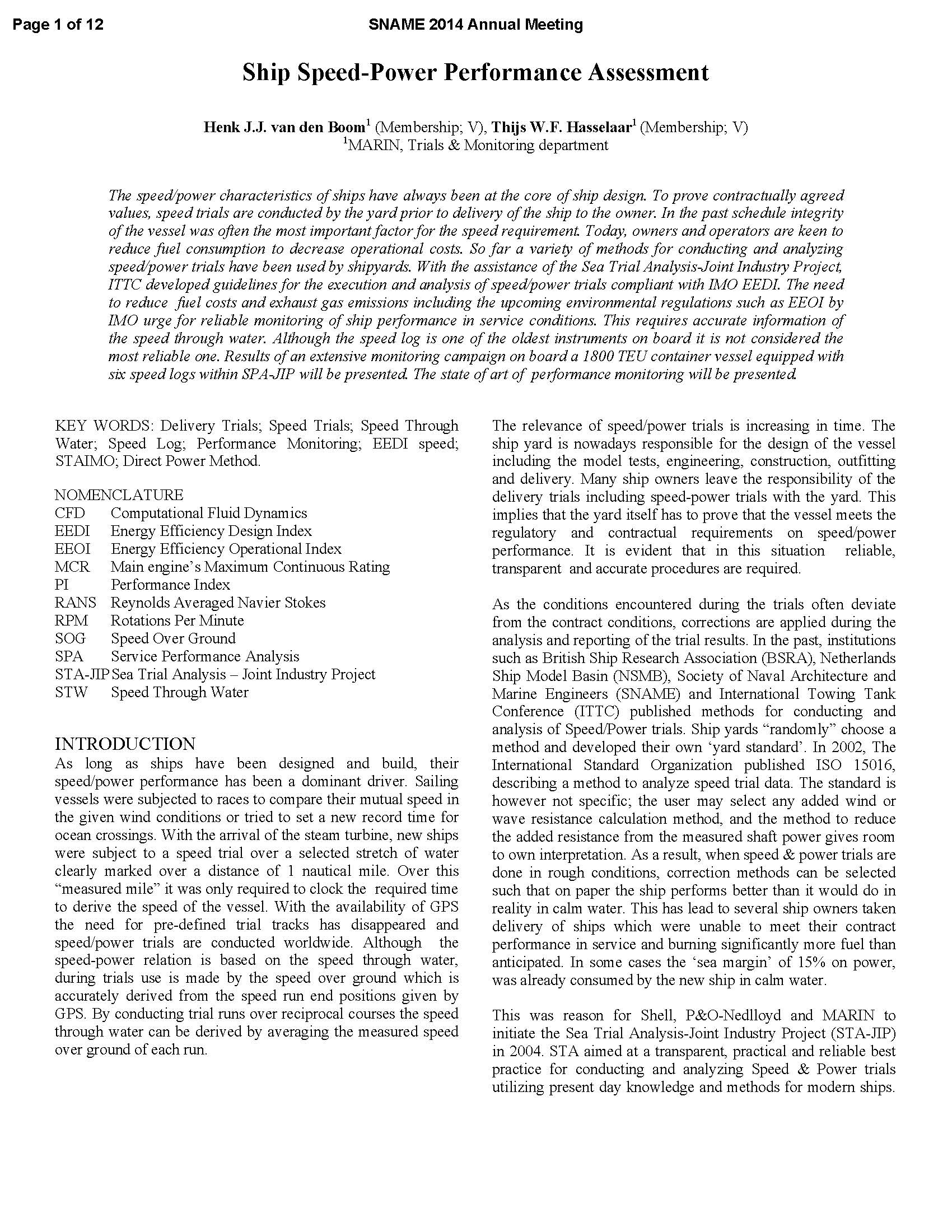
van den Boom, Henk; Hasselaar, Thijs
Ship Speed-Power Performance Assessment Conference
SNAME Annual Meeting, Houston, TX, no. T04, The Society of Naval Architects and Marine Engineers 2014.
Abstract | Links | BibTeX | Tags: EEDI, full scale, measurement, performance, ship, speed-power
@conference{Boom2014,
title = {Ship Speed-Power Performance Assessment},
author = {Henk van den Boom and Thijs Hasselaar},
url = {http://www.marin.nl/web/Publications/Papers/Ship-SpeedPower-Performance-Assessment.htm
http://www.sname.org/},
year = {2014},
date = {2014-10-01},
booktitle = {SNAME Annual Meeting, Houston, TX},
journal = {SNAME Annual Meeting, Houston, TX},
number = {T04},
organization = {The Society of Naval Architects and Marine Engineers},
abstract = {The speed/power characteristics of ships have always been at the core of ship design. To prove contractually agreed values, speed trials are conducted by the yard prior to delivery of the ship to the owner. In the past schedule integrity of the vessel was often the most important factor for the speed requirement. Today, owners and operators are keen to reduce fuel consumption to decrease operational costs. So far a variety of methods for conducting and analyzing speed/power trials have been used by shipyards. With the assistance of the Sea Trial Analysis-Joint Industry Project, ITTC developed guidelines for the execution and analysis of speed/power trials compliant with IMO EEDI. The need to reduce fuel costs and exhaust gas emissions including the upcoming environmental regulations such as EEOI by IMO urge for reliable monitoring of ship performance in service conditions. This requires accurate information of the speed through water. Although the speed log is one of the oldest instruments on board it is not considered the most reliable one. Results of an extensive monitoring campaign on board a 1800 TEU container vessel equipped with six speed logs within SPA-JIP will be presented. The state of art of performance monitoring will be presented.},
keywords = {EEDI, full scale, measurement, performance, ship, speed-power},
pubstate = {published},
tppubtype = {conference}
}
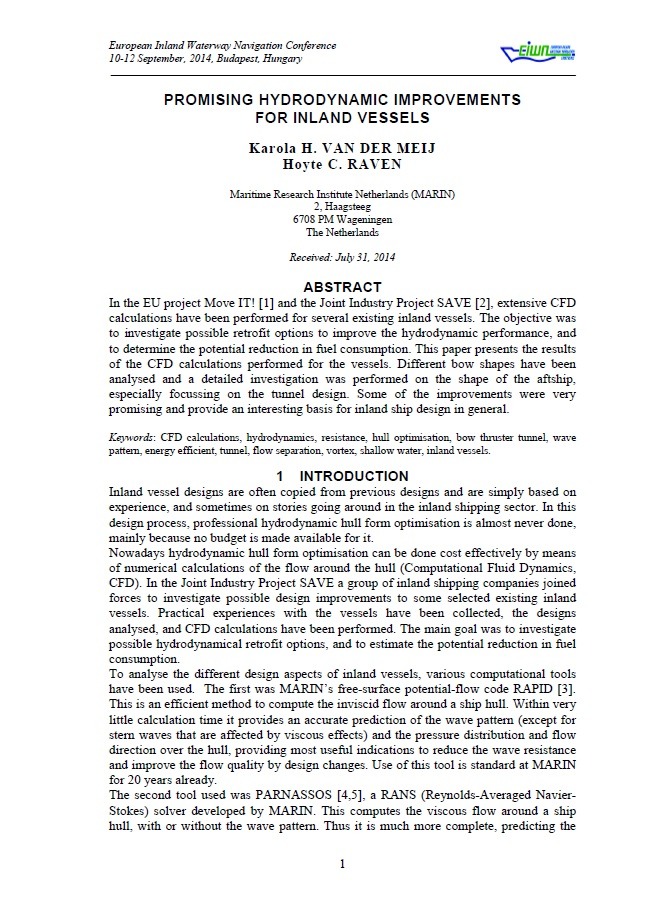
van der Meij, Karola; Raven, Hoyte
Promising hydrodynamic improvements for inland vessels Conference
EIWN Conference, Budapest, Hungary, European Inland Waterway Navigation Conference , 2014.
Abstract | Links | BibTeX | Tags: CFD, efficiency, inland ship design, shallow water
@conference{Meij2014,
title = {Promising hydrodynamic improvements for inland vessels},
author = {Karola van der Meij and Hoyte Raven},
url = {http://www.marin.nl/web/Publications/Publication-items/Promising-Hydrodynamic-Improvements-for-Inland-Vessels-1.htm
},
year = {2014},
date = {2014-09-10},
booktitle = {EIWN Conference, Budapest, Hungary},
publisher = {European Inland Waterway Navigation Conference },
abstract = {In the EU project Move IT! and the Joint Industry Project SAVE, extensive CFD calculations have been performed for several existing inland vessels. The objective was to investigate possible retrofit options to improve the hydrodynamic performance, and to determine the potential reduction in fuel consumption. This paper presents the results of the CFD calculations performed for the vessels. Different bow shapes have been analysed and a detailed investigation was performed on the shape of the aftship, especially focussing on the tunnel design. Some of the improvements were very promising and provide an interesting basis for inland ship design in general.
},
keywords = {CFD, efficiency, inland ship design, shallow water},
pubstate = {published},
tppubtype = {conference}
}
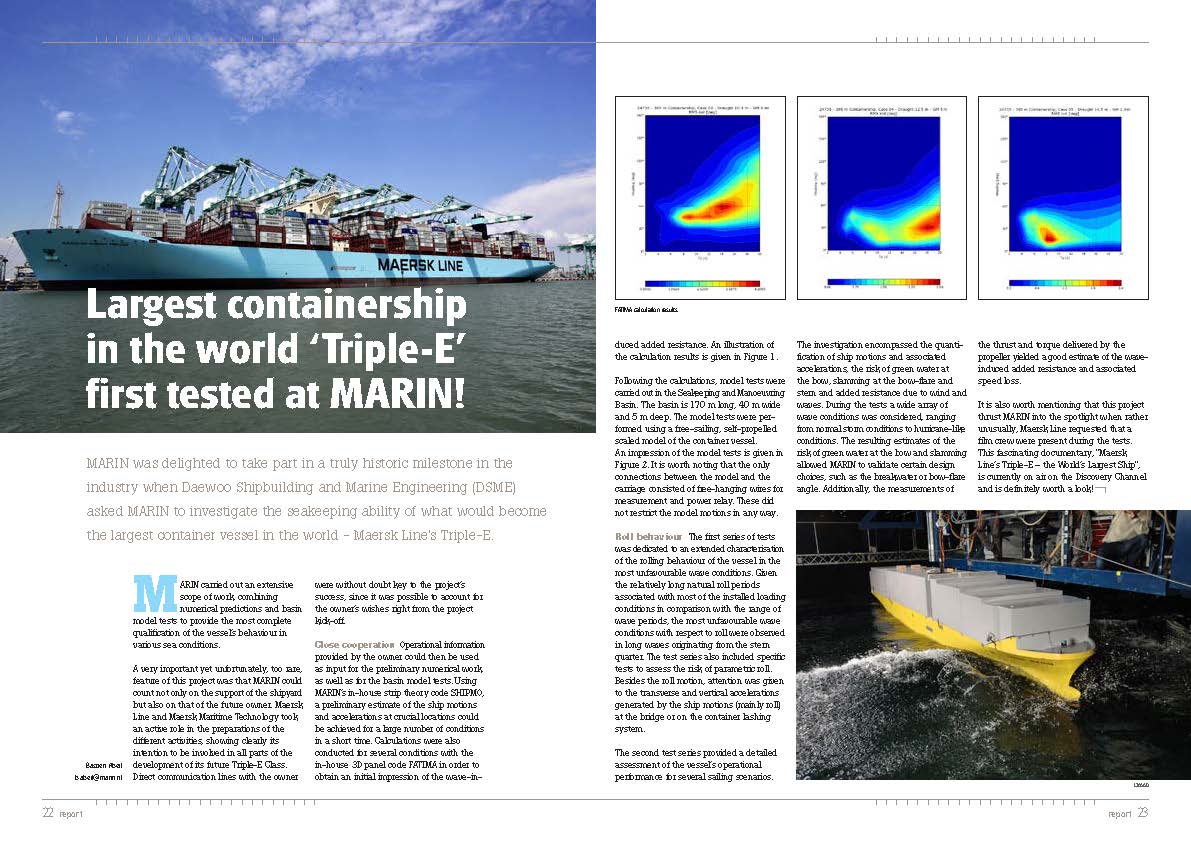
Abeil, Bastien
Largest containership in the world ‘Triple-E’ first tested at MARIN! Journal Article
In: MARIN Report, no. 112, pp. 22-23, 2014.
Abstract | Links | BibTeX | Tags: added resistance in waves, Design for service, motions, seakeeping
@article{Abeil2014,
title = {Largest containership in the world ‘Triple-E’ first tested at MARIN!},
author = {Bastien Abeil},
url = {http://www.marin.nl/extra/marin-bladermodules/html/112/#22},
year = {2014},
date = {2014-08-01},
journal = {MARIN Report},
number = {112},
pages = {22-23},
abstract = {MARIN was delighted to take part in a truly historic milestone in the industry when Daewoo Shipbuilding and Marine Engineering (DSME) asked MARIN to investigate the seakeeping ability of what would become the largest container vessel in the world - Maersk Line’s Triple-E.},
keywords = {added resistance in waves, Design for service, motions, seakeeping},
pubstate = {published},
tppubtype = {article}
}
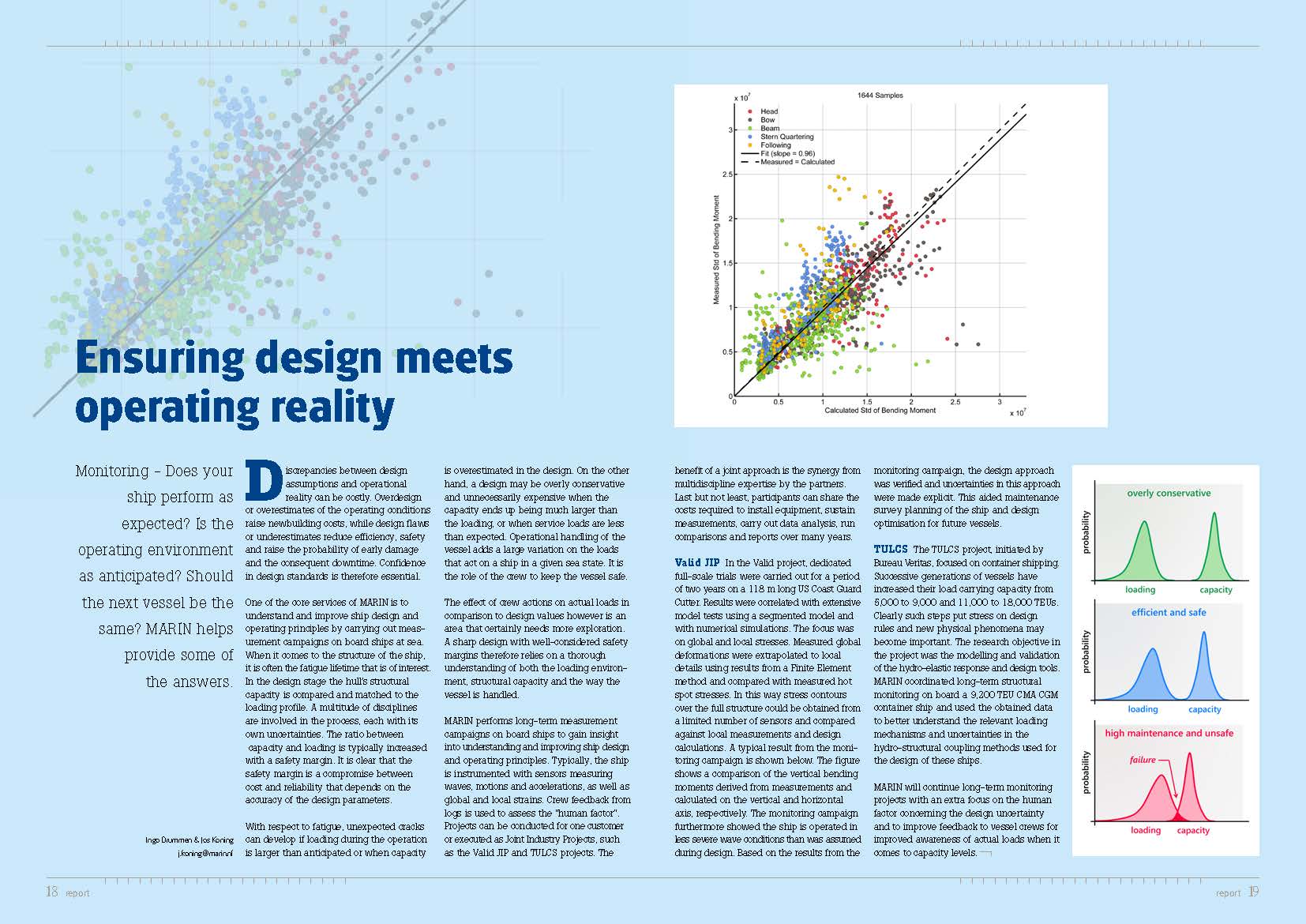
Drummen, Ingo; Koning, Jos
Ensuring design meets operating reality Journal Article
In: MARIN Report, no. 112, pp. 18-19, 2014.
Abstract | Links | BibTeX | Tags: added resistance in waves, environment, full scale, monitoring, operation
@article{Drummen2014,
title = {Ensuring design meets operating reality},
author = {Ingo Drummen and Jos Koning},
url = {http://www.marin.nl/extra/marin-bladermodules/html/112/#18},
year = {2014},
date = {2014-08-01},
journal = {MARIN Report},
number = {112},
pages = {18-19},
abstract = {Monitoring - Does your ship perform as expected? Is the operating environment as anticipated? Should the next vessel be the same? MARIN helps provide some of the answers.},
keywords = {added resistance in waves, environment, full scale, monitoring, operation},
pubstate = {published},
tppubtype = {article}
}
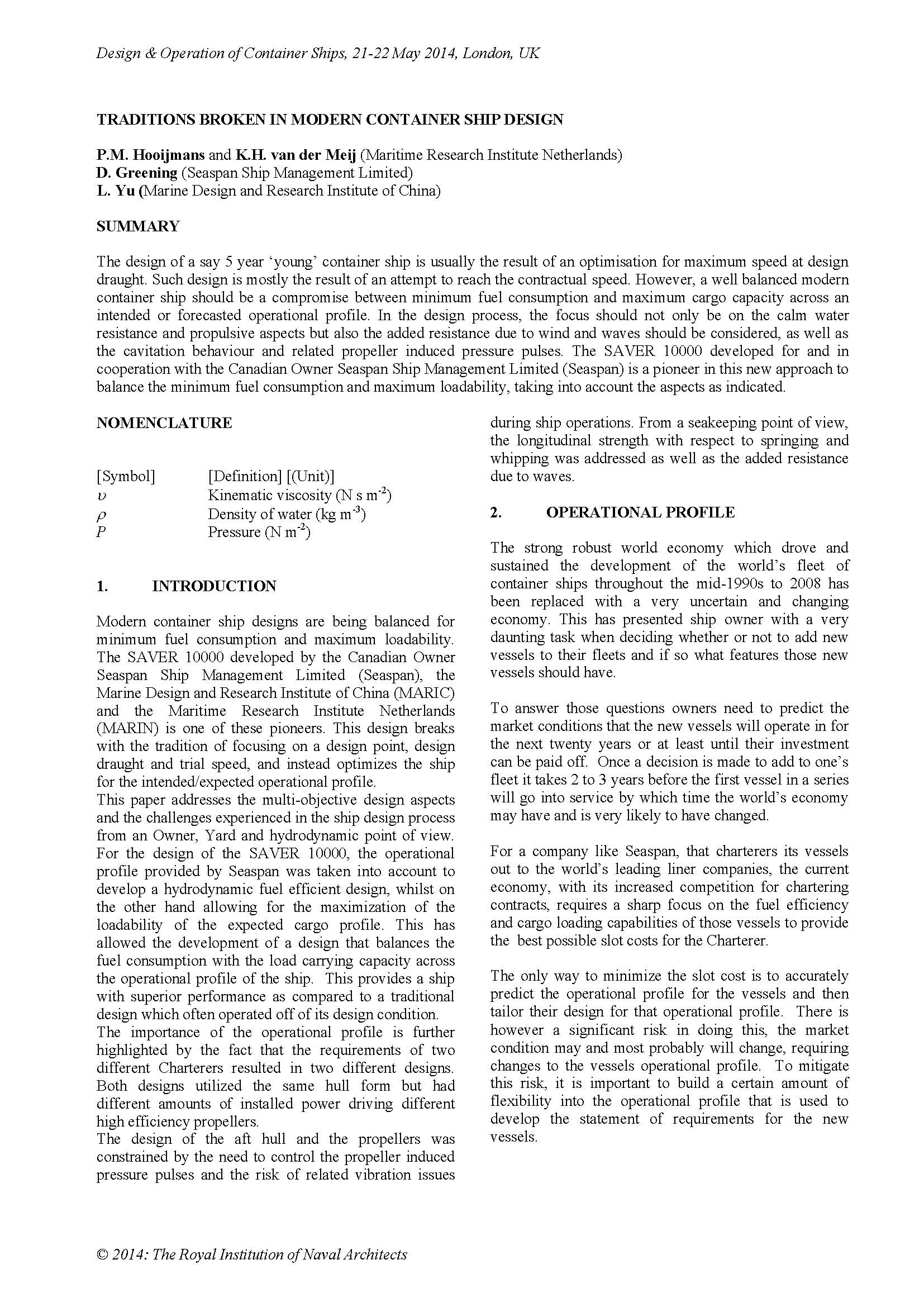
Hooijmans, Patrick; van der Meij, Karola; Greening, David; Yu, Lai
Traditions broken in modern container ship design Conference
Design & Operation of Container Ships, 21-22 May 2014, London, UK, The Royal Institute of Naval Architects, 2014.
Abstract | Links | BibTeX | Tags: containerships, Fuel consumption, seakeeping
@conference{Hooijmans2014,
title = {Traditions broken in modern container ship design},
author = {Patrick Hooijmans and Karola van der Meij and David Greening and Lai Yu},
url = {http://test.sssri-marin.com/wp-content/uploads/2016/01/Paper-Traditions-broken-in-modern-container-ship-design.pdf
http://www.rina.org.uk/Containership2014.html},
year = {2014},
date = {2014-05-21},
booktitle = {Design & Operation of Container Ships, 21-22 May 2014, London, UK},
publisher = {The Royal Institute of Naval Architects},
abstract = {The design of a say 5 year ‘young’ container ship is usually the result of an optimisation for maximum speed at design draught. Such design is mostly the result of an attempt to reach the contractual speed. However, a well balanced modern container ship should be a compromise between minimum fuel consumption and maximum cargo capacity across an intended or forecasted operational profile. In the design process, the focus should not only be on the calm water resistance and propulsive aspects but also the added resistance due to wind and waves should be considered, as well as the cavitation behaviour and related propeller induced pressure pulses. The SAVER 10000 developed for and in cooperation with the Canadian Owner Seaspan Ship Management Limited (Seaspan) is a pioneer in this new approach to balance the minimum fuel consumption and maximum loadability, taking into account the aspects as indicated.},
keywords = {containerships, Fuel consumption, seakeeping},
pubstate = {published},
tppubtype = {conference}
}
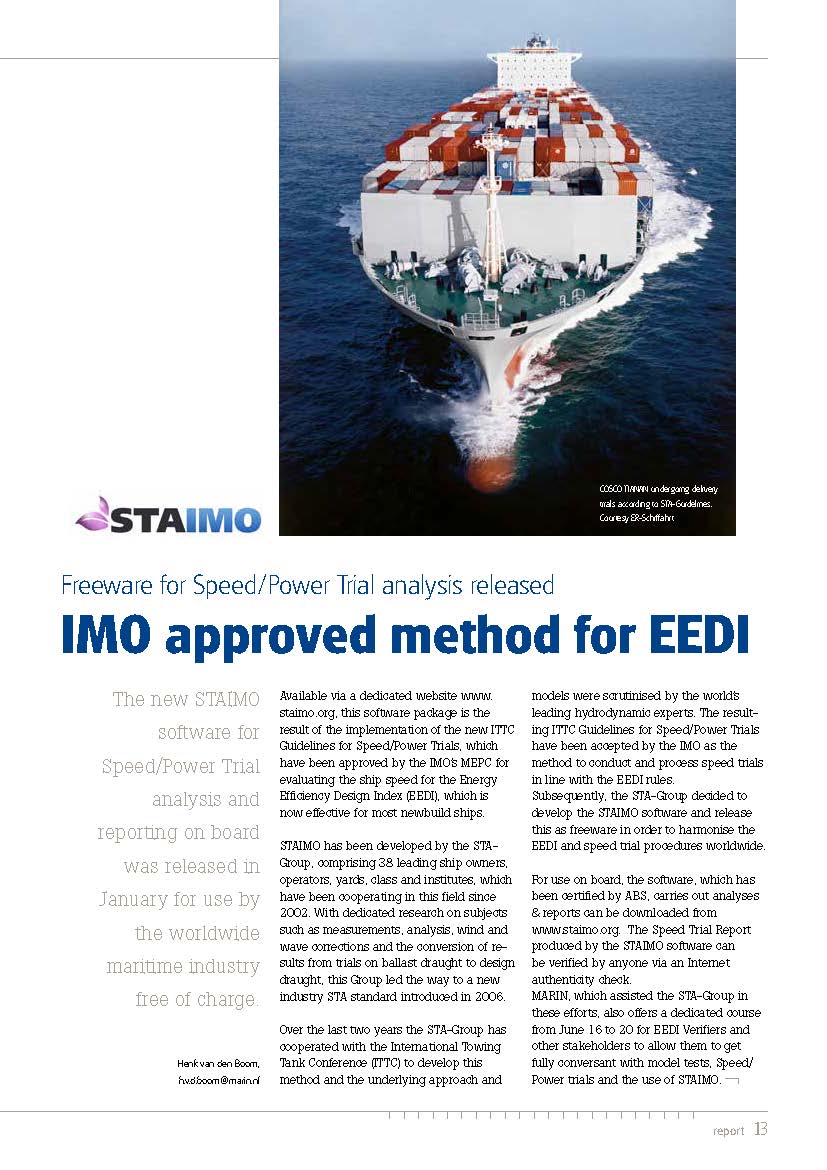
van den Boom, Henk
IMO approved method for EEDI Journal Article
In: MARIN Report, no. 111, pp. 13, 2014.
Abstract | Links | BibTeX | Tags: EEDI, IMO, STA, trial
@article{Boom2014b,
title = {IMO approved method for EEDI},
author = {Henk van den Boom},
url = {http://www.marin.nl/extra/marin-bladermodules/html/111/#12},
year = {2014},
date = {2014-04-01},
journal = {MARIN Report},
number = {111},
pages = {13},
abstract = {The new STAIMO software for Speed/Power Trial analysis and reporting on board was released in January for use by the worldwide maritime industry free of charge.},
keywords = {EEDI, IMO, STA, trial},
pubstate = {published},
tppubtype = {article}
}
2013
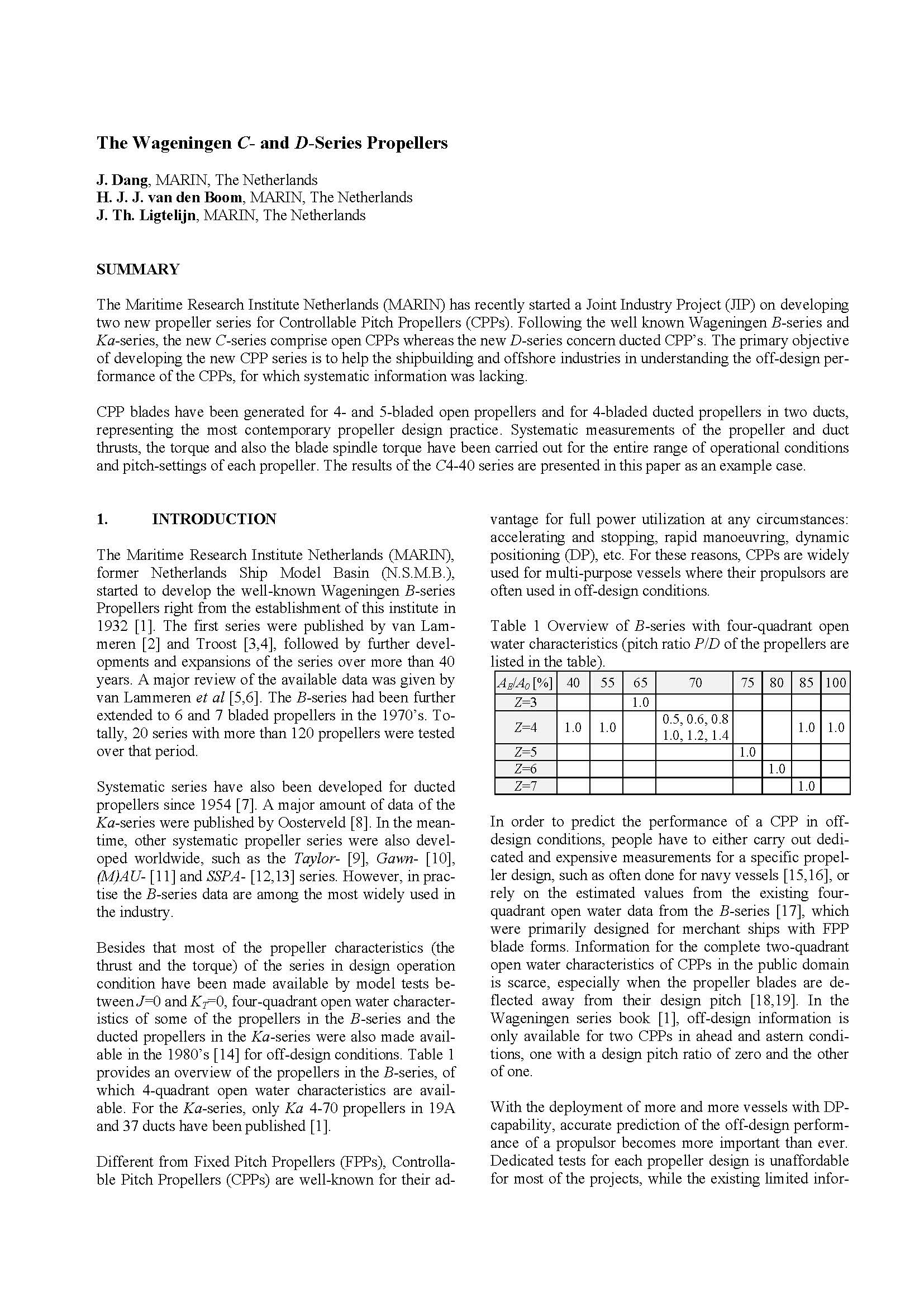
Dang, Jie; van den Boom, Henk; Ligtelijn, Do
The Wageningen C- and D-Series Propellers Conference
12th International Conference on Fast Sea Transportation (FAST), Amsterdam , no. P03, Conference on Fast Sea Transportation 2013.
Abstract | Links | BibTeX | Tags: CPP, ducted, propellers, series
@conference{Dang2013,
title = {The Wageningen C- and D-Series Propellers},
author = {Jie Dang and Henk van den Boom and Do Ligtelijn},
url = {http://www.marin.nl/web/Publications/Papers/The-Wageningen-C-and-DSeries-Propellers.htm
http://www.fastconference2013.com/
},
year = {2013},
date = {2013-12-01},
booktitle = {12th International Conference on Fast Sea Transportation (FAST), Amsterdam },
number = {P03},
organization = {Conference on Fast Sea Transportation},
abstract = {The Maritime Research Institute Netherlands (MARIN) has recently started a Joint Industry Project (JIP) on developing two new propeller series for Controllable Pitch Propellers (CPPs). Following the well known Wageningen B-series and Ka-series, the new C-series comprise open CPPs whereas the new D-series concern ducted CPP’s. The primary objective of developing the new CPP series is to help the shipbuilding and offshore industries in understanding the off-design per-formance of the CPPs, for which systematic information was lacking.
CPP blades have been generated for 4- and 5-bladed open propellers and for 4-bladed ducted propellers in two ducts, representing the most contemporary propeller design practice. Systematic measurements of the propeller and duct thrusts, the torque and also the blade spindle torque have been carried out for the entire range of operational conditions and pitch-settings of each propeller. The results of the C4-40 series are presented in this paper as an example case. },
keywords = {CPP, ducted, propellers, series},
pubstate = {published},
tppubtype = {conference}
}
CPP blades have been generated for 4- and 5-bladed open propellers and for 4-bladed ducted propellers in two ducts, representing the most contemporary propeller design practice. Systematic measurements of the propeller and duct thrusts, the torque and also the blade spindle torque have been carried out for the entire range of operational conditions and pitch-settings of each propeller. The results of the C4-40 series are presented in this paper as an example case.
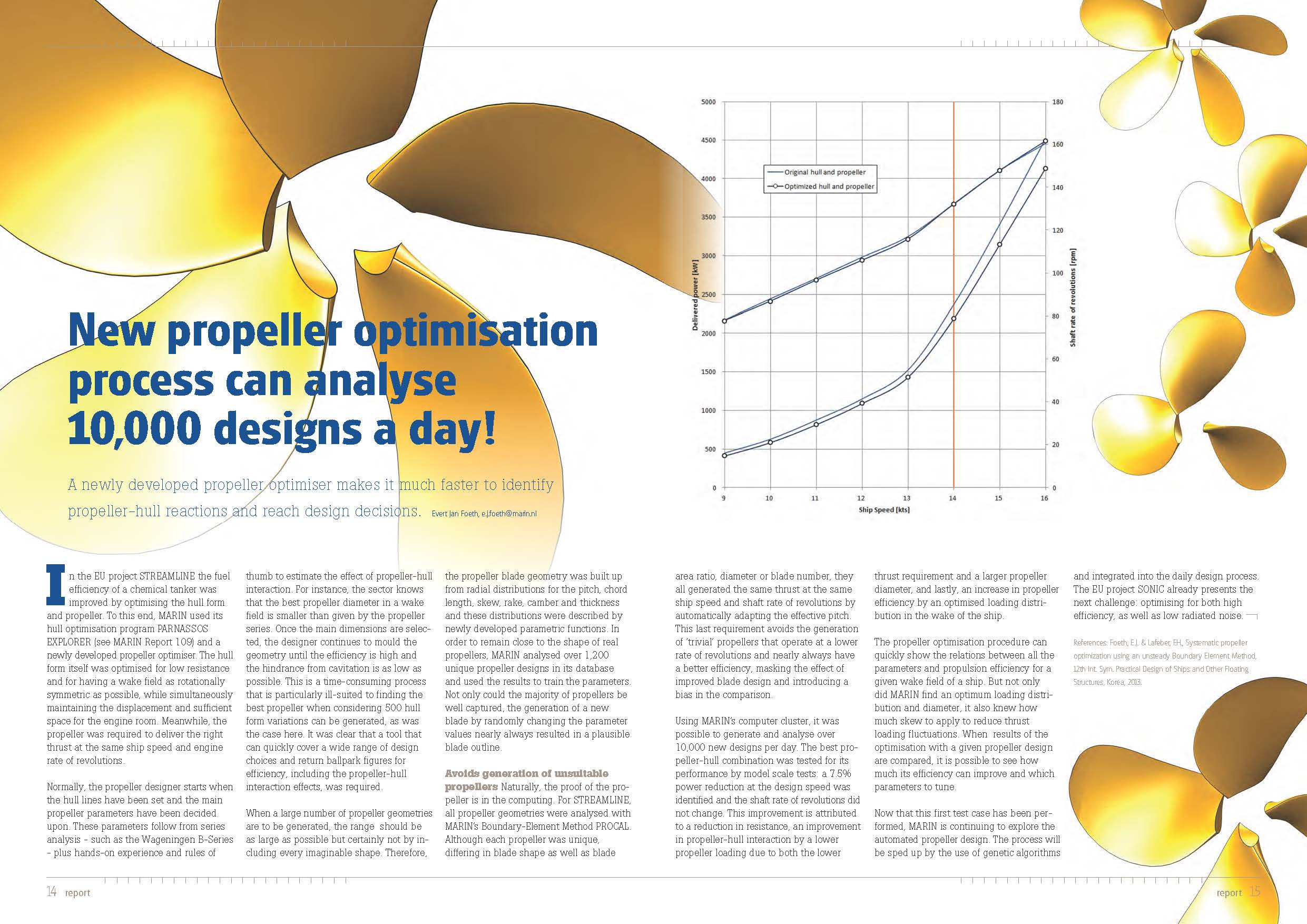
Foeth, Evert-Jan
New propeller optimisation process can analyse 10,000 designs a day! Journal Article
In: MARIN Report, no. 110, pp. 14-15, 2013.
Abstract | Links | BibTeX | Tags: optimiser, propeller design, propeller-hull interaction
@article{Foeth2013,
title = {New propeller optimisation process can analyse 10,000 designs a day!},
author = {Evert-Jan Foeth},
url = {http://www.marin.nl/extra/marin-bladermodules/html/110/#14},
year = {2013},
date = {2013-12-01},
journal = {MARIN Report},
number = {110},
pages = {14-15},
abstract = {A newly developed propeller optimiser makes it much faster to identify propeller-hull reactions and reach design decisions.},
keywords = {optimiser, propeller design, propeller-hull interaction},
pubstate = {published},
tppubtype = {article}
}
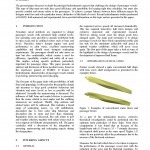
Jaap van Heerd Rob Grin, Victor Ferrari
Hydrodynamic Aspects in the Design of Passenger Vessels Conference
International Conference on Design & Operation of Passenger Ships, London, UK, The Royal Institution of Naval Architects 2013.
Abstract | BibTeX | Tags: comfort, cruise, ferries, maneuvering, passenger, powering, seakeeping
@conference{Grin2013,
title = {Hydrodynamic Aspects in the Design of Passenger Vessels},
author = {Rob Grin, Jaap van Heerd, Victor Ferrari},
year = {2013},
date = {2013-11-20},
booktitle = {International Conference on Design & Operation of Passenger Ships, London, UK},
organization = {The Royal Institution of Naval Architects},
abstract = {The present paper discusses in detail the principal hydrodynamic aspects that challenge the design of passenger vessels. This type of ship must not only have good efficiency and operability for keeping tight time schedules, but must also provide comfort and ensure safety to the passengers. To achieve a proper balance between these different aspects the designer must face and solve particular issues, distinctive of this kind of vessel. Recent hydrodynamic studies performed at MARIN, both numerical and experimental, have provided information on this topic and are presented in this paper.},
keywords = {comfort, cruise, ferries, maneuvering, passenger, powering, seakeeping},
pubstate = {published},
tppubtype = {conference}
}
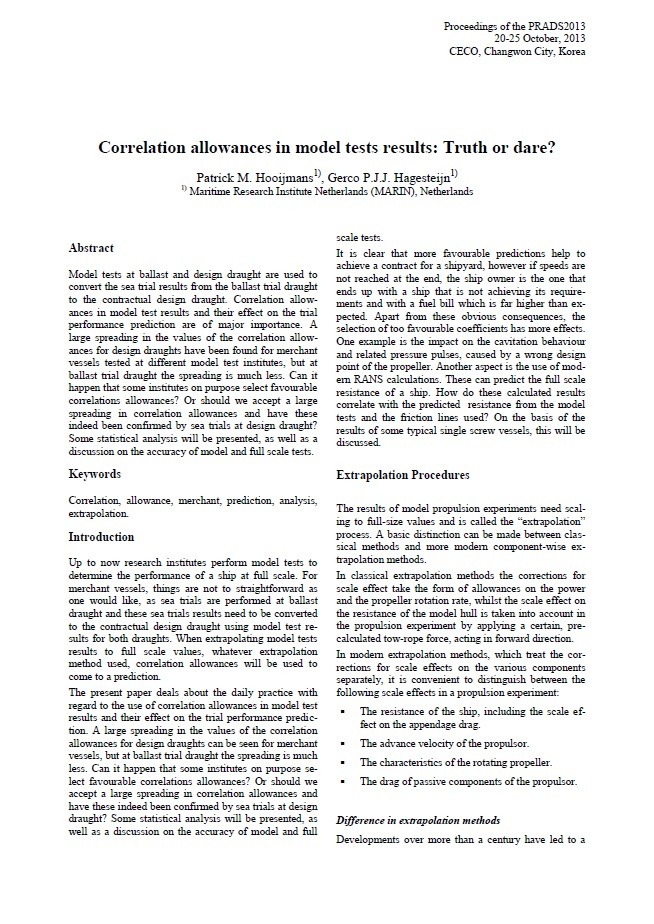
Hooijmans, Patrick; Hagesteijn, Gerco
Correlation allowances in model tests results: Truth or dare? Conference
Proceedings of the PRADS2013, CECO, Changwon City, Korea, Practical Design of Ships and Other Floating Structures 2013.
Abstract | Links | BibTeX | Tags: allowance, analysis, correlation, extrapolation, merchant, prediction
@conference{Hooijmans2013,
title = {Correlation allowances in model tests results: Truth or dare?},
author = {Patrick Hooijmans and Gerco Hagesteijn},
url = {http://test.sssri-marin.com/wp-content/uploads/2016/01/Paper-Correlation-allowances-in-model-tests-results-V1.0.pdf},
year = {2013},
date = {2013-10-20},
booktitle = {Proceedings of the PRADS2013, CECO, Changwon City, Korea},
organization = {Practical Design of Ships and Other Floating Structures},
abstract = {Model tests at ballast and design draught are used to convert the sea trial results from the ballast trial draught to the contractual design draught. Correlation allowances in model test results and their effect on the trial performance prediction are of major importance. A large spreading in the values of the correlation allowances for design draughts have been found for merchant vessels tested at different model test institutes, but at ballast trial draught the spreading is much less. Can it happen that some institutes on purpose select favourable correlations allowances? Or should we accept a large spreading in correlation allowances and have these indeed been confirmed by sea trials at design draught? Some statistical analysis will be presented, as well as a discussion on the accuracy of model and full scale tests.
},
keywords = {allowance, analysis, correlation, extrapolation, merchant, prediction},
pubstate = {published},
tppubtype = {conference}
}
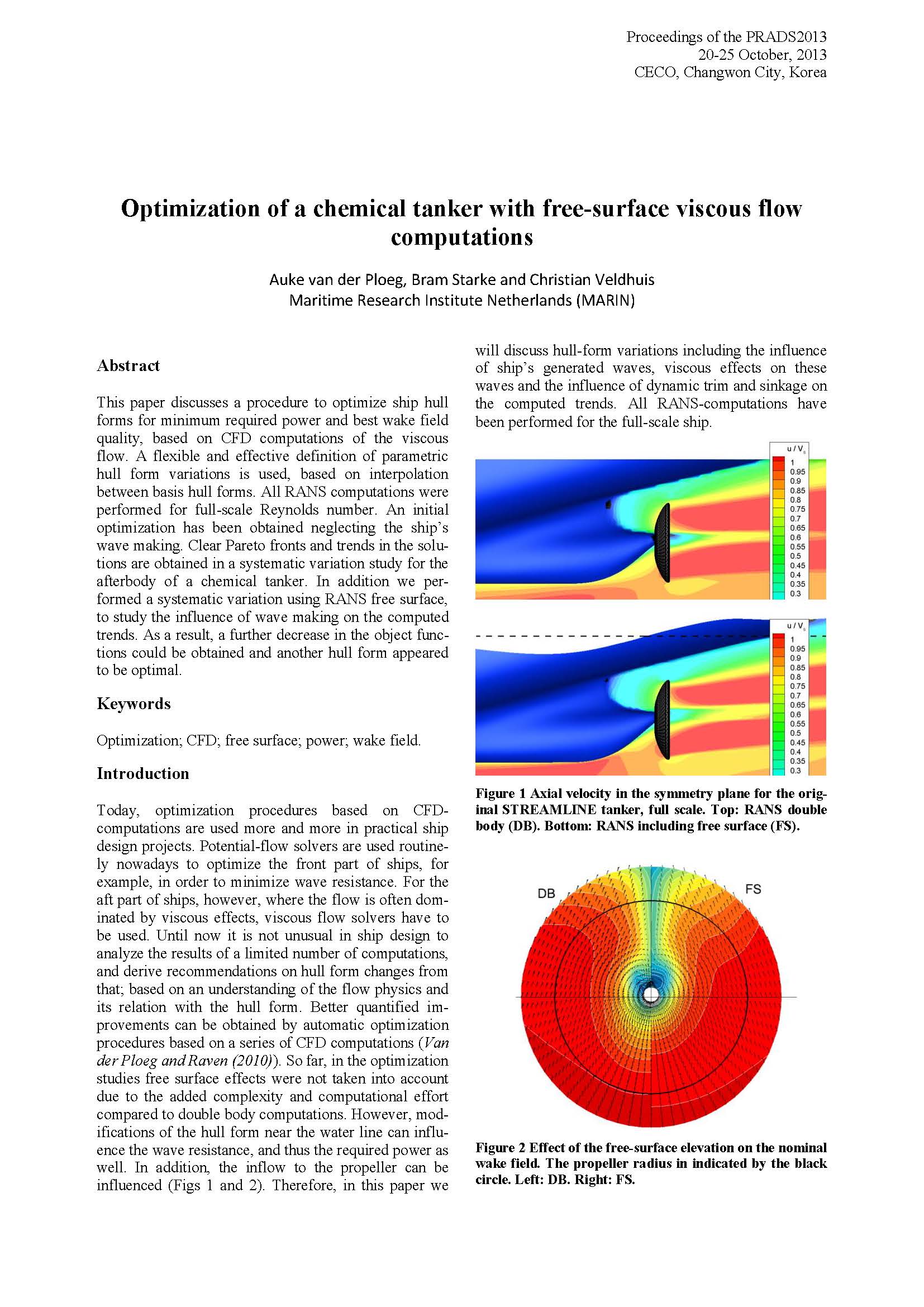
van der Ploeg, Auke; Starke, Bram; Veldhuis, Christian
Optimization of a Chemical Tanker with Free-surface Viscous Flow Computations Conference
Proceedings of the PRADS2013, CECO, Changwon City, Korea, no. 096, Practical Design of Ships and Other Floating Structures 2013.
Abstract | Links | BibTeX | Tags: CFD, Fuel consumption, ship design, tanker
@conference{Ploeg2013,
title = {Optimization of a Chemical Tanker with Free-surface Viscous Flow Computations},
author = {Auke van der Ploeg and Bram Starke and Christian Veldhuis},
url = {http://www.marin.nl/web/Publications/Papers/Optimization-of-a-Chemical-Tanker-with-Freesurface-Viscous-Flow-Computations.htm},
year = {2013},
date = {2013-10-01},
booktitle = {Proceedings of the PRADS2013, CECO, Changwon City, Korea},
journal = {Proceedigs of the PRADS 2013},
number = {096},
organization = {Practical Design of Ships and Other Floating Structures},
abstract = {This paper discusses a procedure to optimize ship hull forms for minimum required power and best wake field quality, based on CFD computations of the viscous flow. A flexible and effective definition of parametric hull form variations is used, based on interpolation between basis hull forms. All RANS computations were performed for full-scale Reynolds number. An initial optimization has been obtained neglecting the ship’s wave making. Clear Pareto fronts and trends in the solutions are obtained in a systematic variation study for the afterbody of a chemical tanker. In addition we performed a systematic variation using RANS free surface, to study the influence of wave making on the computed trends. As a result, a further decrease in the object functions could be obtained and another hull form appeared to be optimal.},
keywords = {CFD, Fuel consumption, ship design, tanker},
pubstate = {published},
tppubtype = {conference}
}
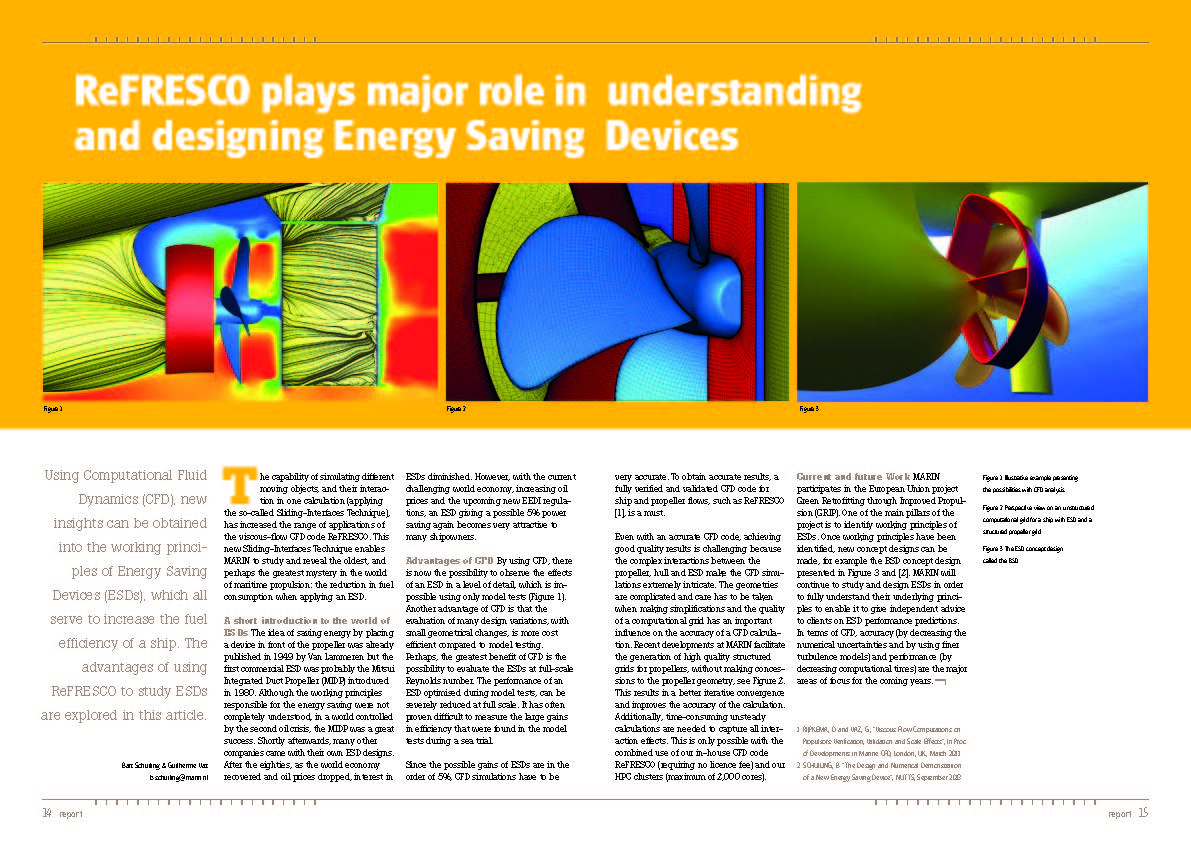
Schuiling, Bart; vaz, Guilherme
ReFRESCO plays major role in understanding and designing Energy Saving Devices Journal Article
In: MARIN Report, no. 109, pp. 14-15, 2013.
Abstract | Links | BibTeX | Tags: CFD, Energy Saving Device, ESD, ReFRESCO
@article{Schuiling2013,
title = {ReFRESCO plays major role in understanding and designing Energy Saving Devices},
author = {Bart Schuiling and Guilherme vaz},
url = {http://www.marin.nl/extra/marin-bladermodules/html/109/#14},
year = {2013},
date = {2013-08-01},
journal = {MARIN Report},
number = {109},
pages = {14-15},
abstract = {Using Computational Fluid Dynamics (CFD), new insights can be obtained into the working principles of Energy Saving Devices (ESDs), which all serve to increase the fuel efficiency of a ship. The advantages of using ReFRESCO to study ESDs are explored in this article.},
keywords = {CFD, Energy Saving Device, ESD, ReFRESCO},
pubstate = {published},
tppubtype = {article}
}
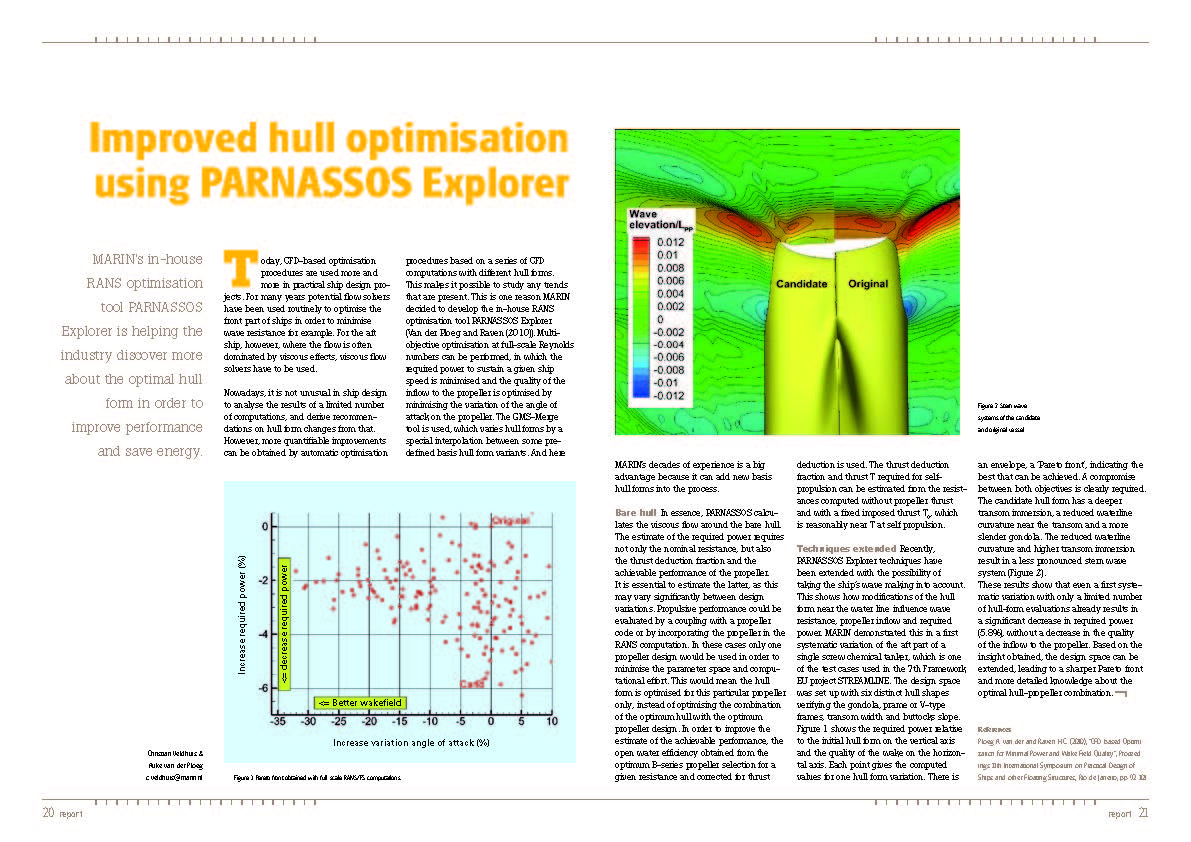
Veldhuis, Christian; van der Ploeg, Auke
Improved hull optimisation using PARNASSOS Explorer Journal Article
In: MARIN Report, no. 109, pp. 20-21, 2013.
Abstract | Links | BibTeX | Tags: CFD, Explorer, improve performance, PARNASSOS, RANS, save engergy
@article{Veldhuis2013,
title = {Improved hull optimisation using PARNASSOS Explorer},
author = {Christian Veldhuis and Auke van der Ploeg},
url = {http://www.marin.nl/extra/marin-bladermodules/html/109/#20},
year = {2013},
date = {2013-08-01},
journal = {MARIN Report},
number = {109},
pages = {20-21},
abstract = {MARIN’s inhouse RANS optimisation tool PARNASSOS Explorer is helping the industry discover more about the optimal hull form in order to improve performance and save energy.},
keywords = {CFD, Explorer, improve performance, PARNASSOS, RANS, save engergy},
pubstate = {published},
tppubtype = {article}
}
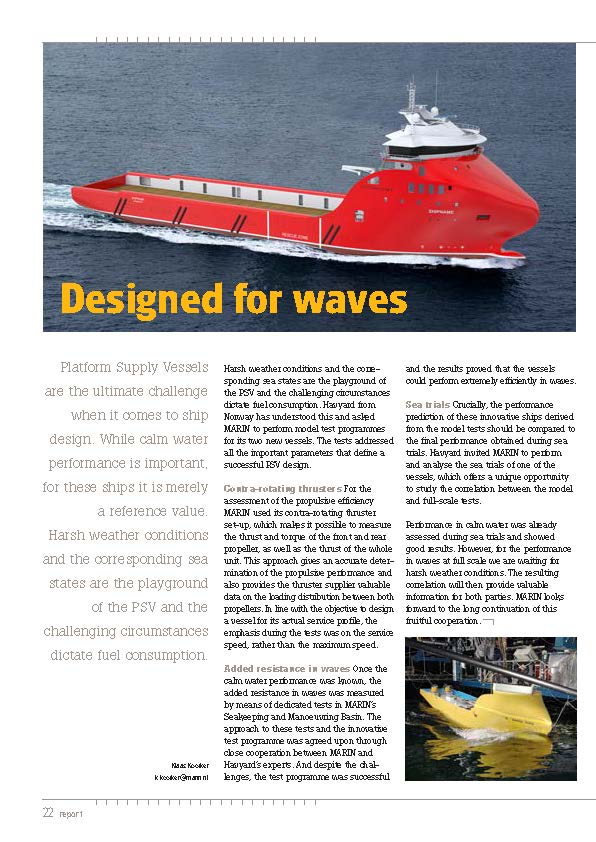
Kooiker, Klaas
Designed for Waves Journal Article
In: MARIN Report, no. 109, pp. 22, 2013.
Abstract | Links | BibTeX | Tags: added resistance in waves, Contra-rotating thrusters, Fuel consumption, harsh weather, Platform Supply Vessel, PSV
@article{Kooiker2013,
title = {Designed for Waves},
author = {Klaas Kooiker},
url = {http://www.marin.nl/extra/marin-bladermodules/html/109/#22},
year = {2013},
date = {2013-08-01},
journal = {MARIN Report},
number = {109},
pages = {22},
abstract = {Platform Supply Vessels are the ultimate challenge when it comes to ship design. While calm water performance is important, for these ships it is merely a reference value. Harsh weather conditions and the corresponding sea states are the playground of the PSV and the challenging circumstances dictate fuel consumption.},
keywords = {added resistance in waves, Contra-rotating thrusters, Fuel consumption, harsh weather, Platform Supply Vessel, PSV},
pubstate = {published},
tppubtype = {article}
}
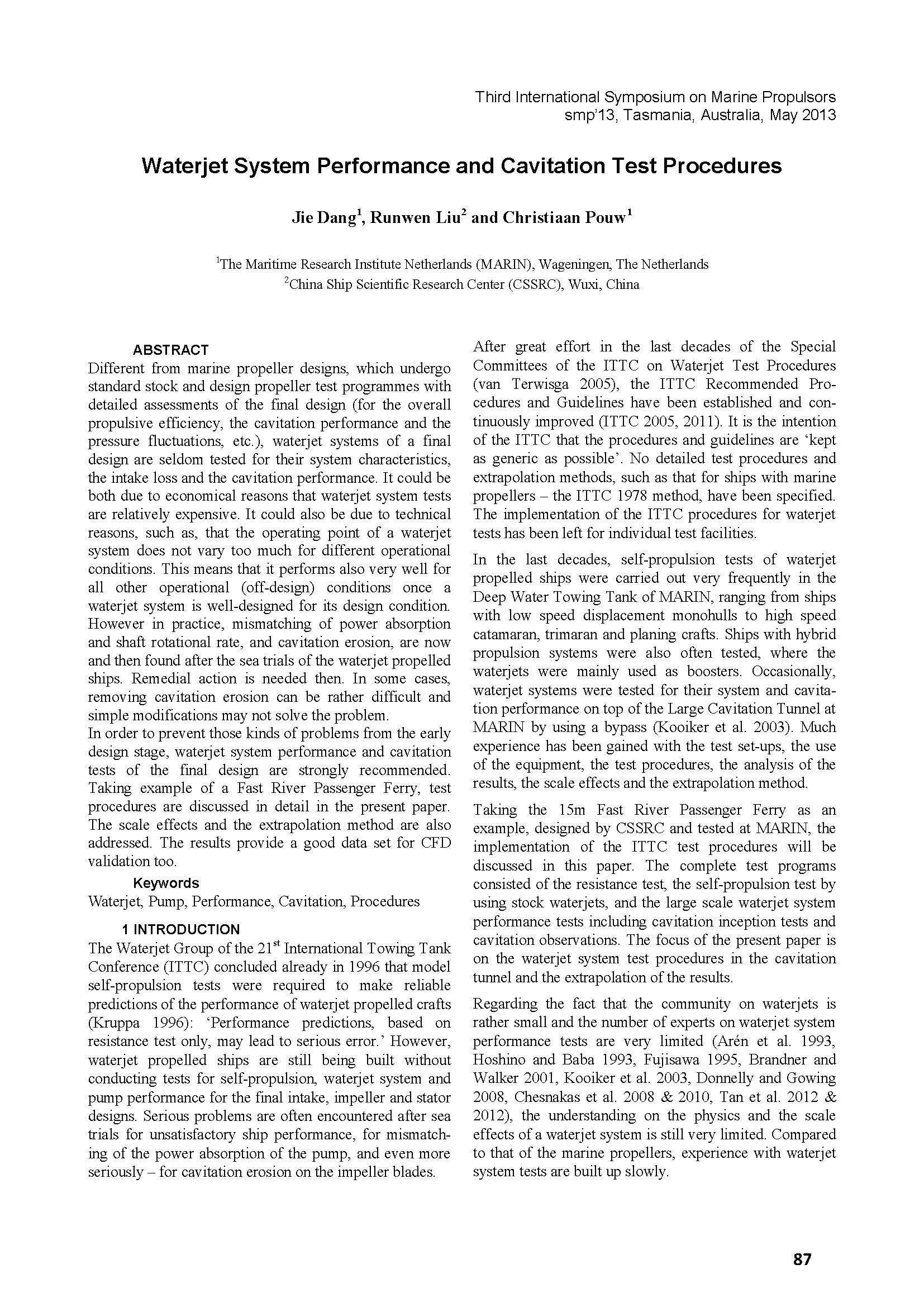
Dang, Jie; Liu, Runwen; Pouw, Christiaan
Waterjet System Performance and Cavitation Test Procedures Conference
Proceedings of third International Symposium on Marine Propulsors (smp’13), Tasmania, Australia, SMP'13 2013.
Abstract | Links | BibTeX | Tags: cavitation, CFD, procedures, waterjet
@conference{Dang2013b,
title = {Waterjet System Performance and Cavitation Test Procedures},
author = {Jie Dang and Runwen Liu and Christiaan Pouw},
url = {http://www.marin.nl/web/Publications/Papers/Waterjet-System-Performance-and-Cavitation-Test-Procedures.htm
http://www.marinepropulsors.com/proceedings/2013/2B.1.pdf},
year = {2013},
date = {2013-05-05},
booktitle = {Proceedings of third International Symposium on Marine Propulsors (smp’13), Tasmania, Australia},
organization = {SMP'13},
abstract = {Different from marine propeller designs, which undergo standard stock and design propeller test programmes with detailed assessments of the final design (for the overall propulsive efficiency, the cavitation performance and the pressure fluctuations, etc.), waterjet systems of a final design are seldom tested for their system characteristics, the intake loss and the cavitation performance. It could be both due to economical reasons that waterjet system tests are relatively expensive. It could also be due to technical reasons, such as, that the operating point of a waterjet system does not vary too much for different operational conditions. This means that it performs also very well for all other operational (off-design) conditions once a waterjet system is well-designed for its design condition. However in practice, mismatching of power absorption and shaft rotational rate, and cavitation erosion, are now and then found after the sea trials of the waterjet propelled ships. Remedial action is needed then. In some cases, removing cavitation erosion can be rather difficult and simple modifications may not solve the problem.
In order to prevent those kinds of problems from the early design stage, waterjet system performance and cavitation tests of the final design are strongly recommended. Taking example of a Fast River Passenger Ferry, test procedures are discussed in detail in the present paper. The scale effects and the extrapolation method are also addressed. The results provide a good data set for CFD validation too. },
keywords = {cavitation, CFD, procedures, waterjet},
pubstate = {published},
tppubtype = {conference}
}
In order to prevent those kinds of problems from the early design stage, waterjet system performance and cavitation tests of the final design are strongly recommended. Taking example of a Fast River Passenger Ferry, test procedures are discussed in detail in the present paper. The scale effects and the extrapolation method are also addressed. The results provide a good data set for CFD validation too.
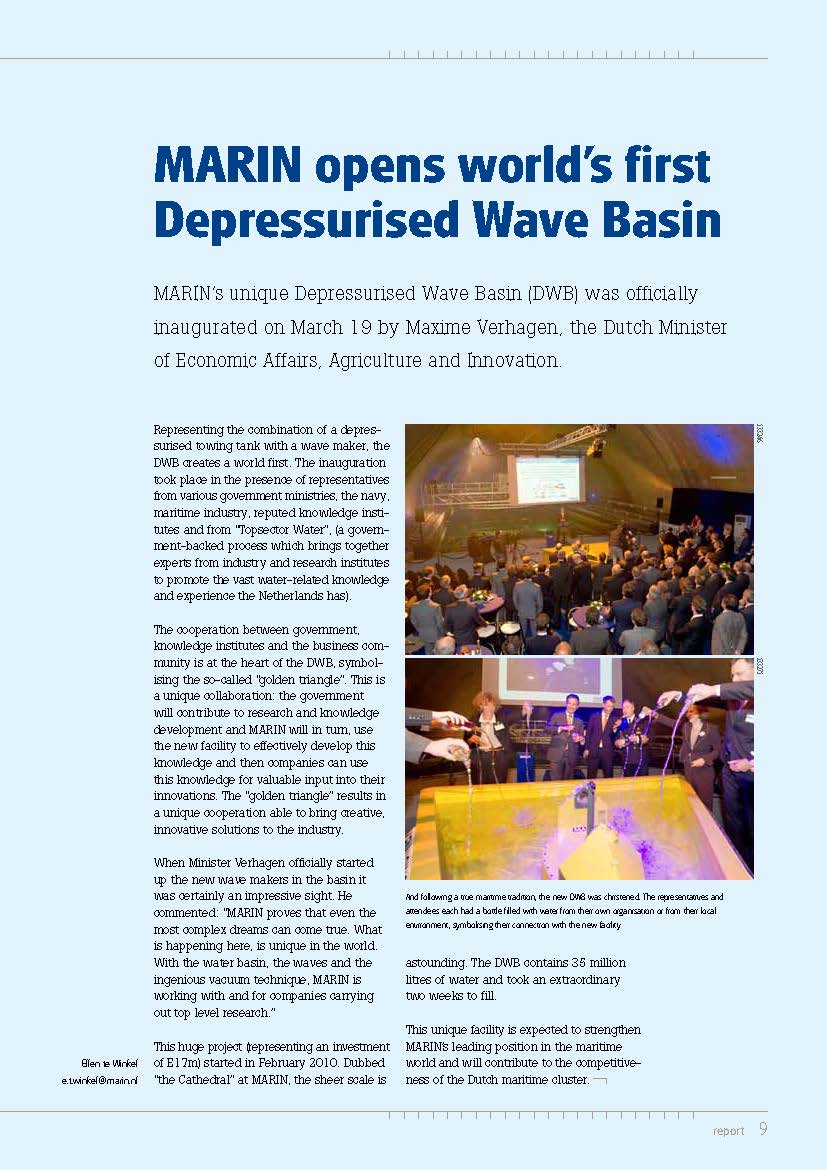
te Winkel, Ellen
MARIN opens world’s first Depressurised Wave Basin Journal Article
In: MARIN Report, no. 105, pp. 9, 2013.
Abstract | Links | BibTeX | Tags: Depressurised Wave Basin, DWB, model basin
@article{Winkel2013,
title = {MARIN opens world’s first Depressurised Wave Basin},
author = {Ellen te Winkel},
url = {http://www.marin.nl/web/Publications/Publication-items/MARIN-opens-worlds-first-Depressurised-Wave-Basin.htm},
year = {2013},
date = {2013-04-01},
journal = {MARIN Report},
number = {105},
pages = {9},
abstract = {MARIN’s unique Depressurised Wave Basin (DWB) was officially inaugurated on March 19 by Maxime Verhagen, the Dutch Minister of Economic Affairs, Agriculture and Innovation.},
keywords = {Depressurised Wave Basin, DWB, model basin},
pubstate = {published},
tppubtype = {article}
}
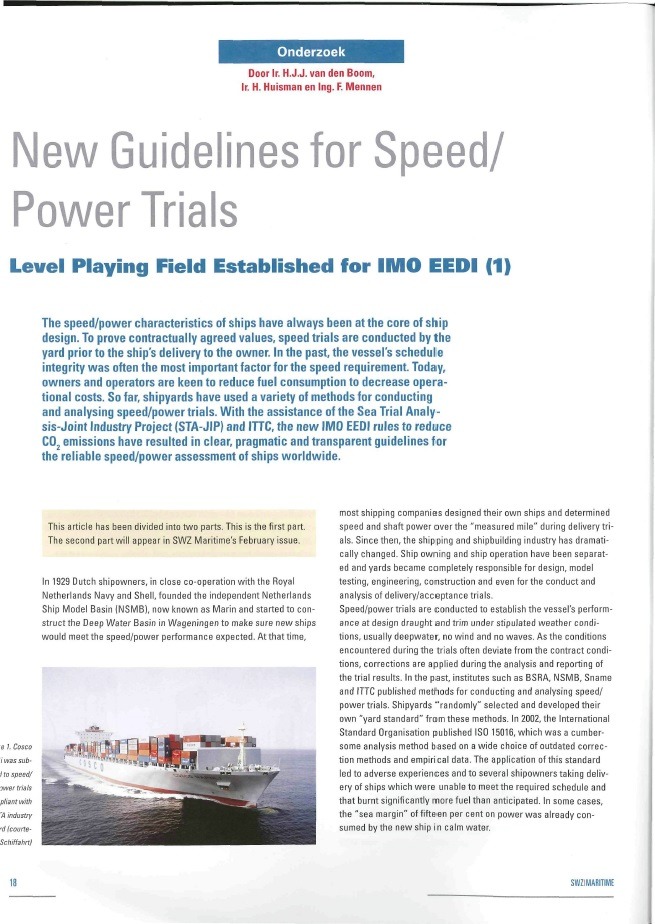
van den Boom, Henk; Huisman, Rene; Mennen, Frits
New Guidelines for Speed/ Power Trials Journal Article
In: SWZ Maritime, pp. 19-22, 2013.
Abstract | Links | BibTeX | Tags: full scale, STA JIP, trial
@article{Boom2013,
title = {New Guidelines for Speed/ Power Trials},
author = {Henk van den Boom and Rene Huisman and Frits Mennen },
url = {http://www.marin.nl/web/JIPs-Networks/Public/STA.htm
http://www.staimo.com/},
year = {2013},
date = {2013-01-30},
journal = {SWZ Maritime},
pages = {19-22},
abstract = {The speed/power characteristics of ships have always been at the core of ship design. To prove contractually agreed values, speed trials are conducted by the yard prior to the ship's delivery to the owner. In the past, the vessel's schedule integrity was often the most important factor for the speed requirement. Today, owners and operators are keen to reduce fuel consumption to decrease operational costs. So far, shipyards have used a variety of methods for conducting and analysing speed/power trials. With the assistance of the Sea Trial Analysis-Joint Industry Project (STA-JIP) and ITTC, the new IMO EEDI rules to reduce C02 emissions have resulted in clear, pragmatic and transparent guidelines for the reliable speed/power assessment of ships worldwide. },
keywords = {full scale, STA JIP, trial},
pubstate = {published},
tppubtype = {article}
}
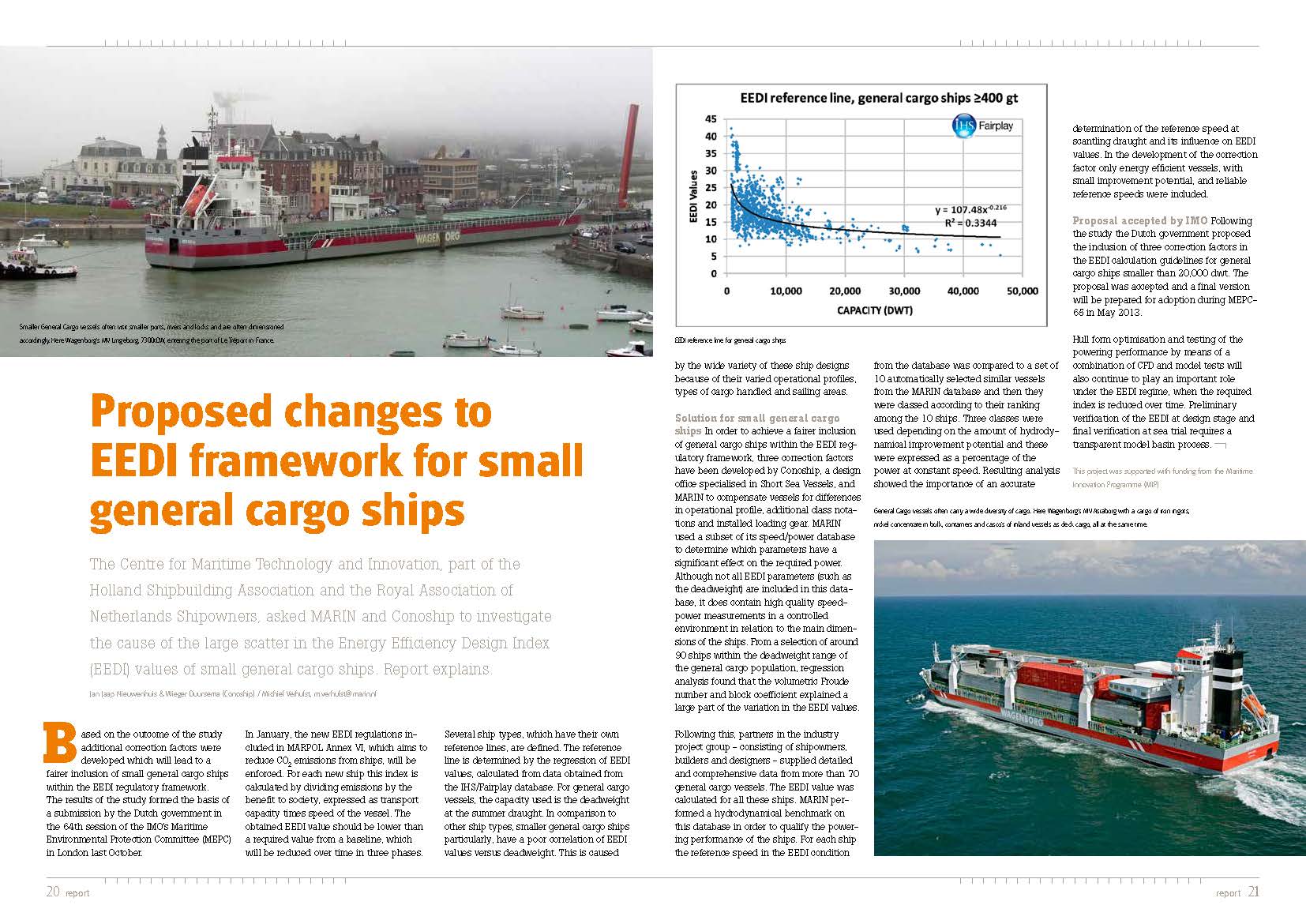
Nieuwenhuis, Jan Jaap; Duursema, Wieger; Verhulst, Michiel
Proposed changes to EEDI framework for small general cargo ships Journal Article
In: MARIN Report, no. 107, pp. 20-21, 2013.
Abstract | Links | BibTeX | Tags: EEDI, general cargo, minimal power requirement
@article{Verhulst2013,
title = {Proposed changes to EEDI framework for small general cargo ships},
author = {Jan Jaap Nieuwenhuis and Wieger Duursema and Michiel Verhulst},
url = {http://www.marin.nl/web/Publications/Publication-items/Proposed-changes-to-EEDI-framework-for-small-general-cargo-ships.htm},
year = {2013},
date = {2013-01-01},
journal = {MARIN Report},
number = {107},
pages = {20-21},
abstract = {The Centre for Maritime Technology and Innovation, part of the Holland Shipbuilding Association and the Royal Association of Netherlands Shipowners, asked MARIN and Conoship to investigate the cause of the large scatter in the Energy Efficiency Design Index (EEDI) values of small general cargo ships. Report explains.},
keywords = {EEDI, general cargo, minimal power requirement},
pubstate = {published},
tppubtype = {article}
}
2012
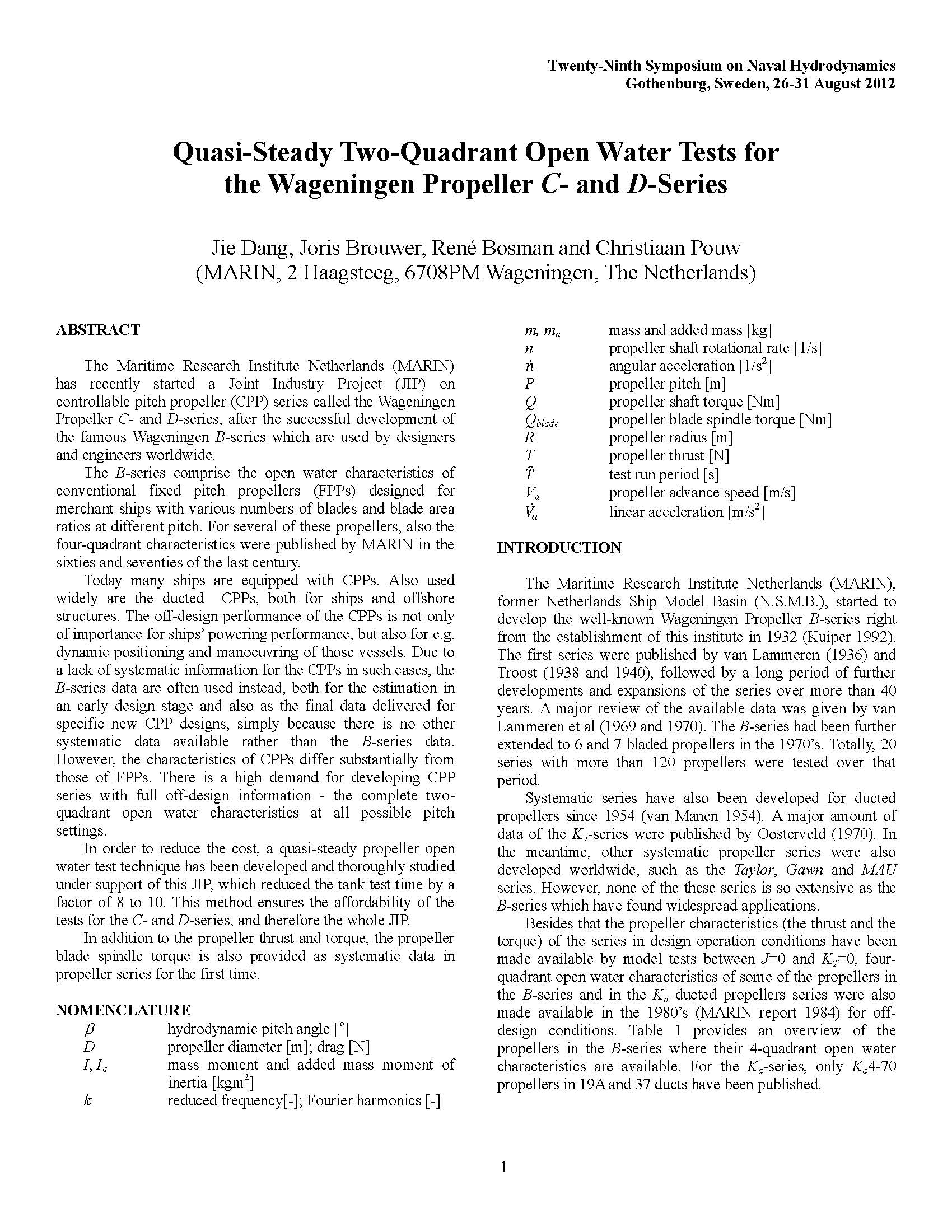
Dang, Jie; Brouwer, Joris; Bosman, Rene; Pouw, Christiaan
Quasi-Steady Two-Quadrant Open Water Tests for the Wageningen Propeller C- and D-Series Conference
29th Symposium on Naval Hydrodynamics, Gothenburg, Sweden , Symposium on Naval Hydrodynamics 2012.
Abstract | Links | BibTeX | Tags: open water, propellers, quasi-steady, series, two quadrant
@conference{Dang2012,
title = {Quasi-Steady Two-Quadrant Open Water Tests for the Wageningen Propeller C- and D-Series},
author = {Jie Dang and Joris Brouwer and Rene Bosman and Christiaan Pouw },
url = {http://www.marin.nl/web/Publications/Papers/QuasiSteady-TwoQuadrant-Open-Water-Tests-for-the-Wageningen-Propeller-C-and-DSeries.htm},
year = {2012},
date = {2012-08-26},
booktitle = {29th Symposium on Naval Hydrodynamics, Gothenburg, Sweden },
organization = {Symposium on Naval Hydrodynamics},
abstract = {MARIN has recently started a Joint Industry Project (JIP) on controllable pitch propeller (CPP) series called the Wageningen Propeller C- and D-series, after the successful development of the famous Wageningen B-series which are used by designers and engineers worldwide.
The B-series comprise the open water characteristics of conventional fixed pitch propellers (FPPs) designed for merchant ships with various numbers of blades and blade area ratios at different pitch. For several of these propellers, also the four-quadrant characteristics were published by MARIN in the sixties and seventies of the last century.
Today many ships are equipped with CPPs. Also used widely are the ducted CPPs, both for ships and offshore structures. The off-design performance of the CPPs is not only of importance for ships’ powering performance, but also for e.g. dynamic positioning and manoeuvring of those vessels. Due to a lack of systematic information for the CPPs in such cases, the B-series data are often used instead, both for the estimation in an early design stage and also as the final data delivered for specific new CPP designs, simply because there is no other systematic data available rather than the B-series data. However, the characteristics of CPPs differ substantially from those of FPPs. There is a high demand for developing CPP series with full off-design information - the complete two-quadrant open water characteristics at all possible pitch settings.
In order to reduce the cost, a quasi-steady propeller open water test technique has been developed and thoroughly studied under support of this JIP, which reduced the tank test time by a factor of 8 to 10. This method ensures the affordability of the tests for the C- and D-series, and therefore the whole JIP.
In addition to the propeller thrust and torque, the propeller blade spindle torque is also provided as systematic data in propeller series for the first time. },
keywords = {open water, propellers, quasi-steady, series, two quadrant},
pubstate = {published},
tppubtype = {conference}
}
The B-series comprise the open water characteristics of conventional fixed pitch propellers (FPPs) designed for merchant ships with various numbers of blades and blade area ratios at different pitch. For several of these propellers, also the four-quadrant characteristics were published by MARIN in the sixties and seventies of the last century.
Today many ships are equipped with CPPs. Also used widely are the ducted CPPs, both for ships and offshore structures. The off-design performance of the CPPs is not only of importance for ships’ powering performance, but also for e.g. dynamic positioning and manoeuvring of those vessels. Due to a lack of systematic information for the CPPs in such cases, the B-series data are often used instead, both for the estimation in an early design stage and also as the final data delivered for specific new CPP designs, simply because there is no other systematic data available rather than the B-series data. However, the characteristics of CPPs differ substantially from those of FPPs. There is a high demand for developing CPP series with full off-design information - the complete two-quadrant open water characteristics at all possible pitch settings.
In order to reduce the cost, a quasi-steady propeller open water test technique has been developed and thoroughly studied under support of this JIP, which reduced the tank test time by a factor of 8 to 10. This method ensures the affordability of the tests for the C- and D-series, and therefore the whole JIP.
In addition to the propeller thrust and torque, the propeller blade spindle torque is also provided as systematic data in propeller series for the first time.
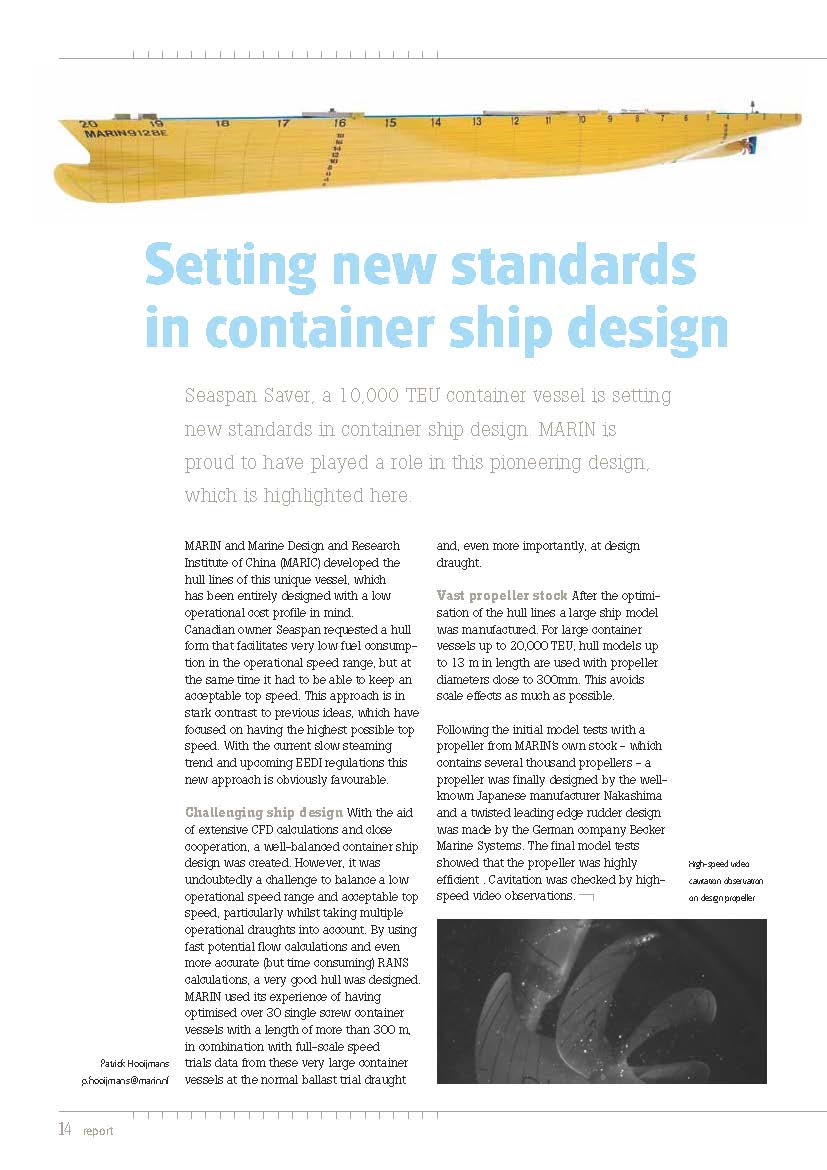
Hooijmans, Patrick
Setting new standards in container ship design Journal Article
In: MARIN Report, no. 106, pp. 14, 2012.
Abstract | Links | BibTeX | Tags: 20000TEU, cavitation, CFD, containerships
@article{Hooijmans2012b,
title = {Setting new standards in container ship design},
author = {Patrick Hooijmans},
url = {http://www.marin.nl/web/Publications/Publication-items/Setting-new-standards-in-container-ship-design.htm},
year = {2012},
date = {2012-08-01},
journal = {MARIN Report},
number = {106},
pages = {14},
abstract = {Seaspan Saver, a 10,000 TEU container vessel is setting new standards in container ship design. MARIN is proud to have played a role in this pioneering design, which is highlighted here.},
keywords = {20000TEU, cavitation, CFD, containerships},
pubstate = {published},
tppubtype = {article}
}
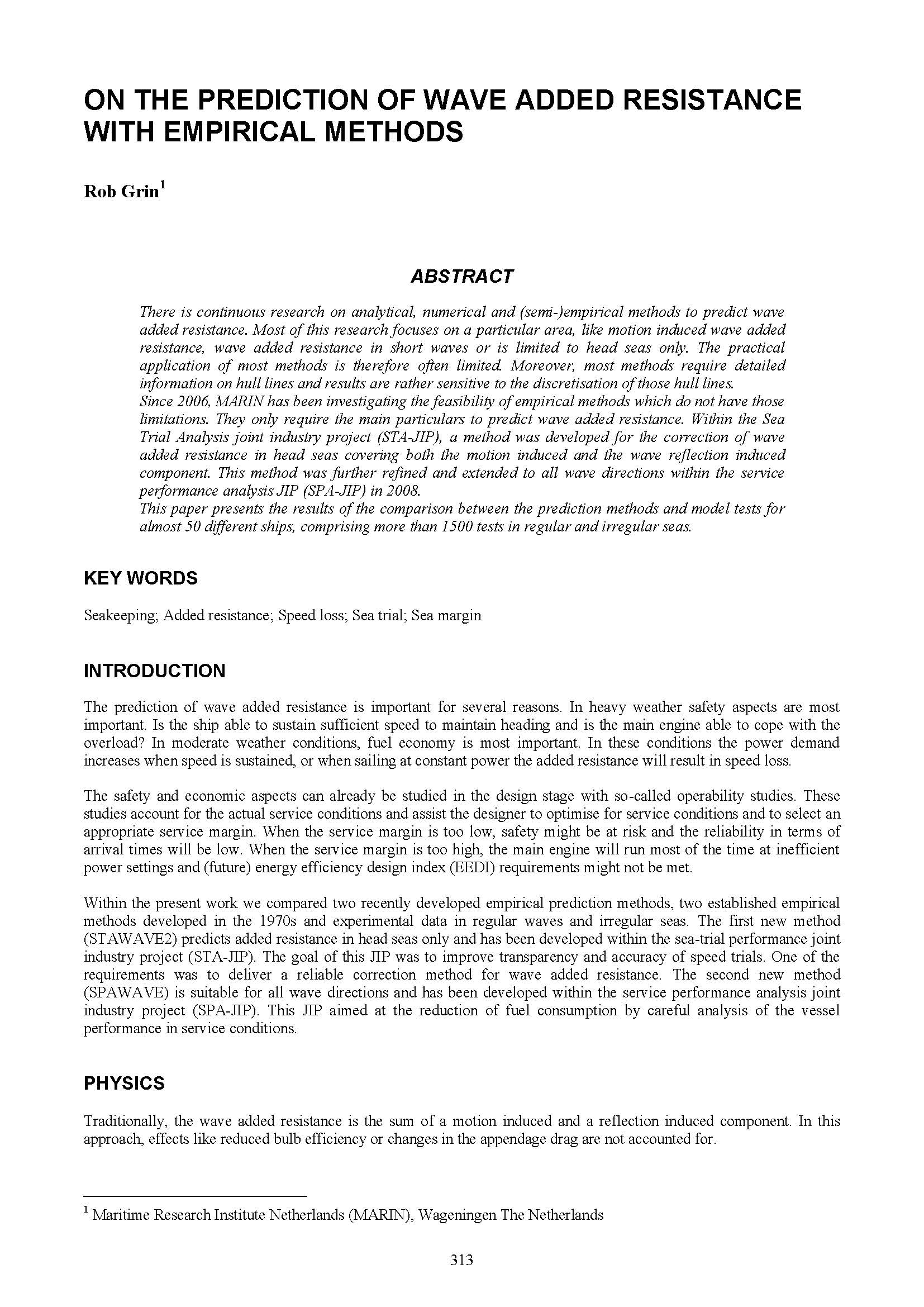
Grin, Rob
On The Prediction Of Wave Added Resistance Conference
11th International Marine Design Conference (IMDC), Glasgow, UK, 2012.
Abstract | Links | BibTeX | Tags: added resistance in waves, sea margin, sea trial, seakeeping, speed loss, STA JIP
@conference{Grin2012,
title = {On The Prediction Of Wave Added Resistance},
author = {Rob Grin},
url = {http://www.marin.nl/web/News/News-items/On-The-Prediction-Of-Wave-Added-Resistance.htm
},
year = {2012},
date = {2012-06-11},
booktitle = {11th International Marine Design Conference (IMDC), Glasgow, UK},
abstract = {There is continuous research on analytical, numerical and (semi-)empirical methods to predict wave added resistance. Most of this research focuses on a particular area, like motion induced wave added resistance, wave added resistance in short waves or is limited to head seas only. The practical application of most methods is therefore often limited. Moreover, most methods require detailed information on hull lines and results are rather sensitive to the discretisation of those hull lines. Since 2006, MARIN has been investigating the feasibility of empirical methods which do not have those limitations. They only require the main particulars to predict wave added resistance. Within the Sea Trial Analysis joint industry project (STA-JIP), a method was developed for the correction of wave added resistance in head seas covering both the motion induced and the wave reflection induced component. This method was further refined and extended to all wave directions within the service performance analysis JIP (SPA-JIP) in 2008.
This paper presents the results of the comparison between the prediction methods and model tests for almost 50 different ships, comprising more than 1500 tests in regular and irregular seas.},
keywords = {added resistance in waves, sea margin, sea trial, seakeeping, speed loss, STA JIP},
pubstate = {published},
tppubtype = {conference}
}
This paper presents the results of the comparison between the prediction methods and model tests for almost 50 different ships, comprising more than 1500 tests in regular and irregular seas.
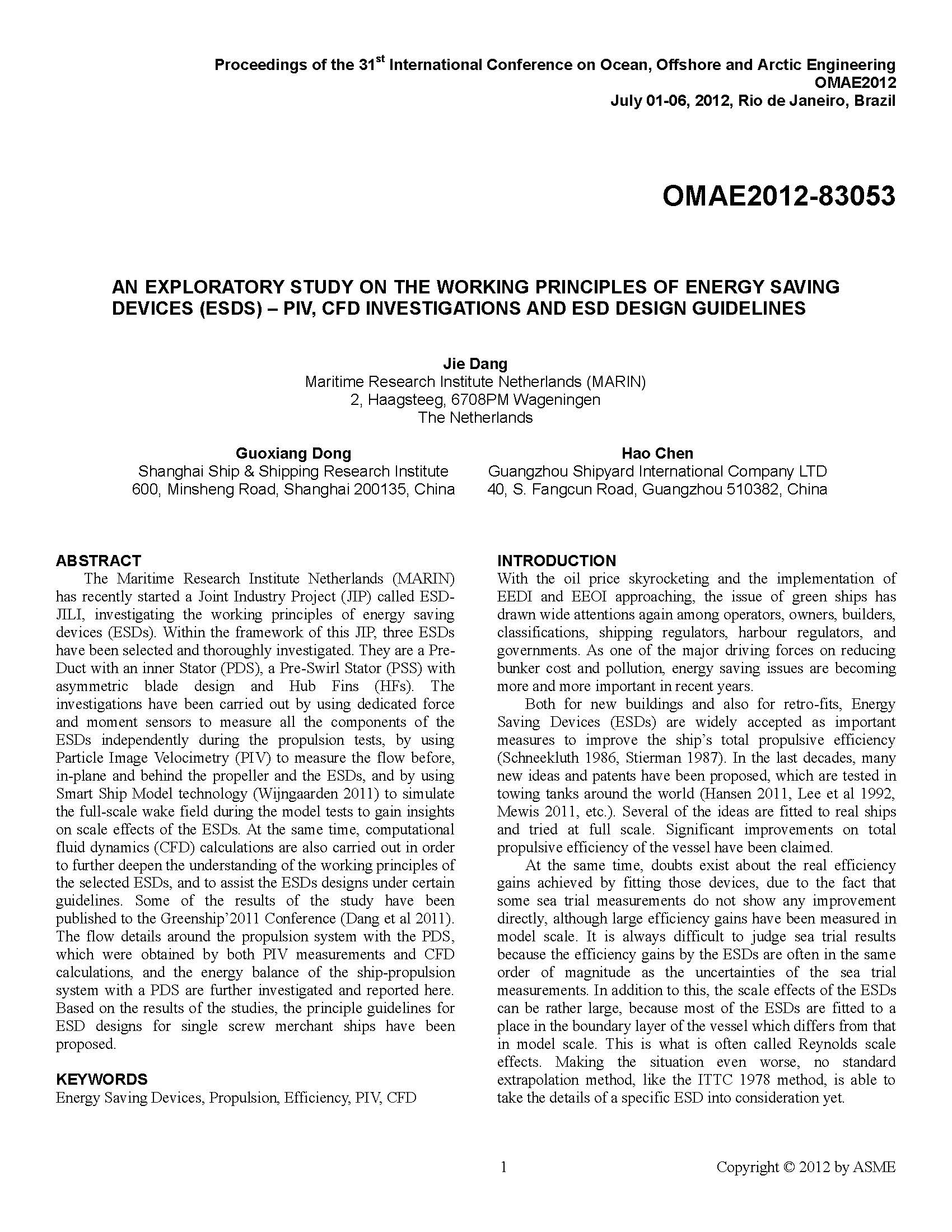
Dang, Jie
Proceedings of the 31st International Conference on Ocean, Offshore and Arctic Engineering, Rio de Janeiro, Brazil , no. OMAE2012-83053 , ASME - OMAE2012 2012.
Abstract | Links | BibTeX | Tags: CFD, ESD, Fuel consumption
@conference{Dang2012b,
title = {An Exploratory Study on the Working Principles of Energy Saving Devices (ESDS) - PIV, CFD Investigations and ESD Design Guidelines},
author = {Jie Dang},
url = {http://www.marin.nl/web/Publications/Papers/An-Exploratory-Study-on-the-Working-Principles-of-Energy-Saving-Devices-ESDS-PIV-CFD-Investigations-and-ESD-Design-Guidelines-1.htm},
year = {2012},
date = {2012-06-01},
booktitle = {Proceedings of the 31st International Conference on Ocean, Offshore and Arctic Engineering, Rio de Janeiro, Brazil },
number = {OMAE2012-83053 },
organization = {ASME - OMAE2012},
abstract = {The Maritime Research Institute Netherlands (MARIN) has recently started a Joint Industry Project (JIP) called ESD-JILI, investigating the working principles of energy saving devices (ESDs). Within the framework of this JIP, three ESDs have been selected and thoroughly investigated. They are a Pre-Duct with an inner Stator (PDS), a Pre-Swirl Stator (PSS) with asymmetric blade design and Hub Fins (HFs). The investigations have been carried out by using dedicated force and moment sensors to measure all the components of the ESDs independently during the propulsion tests, by using Particle Image Velocimetry (PIV) to measure the flow before, in-plane and behind the propeller and the ESDs, and by using Smart Ship Model technology (Wijngaarden 2011) to simulate the full-scale wake field during the model tests to gain insights on scale effects of the ESDs. At the same time, computational fluid dynamics (CFD) calculations are also carried out in order to further deepen the understanding of the working principles of the selected ESDs, and to assist the ESDs designs under certain guidelines. Some of the results of the study have been published to the Greenship’2011 Conference (Dang et al 2011). The flow details around the propulsion system with the PDS, which were obtained by both PIV measurements and CFD calculations, and the energy balance of the ship-propulsion system with a PDS are further investigated and reported here. Based on the results of the studies, the principle guidelines for ESD designs for single screw merchant ships have been proposed. },
keywords = {CFD, ESD, Fuel consumption},
pubstate = {published},
tppubtype = {conference}
}
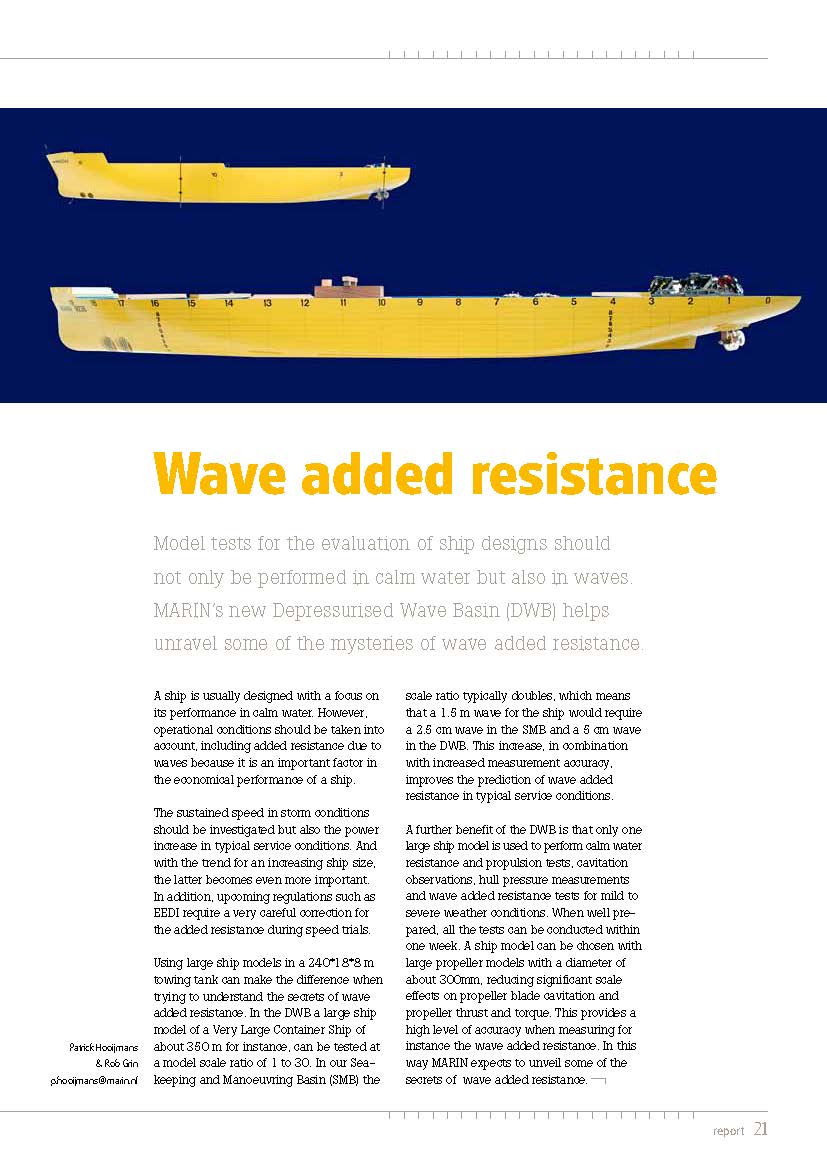
Hooijmans, Patrick; Grin, Rob
Wave added resistance Journal Article
In: MARIN Report, no. 105, pp. 21, 2012.
Abstract | Links | BibTeX | Tags: added resistance in waves, containerships, DWB, ship design
@article{Hooijmans2012,
title = {Wave added resistance},
author = {Patrick Hooijmans and Rob Grin},
url = {http://www.marin.nl/web/Publications/Publication-items/Wave-added-resistance.htm},
year = {2012},
date = {2012-04-01},
journal = {MARIN Report},
number = {105},
pages = {21},
abstract = {Model tests for the evaluation of ship designs should not only be performed in calm water but also in waves. MARIN’s new Depressurised Wave Basin (DWB) helps unravel some of the mysteries of wave added resistance.},
keywords = {added resistance in waves, containerships, DWB, ship design},
pubstate = {published},
tppubtype = {article}
}
2011
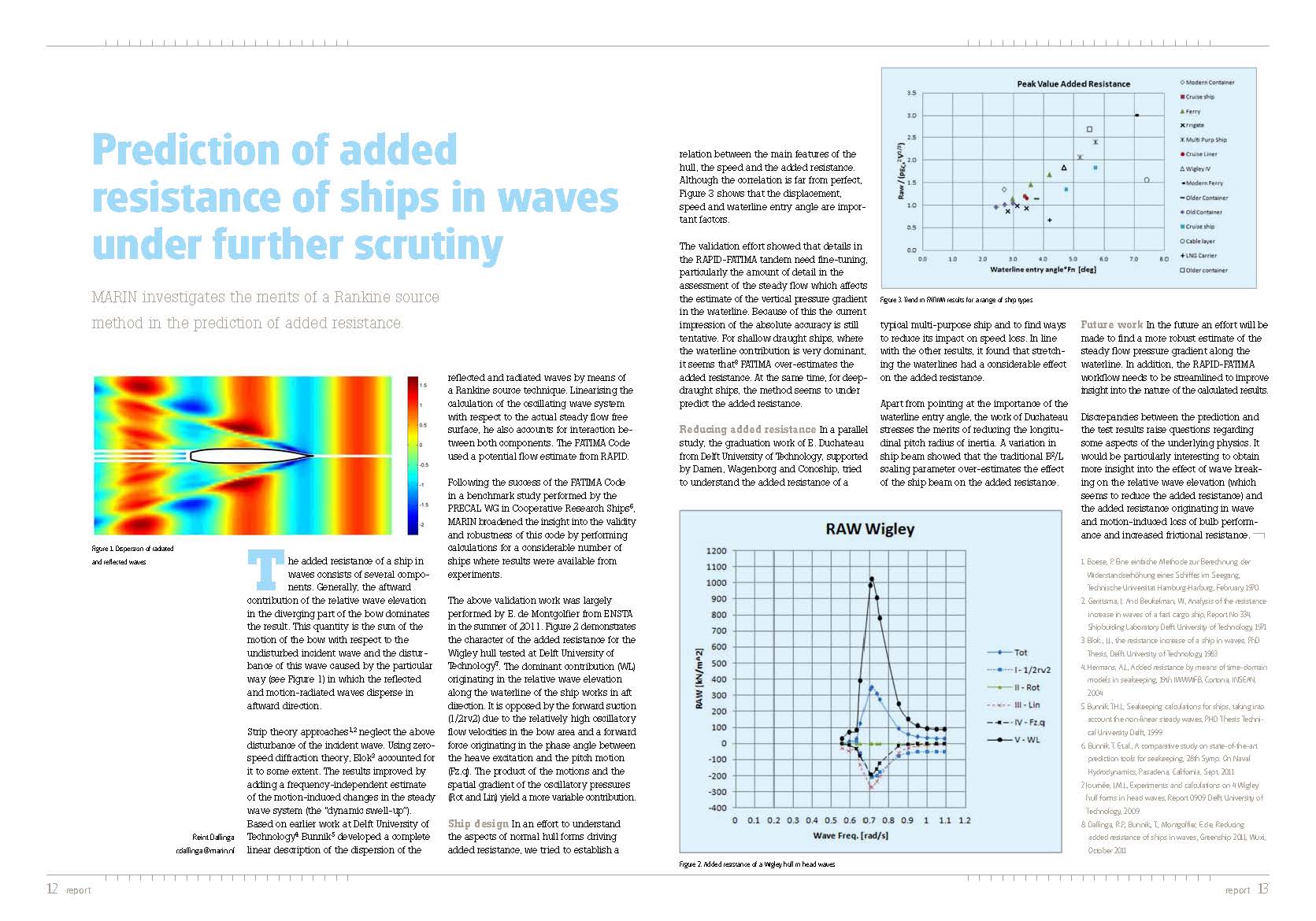
Dallinga, Reint
Prediction of added resistance of ships in waves under further scrutiny Journal Article
In: MARIN Report, no. 104, pp. 12-13, 2011.
Abstract | Links | BibTeX | Tags: added resistance in waves, CFD, motions, seakeeping
@article{Dallinga2011,
title = {Prediction of added resistance of ships in waves under further scrutiny},
author = {Reint Dallinga},
url = {http://www.marin.nl/web/Publications/Publication-items/Prediction-of-added-resistance-of-ships-in-waves-under-further-scrutiny.htm},
year = {2011},
date = {2011-12-01},
journal = {MARIN Report},
number = {104},
pages = {12-13},
institution = {MARIN },
abstract = {MARIN investigates the merits of a Rankine source method in the prediction of added resistance.},
keywords = {added resistance in waves, CFD, motions, seakeeping},
pubstate = {published},
tppubtype = {article}
}
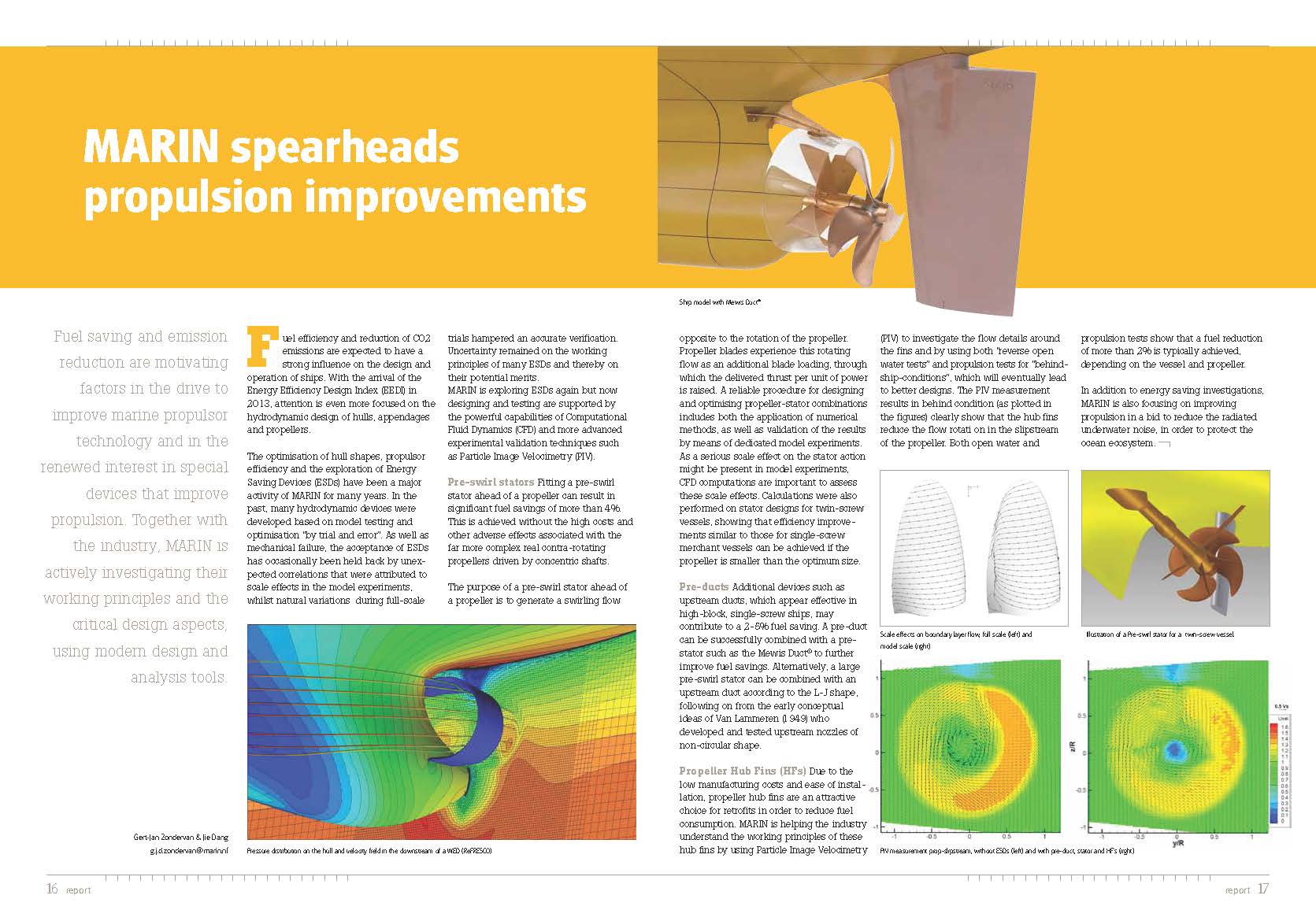
Zondervan, Gert-Jan; Dang, Jie
MARIN spearheads propulsion improvements Journal Article
In: MARIN Report, no. 104, pp. 16-17, 2011.
Abstract | Links | BibTeX | Tags: CFD, efficiency, ESD, Fuel consumption, propeller
@article{zondervan2011,
title = {MARIN spearheads propulsion improvements},
author = {Gert-Jan Zondervan and Jie Dang},
url = {http://www.marin.nl/web/Publications/Publication-items/MARIN-spearheads-propulsion-improvements.htm},
year = {2011},
date = {2011-12-01},
journal = {MARIN Report},
number = {104},
pages = {16-17},
abstract = {Fuel saving and emission reduction are motivating factors in the drive to improve marine propulsor technology and in the renewed interest in special devices that improve propulsion. Together with the industry, MARIN is actively investigating their working principles and the critical design aspects, using modern design and analysis tools.},
keywords = {CFD, efficiency, ESD, Fuel consumption, propeller},
pubstate = {published},
tppubtype = {article}
}
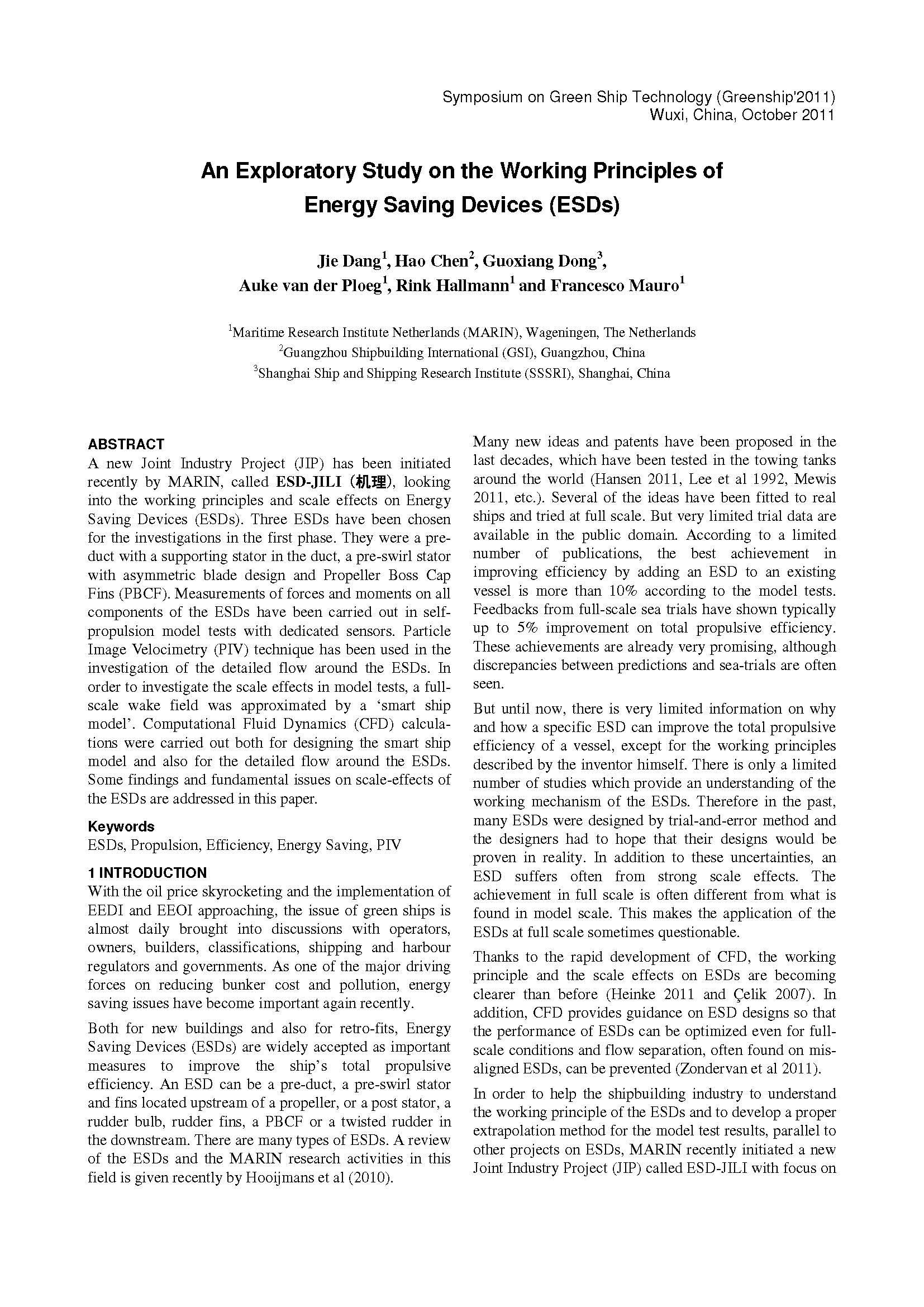
Dang, Jie; Chen, Hao; Dong, Guoxiang; van der Ploeg, Auke; Hallmann, Rink; Mauro, Francesco
An Exploratory Study on the Working Principles of Energy Saving Devices (ESDs) Conference
Symposium on Green Ship Technology, Wuxi, China, October 201, Greenship'2011 2011.
Abstract | Links | BibTeX | Tags: CFD, duct, efficiency, Energy Saving Device, ESD, ESD-JILI, PBCF, PIV, stator
@conference{Dang2011,
title = {An Exploratory Study on the Working Principles of Energy Saving Devices (ESDs)},
author = {Jie Dang and Hao Chen and Guoxiang Dong and Auke van der Ploeg and Rink Hallmann and Francesco Mauro},
url = {http://www.marin.nl/web/News/News-items/An-Exploratory-Study-on-the-Working-Principles-of-Energy-Saving-Devices-ESDs.htm},
year = {2011},
date = {2011-10-01},
booktitle = {Symposium on Green Ship Technology, Wuxi, China, October 201},
organization = {Greenship'2011},
abstract = { new Joint Industry Project (JIP) has been initiated recently by MARIN, called ESD-JILI (机理), looking into the working principles and scale effects on Energy Saving Devices (ESDs).
Three ESDs have been chosen for the investigations in the first phase. They were a preduct with a supporting stator in the duct, a pre-swirl stator with asymmetric blade design and Propeller Boss Cap Fins (PBCF). Measurements of forces and moments on all components of the ESDs have been carried out in selfpropulsion model tests with dedicated sensors. Particle Image Velocimetry (PIV) technique has been used in the investigation of the detailed flow around the ESDs. In order to investigate the scale effects in model tests, a fullscale wake field was approximated by a ‘smart ship model’. Computational Fluid Dynamics (CFD) calculations were carried out both for designing the smart ship model and also for the detailed flow around the ESDs. Some findings and fundamental issues on scale-effects of the ESDs are addressed in this paper. },
keywords = {CFD, duct, efficiency, Energy Saving Device, ESD, ESD-JILI, PBCF, PIV, stator},
pubstate = {published},
tppubtype = {conference}
}
Three ESDs have been chosen for the investigations in the first phase. They were a preduct with a supporting stator in the duct, a pre-swirl stator with asymmetric blade design and Propeller Boss Cap Fins (PBCF). Measurements of forces and moments on all components of the ESDs have been carried out in selfpropulsion model tests with dedicated sensors. Particle Image Velocimetry (PIV) technique has been used in the investigation of the detailed flow around the ESDs. In order to investigate the scale effects in model tests, a fullscale wake field was approximated by a ‘smart ship model’. Computational Fluid Dynamics (CFD) calculations were carried out both for designing the smart ship model and also for the detailed flow around the ESDs. Some findings and fundamental issues on scale-effects of the ESDs are addressed in this paper.
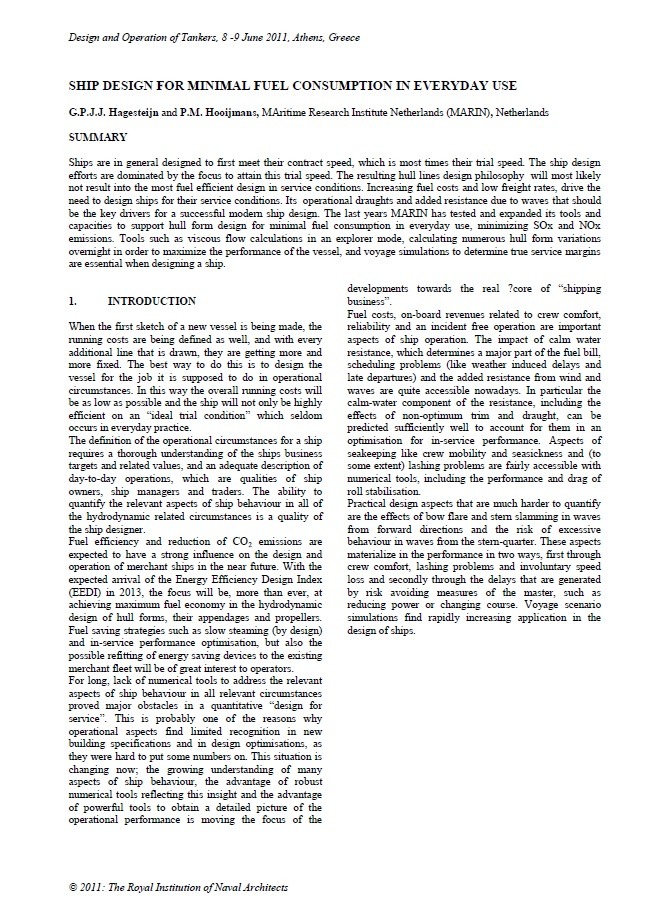
Hagesteijn, Gerco; Hooijmans, Patrick
Ship Design for Minimal Fuel Consumption in Everyday Use Conference
Design and Operation of Tankers, Athens, Greece, The Royal Institution of Naval Architects 2011.
Abstract | Links | BibTeX | Tags: added resistance in waves, Design for service, Fuel consumption, speed loss, voyage simulation
@conference{Hagesteijn2011,
title = {Ship Design for Minimal Fuel Consumption in Everyday Use},
author = {Gerco Hagesteijn and Patrick Hooijmans},
url = {http://www.marin.nl/web/Publications/Publication-items/Ship-Design-for-Minimal-Fuel-Consumption-in-Everyday-Use.htm
http://www.rina.org.uk/search_publications.html
},
year = {2011},
date = {2011-06-08},
booktitle = {Design and Operation of Tankers, Athens, Greece},
organization = {The Royal Institution of Naval Architects},
abstract = {Ships are in general designed to first meet their contract speed, which is most times their trial speed. The ship design efforts are dominated by the focus to attain this trial speed. The resulting hull lines design philosophy will most likely not result into the most full efficient design in service conditions. Increasing fuel costs and low freight rates drive the need to design ships for their service conditions. It's operational draughts and added resistance due to waves that should be the key drivers for a successful modern ship design. The last years MARIN has tested and expanded its tools and capacities to support hull form design for minimal fuel consumption in everyday use, minimizing SOx and NOx emissions. Tools suchs as viscous flow calculations in an explorer mode, calculating numerous hull form variations overnight in order to maximize the performance of the vessel, and voyage simulations to determine true service margins are essential when designing a ship.},
keywords = {added resistance in waves, Design for service, Fuel consumption, speed loss, voyage simulation},
pubstate = {published},
tppubtype = {conference}
}
2010
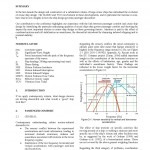
Reint Dallinga, J E Bos
Cruise ship seakeeping and passenger comfort Conference
International Conference On Human Performance at Sea, Glasgow, Scotland, United Kingdom, HPAS 2010.
Abstract | Links | BibTeX | Tags: accelerations, comfort, cruise, ferries, motions, passengers, seakeeping
@conference{Dallinga2010,
title = {Cruise ship seakeeping and passenger comfort},
author = {Reint Dallinga, J E Bos},
url = {http://www.marin.nl/web/Publications/Publication-items/Cruise-ship-seakeeping-and-passenger-comfort.htm},
year = {2010},
date = {2010-06-16},
booktitle = {International Conference On Human Performance at Sea, Glasgow, Scotland, United Kingdom},
organization = {HPAS},
abstract = {In the last decade the design and construction of a substantial volume of large cruise ships has stimulated the evolution of cruise ship design. The MARIN and TNO involvement in these developments, and in particular the increase in size, have lead to new insights in how the ship design governs passenger discomfort.
Our contribution to the conference highlights our experience with the link between passenger comfort and cruise ship design by identifying the particular seakeeping qualities of cruise ships that govern passenger comfort and showing the impact the most important choices in cruise ship design on these governing factors. Attention is paid to the effect of combined motions and roll stabilisation on seasickness, the discomfort introduced by slamming induced whipping and to postural stability.},
keywords = {accelerations, comfort, cruise, ferries, motions, passengers, seakeeping},
pubstate = {published},
tppubtype = {conference}
}
Our contribution to the conference highlights our experience with the link between passenger comfort and cruise ship design by identifying the particular seakeeping qualities of cruise ships that govern passenger comfort and showing the impact the most important choices in cruise ship design on these governing factors. Attention is paid to the effect of combined motions and roll stabilisation on seasickness, the discomfort introduced by slamming induced whipping and to postural stability.
2008
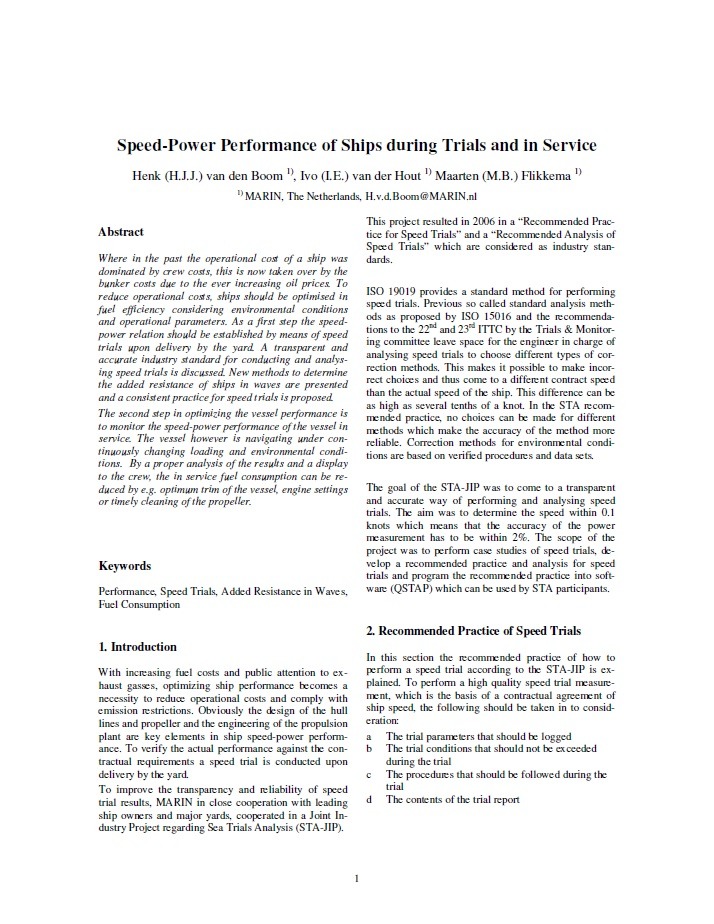
van den Boom, Henk; van der Hout, Ivo; Flikkema, Maarten
Speed-Power Performance of Ships during Trials and in Service Conference
Greek Section 2nd International Symposium on Ship Operations, Management & Economics, SNAME, 2008.
Abstract | Links | BibTeX | Tags: full scale, STA JIP, trial
@conference{Boom2018,
title = {Speed-Power Performance of Ships during Trials and in Service},
author = {Henk van den Boom and Ivo van der Hout and Maarten Flikkema},
url = {http://www.marin.nl/web/JIPs-Networks/Public/STA.htm
http://www.sname.org/home
http://www.staimo.com/},
year = {2008},
date = {2008-01-09},
booktitle = {Greek Section 2nd International Symposium on Ship Operations, Management & Economics},
journal = {SNAME 2008},
publisher = {SNAME},
abstract = {Where in the past the operational cost of a ship was dominated by crew costs, this is now taken over by the bunker costs due to the ever increasing oil prices. To reduce operational costs, ships should be optimised in fuel efficiency considering environmental conditions and operational parameters. As a first step the speedpower relation should be established by means of speed trials upon delivery by the yard. A transparent and accurate industry standard for conducting and analysing speed trials is discussed. New methods to determine the added resistance of ships in waves are presented and a consistent practice for speed trials is proposed. The second step in optimizing the vessel performance is to monitor the speed-power performance of the vessel in
service. The vessel however is navigating under continuously changing loading and environmental conditions. By a proper analysis of the results and a display to the crew, the in service fuel consumption can be reduced by e.g. optimum trim of the vessel, engine settings or timely cleaning of the propeller.},
keywords = {full scale, STA JIP, trial},
pubstate = {published},
tppubtype = {conference}
}
service. The vessel however is navigating under continuously changing loading and environmental conditions. By a proper analysis of the results and a display to the crew, the in service fuel consumption can be reduced by e.g. optimum trim of the vessel, engine settings or timely cleaning of the propeller.
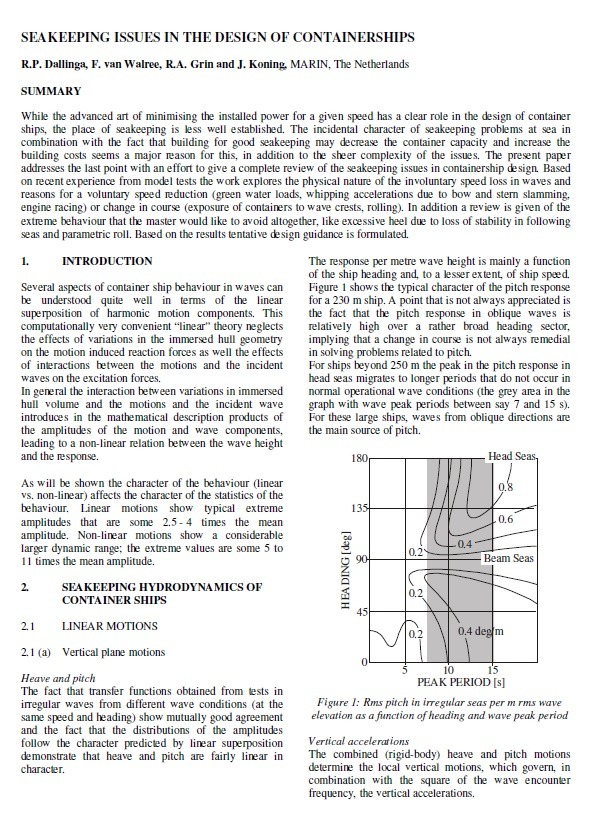
Dallinga, Reint; van Walree, Frans; Grin, Rob; Koning, Jos
Seakeeping issues in the design of containerships Conference
Design & Operation of Container Ships 2008, The Royal Institute of Naval Architects 2008.
Abstract | Links | BibTeX | Tags: added resistance in waves, containerships, Design for service, motions, seakeeping, speed loss
@conference{Dallinga2008,
title = {Seakeeping issues in the design of containerships},
author = {Reint Dallinga and Frans van Walree and Rob Grin and Jos Koning},
url = {http://www.marin.nl/web/Publications/Papers/Seakeeping-issues-in-the-design-of-containerships.htm
http://www.rina.org.uk/search_publications.html},
year = {2008},
date = {2008-01-01},
booktitle = {Design & Operation of Container Ships 2008},
organization = {The Royal Institute of Naval Architects},
abstract = {While the advanced art of minimising the installed power for a given speed has a clear role in the design of container ships, the place of seakeeping is less well established. The incidental character of seakeeping problems at sea in combination with the fact that building for good seakeeping may decrease the container capacity and increase the building costs seems a major reason for this, in addition to the sheer complexity of the issues. The present paper
addresses the last point with an effort to give a complete review of the seakeeping issues in containership design. Based on recent experience from model tests the work explores the physical nature of the involuntary speed loss in waves and reasons for a voluntary speed reduction (green water loads, whipping accelerations due to bow and stern slamming, engine racing) or change in course (exposure of containers to wave crests, rolling). In addition a review is given of the extreme behaviour that the master would like to avoid altogether, like excessive heel due to loss of stability in following seas and parametric roll. Based on the results tentative design guidance is formulated.},
keywords = {added resistance in waves, containerships, Design for service, motions, seakeeping, speed loss},
pubstate = {published},
tppubtype = {conference}
}
addresses the last point with an effort to give a complete review of the seakeeping issues in containership design. Based on recent experience from model tests the work explores the physical nature of the involuntary speed loss in waves and reasons for a voluntary speed reduction (green water loads, whipping accelerations due to bow and stern slamming, engine racing) or change in course (exposure of containers to wave crests, rolling). In addition a review is given of the extreme behaviour that the master would like to avoid altogether, like excessive heel due to loss of stability in following seas and parametric roll. Based on the results tentative design guidance is formulated.
2007
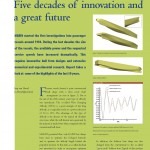
van Heerd, Jaap
Five decades of innovation and a great future Journal Article
In: MARIN Report, no. 90, pp. 10, 2007.
Abstract | Links | BibTeX | Tags: comfort, cruise, ferries, maneuvering, passengers, powering, seakeeping
@article{vanHeerd2007,
title = {Five decades of innovation and a great future},
author = {Jaap van Heerd},
url = {http://www.marin.nl/web/Publications/MARIN-Report/All-issues/MARIN-Report-2007/Five-decades-of-innovation-and-a-great-future.htm},
year = {2007},
date = {2007-02-01},
journal = {MARIN Report},
number = {90},
pages = {10},
abstract = {MARIN started the first investigations into passenger vessels around 1950. During the last decades the size of the vessels, the available power and the requested service speeds have increased dramatically. This requires innovative hull form designs and extensive numerical and experimental research. Report takes a look at some of the highlights of the last 50 years.},
keywords = {comfort, cruise, ferries, maneuvering, passengers, powering, seakeeping},
pubstate = {published},
tppubtype = {article}
}
2005
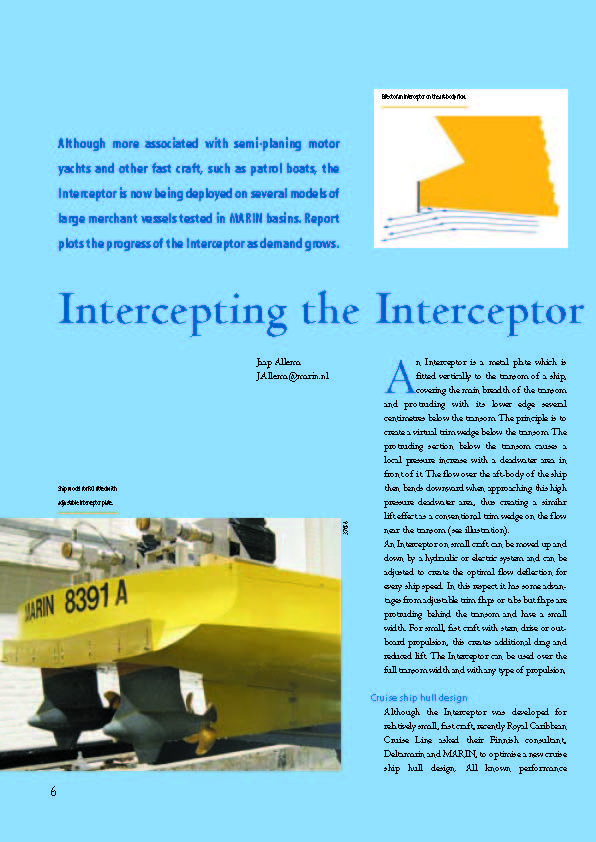
Allema, Jaap
Intercepting the Interceptor Journal Article
In: MARIN Report, no. 86, pp. 6, 2005.
Abstract | Links | BibTeX | Tags: aft body, cruise, Energy Saving Device, ESD, Fuel consumption, interceptor, resistance
@article{Allema2005,
title = {Intercepting the Interceptor},
author = {Jaap Allema},
url = {http://www.marin.nl/web/Publications/Publication-items/Intercepting-the-Interceptor-at-MARIN.htm},
year = {2005},
date = {2005-09-01},
journal = {MARIN Report},
number = {86},
pages = {6},
abstract = {Although more associated with semi-planing motoryachts and other fast craft,such as patrol boats,theInterceptor is now being deployed on several models oflarge merchant vessels tested in MARIN basins.Reportplots the progress of the Interceptor as demand grows.},
keywords = {aft body, cruise, Energy Saving Device, ESD, Fuel consumption, interceptor, resistance},
pubstate = {published},
tppubtype = {article}
}

